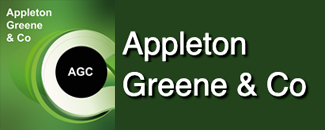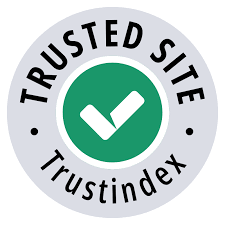Destination Resilience – Workshop 1 (Roadmap to Resilience)

The Appleton Greene Corporate Training Program (CTP) for Destination Resilience is provided by Mr. Wetter Certified Learning Provider (CLP). Program Specifications: Monthly cost USD$2,500.00; Monthly Workshops 6 hours; Monthly Support 4 hours; Program Duration 12 months; Program orders subject to ongoing availability.
If you would like to view the Client Information Hub (CIH) for this program, please Click Here
Learning Provider Profile

Mr. Wetter holds a Master’s Degree in Business Management from Münster University, Germany. Before he founded his Management Holding, he looked back on a successful career in Europe. During the last 20 years he gained major experiences in several industries. As leading manager, he worked in the Consumer and Media Industry for Top-Management. Since the last years, he specializes in Cyber Security Management and serves as a Lieutenant Colonel in the German Armed Forces Reserve, Cyber Command. As a pilot he loves to travel fast, he embraces lifelong teaching and learning, guided by the motto:
“semper gradum praemisit – always one step ahead”
MOST Analysis
Mission Statement
The roadmap to resilience starts with the definition of resilience itself. Key performance indicators and measurements will be discussed and set into the context of your company. Understanding the general resilience cycle is key for any further discussion and will help your team in any case, whether it is business or just for living. During the second part of the first module, we will focus on cyber resilience and break it down. Therefore, we need to discuss different types of cyber threats and areas of protection like trust, integrity and authentication. With the Sony Picture Case we will analyze how a cyberattack effects companies and which critical stages a company must go through. With the practice “analyze areas of mitigations” all candidates will be sensibilized and motivated for the follow up workshops. Each module will end with a short evaluation to adjust the following workshop. We want the roadmap to resilience your individual roadmap and can adapt focus areas from workshop to workshop.
Objectives
01. Resilience Defined: departmental SWOT analysis; strategy research & development. Time Allocated: 1 Month
02. Resilience Cycle: departmental SWOT analysis; strategy research & development. Time Allocated: 1 Month
03. Cybersecurity vs. Cyber Resilience: departmental SWOT analysis; strategy research & development. Time Allocated: 1 Month
04. Anatomy of a Crisis: departmental SWOT analysis; strategy research & development. Time Allocated: 1 Month
05. Resilience Evolution: departmental SWOT analysis; strategy research & development. Time Allocated: 1 Month
06. Organizational Structure: departmental SWOT analysis; strategy research & development. Time Allocated: 1 Month
07. Resilient Command Model: departmental SWOT analysis; strategy research & development. 1 Month
08. Measuring Resilience: departmental SWOT analysis; strategy research & development. Time Allocated: 1 Month
09. Resilience Leadership: departmental SWOT analysis; strategy research & development. Time Allocated: 1 Month
10. Self-Assessment: departmental SWOT analysis; strategy research & development. Time Allocated: 1 Month
11. Strategic Resilience Objectives: departmental SWOT analysis; strategy research & development. Time Allocated: 1 Month
12. Synthesis & Expectations: departmental SWOT analysis; strategy research & development. Time Allocated: 1 Month
Strategies
01. Resilience Defined: Each individual department head to undertake departmental SWOT analysis; strategy research & development.
02. Resilience Cycle: Each individual department head to undertake departmental SWOT analysis; strategy research & development.
03. Cybersecurity vs. Cyber Resilience: Each individual department head to undertake departmental SWOT analysis; strategy research & development.
04. Anatomy of a Crisis: Each individual department head to undertake departmental SWOT analysis; strategy research & development.
05. Resilience Evolution: Each individual department head to undertake departmental SWOT analysis; strategy research & development.
06. Organizational Structure: Each individual department head to undertake departmental SWOT analysis; strategy research & development.
07. Resilient Command Model: Each individual department head to undertake departmental SWOT analysis; strategy research & development.
08. Measuring Resilience: Each individual department head to undertake departmental SWOT analysis; strategy research & development.
09. Resilience Leadership: Each individual department head to undertake departmental SWOT analysis; strategy research & development.
10. Self-Assessment: Each individual department head to undertake departmental SWOT analysis; strategy research & development.
11. Strategic Resilience Objectives: Each individual department head to undertake departmental SWOT analysis; strategy research & development.
12. Synthesis & Expectations: Each individual department head to undertake departmental SWOT analysis; strategy research & development.
Tasks
01. Create a task on your calendar, to be completed within the next month, to analyze Resilience Defined.
02. Create a task on your calendar, to be completed within the next month, to analyze Resilience Cycle.
03. Create a task on your calendar, to be completed within the next month, to analyze Cybersecurity vs. Cyber Resilience.
04. Create a task on your calendar, to be completed within the next month, to analyze Anatomy of a Crisis.
05. Create a task on your calendar, to be completed within the next month, to analyze Resilience Evolution.
06. Create a task on your calendar, to be completed within the next month, to analyze Organizational Structure.
07. Create a task on your calendar, to be completed within the next month, to analyze Resilient Command Model.
08. Create a task on your calendar, to be completed within the next month, to analyze Measuring Resilience.
09. Create a task on your calendar, to be completed within the next month, to analyze Resilience Leadership.
10. Create a task on your calendar, to be completed within the next month, to analyze Self-Assessment.
11. Create a task on your calendar, to be completed within the next month, to analyze Strategic Resilience Objectives.
12. Create a task on your calendar, to be completed within the next month, to analyze Synthesis & Expectations.
Introduction
Awakening Resilience – The First Step on a Transformational Journey
There are words that echo through every era of history, rising to prominence whenever the world seems to be in flux. In the past, terms like efficiency, innovation, or control were prized above all. Today, in a world defined by sudden shocks, relentless turbulence, and accelerating complexity, a new word has claimed center stage: resilience.
Resilience is not merely a trend. It is a profound shift in how we understand success and survival. Organizations have always faced hardship – fires, floods, wars, economic crises – but never before has the velocity and interdependence of disruption been so pervasive. Our age is shaped by invisible digital threats, supply chains that cross continents, social movements amplified in real time, and natural events that reverberate across the globe. For those leading companies, agencies, and institutions, it has become clear that the future belongs not to those who can predict every risk, but to those who can respond, adapt, recover, and grow, no matter what the world throws at them.
This workshop is your portal into the discipline of resilience. It is the first of a series of intensive one-day workshops, each designed as both a deep dive and a launching pad. On this first day, you will engage with twelve foundational dimensions of resilience, each a doorway to a new way of seeing, thinking, and acting. But the journey does not end when the day is over. What you learn here will be woven into the fabric of your daily reality for a full month, as you and your colleagues apply, test, and refine each lesson within your own teams and functions. In this way, resilience moves from theory to lived experience, from aspiration to action.
The Age of Disruption: Why Resilience, Why Now?
To understand the necessity of resilience, we must first confront the world as it is. Never in history have organizations faced such a relentless barrage of unpredictable events. Just within the past decade, a single cyberattack unleashed from an obscure accounting software in Ukraine brought global shipping giants like Maersk to a halt, demonstrating how a vulnerability in one corner of the world can trigger chaos everywhere. The Sony Pictures Hack became a parable for how gaps in crisis response and leadership can magnify technical incidents into existential threats, laying bare emails, scripts, and the private lives of employees for all the world to see.
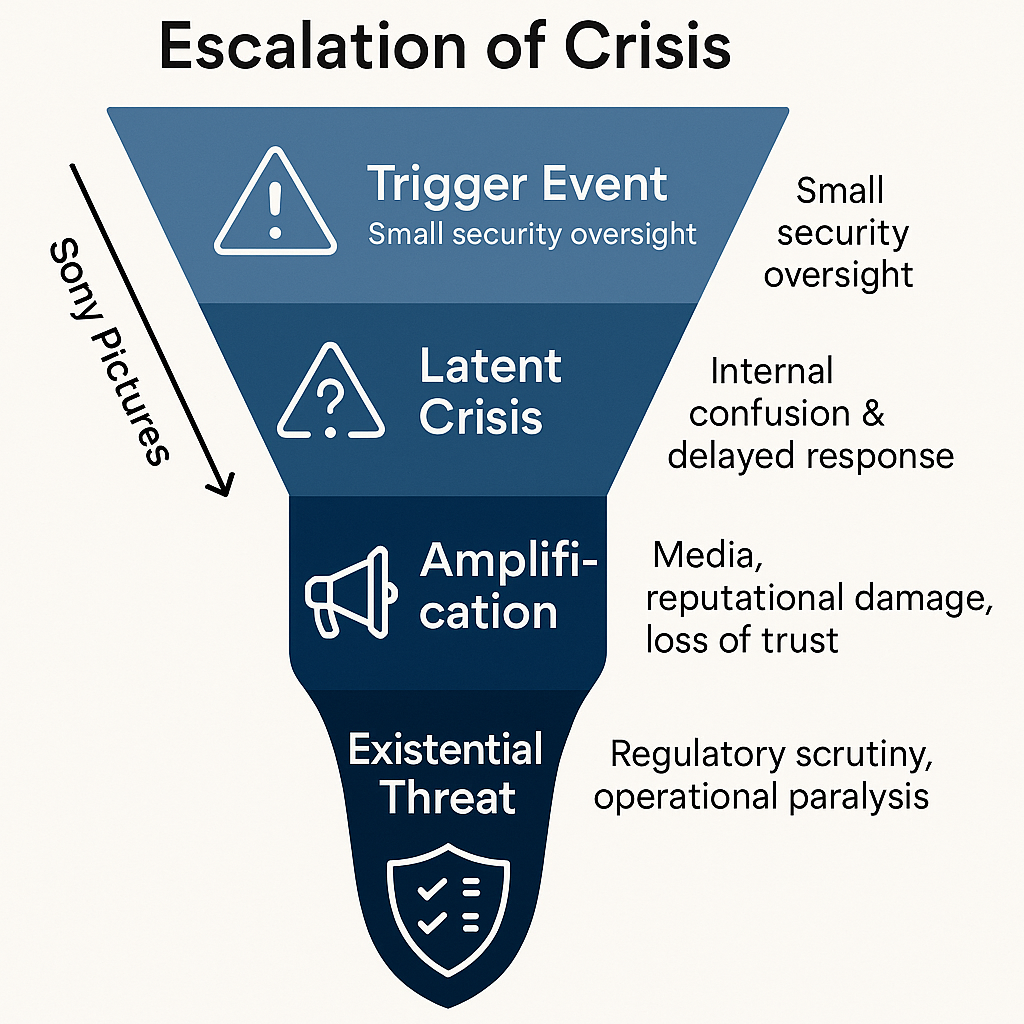
Figure 01: The Sony Pictures Hack – Escalation of a Crisis
Then came the COVID-19 pandemic, which forced organizations large and small to reinvent themselves overnight – sending workforces home, retooling supply chains, upending business models, and requiring leaders to make agonizing decisions with no clear playbook. The world learned that no plan survives first contact with reality, and that resilience is not a luxury, but a matter of existential importance.
Such stories are not exceptions. They are the new normal. Digital transformation means that every organization is now, in some way, a technology company, and with that comes new forms of risk. Climate change, demographic shifts, and social upheavals further ensure that no industry, market, or geography is immune. The days of linear change and incremental improvement are gone. The only constant is surprise.
It is in this crucible that resilience becomes the ultimate competitive advantage. It is the trait that separates those who endure, adapt, and thrive from those who stumble and fade. Resilience is not about bouncing back to where you were; it is about bouncing forward to where you need to be. It is the process of turning crisis into opportunity, of transforming scars into strength.
The Evolution of Resilience: From Battlefield to Boardroom
To appreciate what resilience means today, it helps to look to its origins. In its earliest forms, resilience was born in the crucible of war and disaster. Military strategists learned that the best-laid plans were often rendered obsolete by the fog of conflict, and so they developed doctrines centered on redundancy, flexibility, and rapid improvisation. The concept of “mission command” – giving local commanders the authority and intent to adapt as situations changed – became a hallmark of resilient armies.
As societies industrialized, resilience found its way into the design of bridges, buildings, and critical infrastructure. Engineers spoke of “fail-safe” systems, backup generators, and the importance of learning from every accident or collapse. Civil defence agencies practiced for scenarios that were unthinkable – nuclear attack, chemical spills, widespread floods – because they knew that hope was not a strategy.
With the rise of global business, these lessons migrated into the language of the boardroom. Suddenly, organizations realized they were only as strong as their weakest link, as adaptable as their most empowered frontline worker. They began to invest in business continuity, disaster recovery, and risk management. But for many, these efforts remained siloed and static, focused on compliance and checklists rather than on living, breathing capability.
The digital revolution upended everything again. Cyber risk could cross borders at the speed of light. Brand reputation could be destroyed with a single viral video. Traditional crisis response was found wanting; agility, learning, and adaptability became the new watchwords. Today, the most advanced organizations understand that resilience is not a function or a department, but a mindset and a muscle – one that must be exercised and renewed at every level.
Setting the Stage: The Workshop as a Living Laboratory
This first workshop is not a lecture, a briefing, or a compliance exercise. It is an invitation to roll up your sleeves, confront uncomfortable truths, and begin the real work of building resilience – together. Each of the twelve topics you will engage with has been chosen because it represents an essential pillar in the architecture of organizational resilience.
You will begin by exploring the true meaning of resilience – not just as a technical capacity, but as a living force shaped by meaning, mindset, and mission. You will reflect on what matters most in your context, what drives your team in moments of stress, and how your mission can become a north star in times of uncertainty. You will then move into the systemic perspective, learning to see resilience not as a single event or achievement, but as a cycle – a process of prevention, preparation, response, recovery, and assessment, where each stage feeds and strengthens the next.
In dissecting the boundary between cybersecurity and cyber resilience, you will see that prevention is essential, but adaptation and recovery are what truly matter when (not if) defences are breached. The escalation of crisis will be mapped, showing how small disruptions, if mishandled, can grow into existential threats. Through real-life stories like the Sony Pictures incident, you will witness how hesitation, unclear roles, and fragmented communications can amplify harm, and how disciplined leadership can contain it.
The workshop will ground you in the origins of resilience, tracing its evolution from military doctrine – where after-action reviews, mission command, and rapid learning were born – into the realm of business, where scenario planning, cross-functional teams, and continuous improvement now reign. You will analyse your own organization’s structure, examining the strengths and gaps in governance, reporting lines, and crisis team design. The challenge is to ensure that every person knows their role when the stakes are highest, and that the organization can scale its response as needed.
Measurement will become your ally, not your adversary. You will learn how to diagnose your current maturity, select meaningful KPIs, and conduct diagnostic assessments that reveal not only technical gaps, but also weaknesses in culture, decision-making, and leadership. Case studies from shipping, finance, and critical infrastructure will provide templates for turning numbers into narratives and dashboards into decisions.
Perhaps most crucially, you will explore the cultural and leadership dimensions of resilience. Here, you will reflect on how tone from the top shapes behaviour on the ground, how psychological safety enables teams to surface problems early, and how learning from failure can be embedded as a source of strength. Through structured self-assessment, you will identify your current state – strengths to be leveraged, blind spots to be addressed. The setting of strategic objectives will move you from insight to action, ensuring that every lesson is translated into concrete priorities and guiding principles.
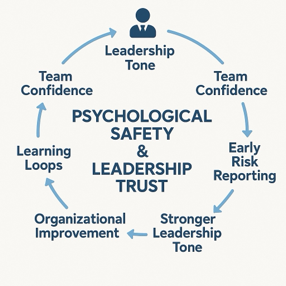
Figure 02: Psychological Safety & Leadership Trust
The closing chapter of the workshop weaves these threads together. Through synthesis and orientation, you will connect the dots, see the system as a whole, and set expectations for the month of practical application that follows. The goal is not to emerge with a binder full of notes, but with a living blueprint – a plan for testing, refining, and embedding resilience as you return to your day-to-day responsibilities.
The Month that Follows: From Workshop to Real-World Application
Learning does not stop when the workshop day ends. In fact, the most powerful phase of growth begins as you step back into your real-world environment. Over the next month, you are called to act – not as a passive recipient of training, but as an agent of change.
Each module’s insights will become a set of living experiments. You might revisit your mission statement, using new language to rally your team. Perhaps you will conduct a tabletop exercise, simulating the escalation of a crisis and observing how your structure, communication, and decision-making hold up. You may initiate a diagnostic assessment, discovering not only technical vulnerabilities but also gaps in trust or psychological safety. For some, the work may involve drafting new KPIs, building a resilience dashboard, or mapping out a revised escalation path. For others, it may mean having honest conversations about culture, leadership tone, or the unspoken fears that hold people back from surfacing problems.
What makes this month unique is the expectation that you will return – not just with successes, but with challenges, surprises, and lessons learned. The process is cyclical, not linear. You are encouraged to share, reflect, and adapt in partnership with your peers and facilitators. Over time, this cycle of workshop, application, and review will build not only individual competence, but organizational muscle memory – a reflex for resilience that endures.
What You Will Achieve: Personal, Team, and Organizational Transformation
The benefits of this approach are layered and profound. On a personal level, you will develop a new relationship with uncertainty. The workshop and month of application will invite you to move beyond the instinct to avoid or minimize risk, instead learning to confront it directly, extract its lessons, and transform it into fuel for growth. You will hone your capacity for adaptive leadership, clear communication, and decision-making under pressure – skills that transcend any single role or crisis.
For your team, the journey becomes an opportunity to build trust, alignment, and shared language. As you work through the modules together, silos will begin to dissolve, unspoken assumptions will be surfaced, and a new level of clarity about roles, responsibilities, and escalation will take hold. Teams that learn resilience together discover that they can act with greater unity and effectiveness, even in the face of the unknown.
At the organizational level, you will gain the tools to diagnose your current state, set strategic objectives, and track measurable progress. You will see how resilience becomes a source of competitive advantage – winning the confidence of regulators, investors, and customers, and laying the groundwork for sustained innovation and agility. Perhaps most importantly, you will begin the slow but powerful work of cultural transformation, creating a workplace where learning, transparency, and psychological safety are not aspirations, but daily practices.
A Glimpse into the Future: The Evolving Landscape of Resilience
As you begin this journey, it is worth looking ahead to the forces that will shape the resilience agenda in years to come. The digitalization of business and society will only accelerate, making cyber resilience a top priority for organizations of every kind. Artificial intelligence, automation, and big data will create both new opportunities and new risks. Supply chains will become more complex, and the expectations of stakeholders more demanding. Regulatory regimes will evolve, requiring ever more robust evidence of resilience and continuity planning.
But the core truths will remain. No technology, no matter how advanced, can replace the importance of human judgment, adaptive leadership, and a culture of trust. The organizations that thrive will be those that treat resilience not as a compliance issue, but as a strategic capability-one that is practiced, measured, and renewed, month after month and year after year.
The Philosophy and Methodology Behind the Workshop
This program is built on the conviction that resilience is not an innate trait, but a learned discipline. The workshop experience is immersive, experiential, and reflective. It invites you to grapple with real dilemmas, surface your own assumptions, and challenge routine ways of thinking. Case studies, such as those of Maersk and Sony Pictures, will not be presented as distant stories but as mirrors – opportunities to see your own organization’s vulnerabilities and strengths more clearly.
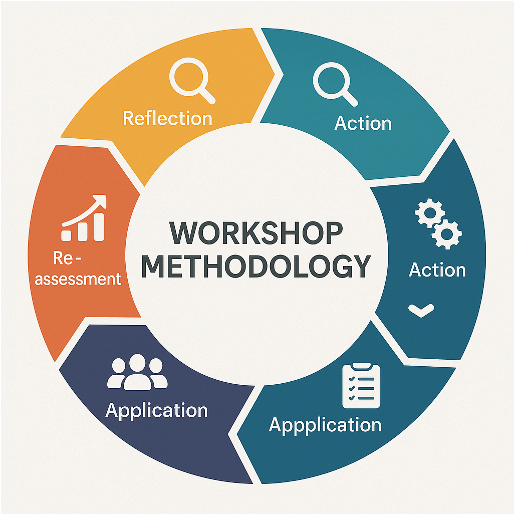
Figure 03: Workshop Methodology
The methodology emphasizes group learning, cross-functional collaboration, and iterative cycles of action and reflection. You will engage in live simulations, scenario planning, diagnostic assessments, and strategic mapping. Reflection will be balanced by action; every insight is tested against the reality of your own context, and every challenge is viewed as a chance to innovate.
The expectation is that you will bring your whole self to the process – your expertise, your questions, your uncertainties, and your hopes for what your organization can become. The facilitators are not here to deliver answers, but to guide a process of discovery, challenge, and renewal.
Who Should Join the Journey
Resilience is not the exclusive domain of senior leaders or crisis managers. While this workshop is designed for executives, functional heads, risk professionals, and emerging leaders, its greatest impact comes when teams participate together – sharing their diverse perspectives and building collective ownership. Every person, regardless of role, contributes to the organization’s ability to see, decide, act, and recover. The program is designed to be inclusive, fostering a sense of shared mission and mutual accountability.
A Personal Invitation: Stepping Into the Arena
This introduction is more than a roadmap. It is an invitation to step into the arena. Resilience is forged not in theory, but in action – when the heat is on, when plans go awry, when leaders and teams are tested. The first workshop day marks the beginning of your organization’s next chapter. Over the coming month, as you apply and extend what you learn, you will find new strengths, uncover blind spots, and begin to create a culture where resilience is both an expectation and a source of pride.
The road ahead will be challenging. There will be false starts, difficult conversations, and unexpected setbacks. But each of these is an opportunity to grow. As you embark on this journey, remember that resilience is not about never falling, but about rising every time you do-wiser, stronger, and more prepared for whatever comes next.
Lessons Learned from Case Studies like the Sony Picture Case will guide you through all workshop modules. The better the transfer to your business the better you will be prepared for the future. The set-up of your company’s internal structure will be key. And that’s where we will shape all the time.
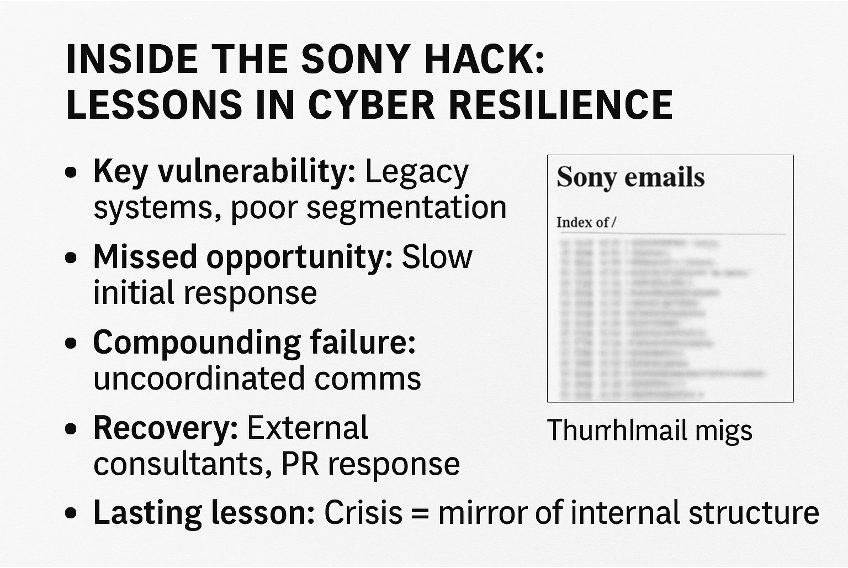
Figure 04: Lessons Learned – e. x. Sony Pictures Hack
Executive Summary
Chapter 1: Resilience Defined
Resilience is the defining capability of organizations that survive and thrive in the modern world. In this foundational chapter, we break down resilience into three inseparable elements: meaning, mindset, and mission. These are not abstract ideals but living forces that shape every decision, every response, and ultimately, every outcome when adversity strikes.
Historical crisis, like in the following infographic show how huge crises can be:
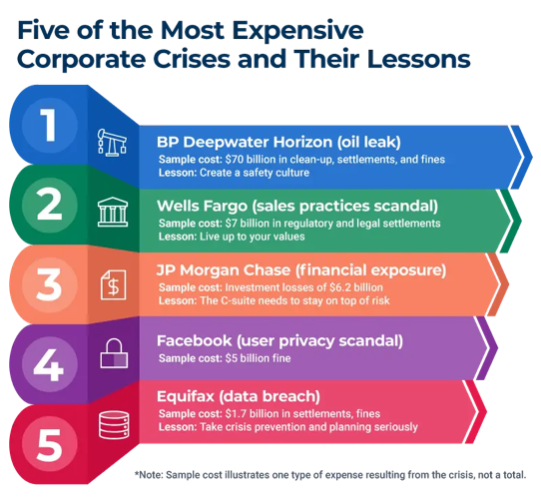
Meaning provides the “why” behind resilience. Organizations with clear meaning understand what truly matters: their core values, their critical assets, and the unique purpose they serve in the market or society. When disruption occurs-be it cyberattack, pandemic, or market collapse-it is meaning that keeps teams focused and motivated. This chapter explores methods to articulate and embed meaning, from leadership communication to value-driven goal setting. Real-world vignettes show how companies with a strong sense of meaning make faster, more effective choices under pressure.
Mindset is the psychological engine of resilience. Drawing on the latest behavioural science, we distinguish between fixed and growth mindsets, exploring how belief systems influence risk-taking, innovation, and learning from failure. Organizations with resilient mindsets foster psychological safety, encourage curiosity, and promote adaptability. In practice, this means not just reacting to crises, but anticipating them, and viewing each setback as a chance to learn and improve. Exercises prompt participants to reflect on their personal and collective mindset, identifying areas where fear of failure or blame culture may hold back resilience.
Mission gives resilience its direction. In a world where threats are unpredictable and constant, mission-driven organizations have a clear “north star” that guides action even when the future is uncertain. This mission is operationalized through strategy, policy, and culture, aligning every layer of the organization toward shared, actionable goals. Through interactive scenarios, participants practice translating mission statements into practical priorities during simulated crises.
Throughout the chapter, case studies like the Sony Pictures cyberattack provide powerful evidence. Sony’s experience illustrated how unclear mission and fragmented meaning led to hesitation, confusion, and increased impact. In contrast, organizations with unified meaning, resilient mindsets, and shared mission managed to contain crises more quickly and use adversity as a catalyst for renewal.
By the end, participants will have a working definition of resilience that is personal, practical, and aligned with their organization’s unique context. This definition will be referenced and deepened throughout the entire workshop journey.
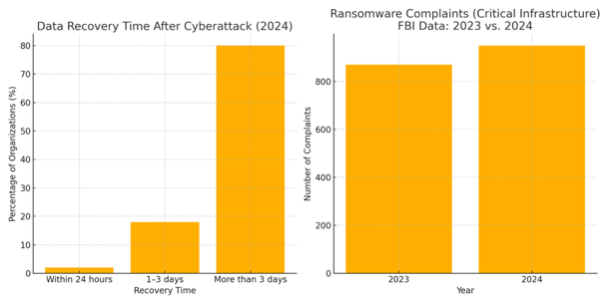
The threat of ransomware continues to escalate, particularly for operators of critical infrastructure. According to the FBI, 2024 saw a 9% increase in ransomware complaints affecting critical infrastructure sectors in the U.S. Nearly half of all ransomware reports submitted to the FBI were linked to this segment, underlining both the growing threat and the urgent need for advanced crisis and resilience planning in essential industries.

Chapter 2: Resilience Cycle
Resilience is not a one-time achievement or a static state. It is an ongoing cycle-a living system that is embedded into the DNA of resilient organizations. This chapter introduces the Resilience Cycle, which underpins every subsequent part of the workshop. Participants learn to see resilience not as a linear process, but as a series of interconnected phases that repeat and reinforce one another.
The Resilience Cycle is typically represented by five interlocking stages: Prevention, Preparation, Response, Recovery, and Assessment. Each stage is distinct, but their value lies in their integration and feedback loops.
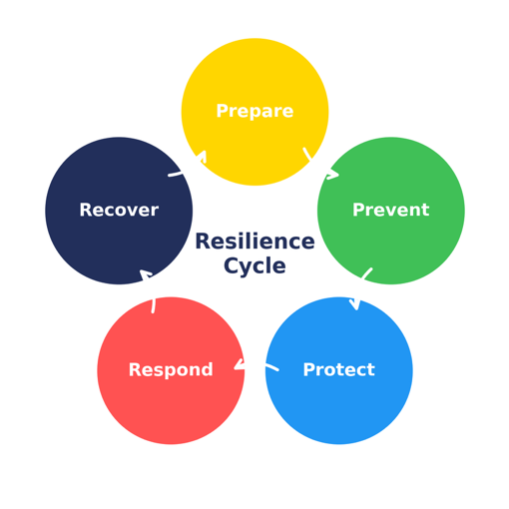
Prevention focuses on early detection and risk mitigation. It’s about building systems, processes, and cultures that are always scanning the horizon for emerging threats. Participants analyse how robust risk sensing, regular audits, and clear communication of “near misses” can prevent minor disruptions from spiralling.
Preparation is about readiness. This includes crisis simulation exercises, training, and establishing protocols so that when the alarm sounds, everyone knows their role. Practical sessions guide participants through scenario planning and resource mapping, showing how gaps in preparation create chaos in later stages.
Response is the phase most visible during a crisis. Here, the quality of communication, decision-making, and leadership are stress-tested. Through live crisis simulations, participants practice rapid escalation, stakeholder management, and adaptive leadership.
Recovery addresses how to restore normal operations, reputations, and stakeholder confidence. Case studies reveal why organizations with documented recovery playbooks and pre-defined recovery teams return to stability faster and with less collateral damage.
Assessment is the final – but never-ending – stage. After-action reviews, debriefs, and lessons-learned sessions ensure that every crisis, whether large or small, becomes an opportunity for organizational growth. Assessment closes the feedback loop, driving improvements in prevention, preparation, and overall culture.
This systemic perspective is made real through the mapping of recent global crises – including Maersk’s NotPetya response and the COVID-19 pandemic – onto the Resilience Cycle. Interactive group work encourages participants to diagnose where their own organizations excel or falter at each stage.
Participants leave this chapter with a practical, cyclical model for embedding resilience across teams, processes, and leadership structures – ready to be adapted to their unique context.

Chapter 3: Cybersecurity vs. Cyber Resilience
Many organizations mistakenly equate cybersecurity with cyber resilience. This chapter unpacks the crucial difference and makes a compelling case for why every modern business must pursue both but never confuse the two.
Cybersecurity is focused on prevention – deploying controls, technologies, and policies to defend against unauthorized access, malware, ransomware, data theft, and other digital threats. It is necessary, but as every expert knows, not sufficient. No cybersecurity program, no matter how well funded or technically advanced, can guarantee 100% protection. Breaches are a matter of “when,” not “if.”
Cyber Resilience, by contrast, is the organization’s capacity to adapt, recover, and learn when those defences are inevitably breached. This includes the ability to restore critical operations, communicate transparently with stakeholders, maintain trust, and prevent a single incident from causing cascading harm.
Through detailed case studies – Sony Pictures, Maersk, and others – participants see that cybersecurity failures can become catastrophic only when resilience is weak. Sony’s breach showed that technical defences were only part of the battle; confusion in crisis communications and lack of recovery plans compounded the impact. Maersk’s swift recovery after NotPetya highlighted the payoff of resilience investments: rapid restoration, strong backup protocols, and empowered crisis teams.
Workshops challenge participants to shift from a fortress mentality (“How do we keep them out?”) to a survival and adaptation mindset (“How do we keep running, even when they get in?”). Exercises include mapping current cybersecurity practices, stress-testing response plans, and identifying single points of failure.
By chapter’s end, the distinction is clear: Cybersecurity is about risk reduction; cyber resilience is about risk survival and recovery. Both are essential for the digital era, and together they form the backbone of a robust organizational strategy.
The infographic below titled “Organizational Performance & Recovery After Adversity” visually illustrates how resilient organizations recover more rapidly and completely after a major disruption compared to non-resilient organizations. Both groups experience a sharp initial drop in performance following a crisis, but the resilient organization (represented by the solid orange line) demonstrates a steady and robust recovery, quickly returning to pre-crisis performance levels. In contrast, the non-resilient organization (shown by the dashed orange line) recovers much more slowly and never fully regains its original performance, highlighting the lasting impact of insufficient resilience. This visualization underscores the core value of investing in organizational resilience as a means to ensure faster, more effective recovery from unexpected challenges.
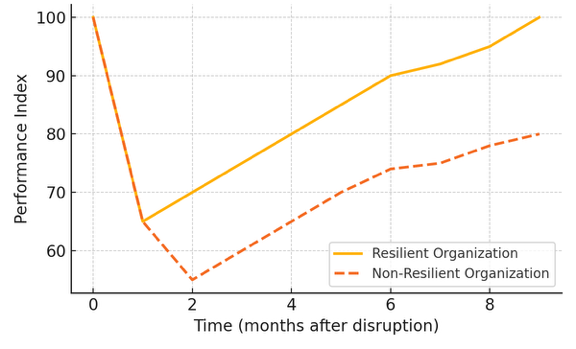

Chapter 4: Anatomy of a Crisis
One of the most vivid and instructive cases that will accompany us throughout this workshop is the cyberattack on Sony Pictures Entertainment in 2014. This case, which we will analyse in detail during the module on the anatomy of a crisis, embodies many of the themes explored across the twelve chapters-from the nature of organizational resilience and the pitfalls of siloed crisis response to the imperative for clear leadership, strategic communications, and measurable improvement.
The Sony Pictures breach was more than just a headline-grabbing event; it was a defining moment in modern resilience thinking. The attack unfolded rapidly, exposing not only technical vulnerabilities but also deeper organizational weaknesses: unclear roles, fragmented escalation, and a lack of rehearsed crisis management routines. As the breach escalated, it became painfully clear how critical it is for organizations to move beyond traditional cybersecurity and develop true cyber resilience. Sony’s journey – from initial shock and confusion to public scrutiny and, ultimately, to hard-earned recovery – mirrors the resilience cycle we will study. The lessons learned from this crisis highlight the interconnectedness of governance, culture, leadership, and strategic foresight.
By integrating the Sony Pictures case study, this workshop invites participants to move beyond theory and abstraction, engaging directly with the decisions, dilemmas, and consequences faced in high-stakes real-world crises. Through group analysis, scenario exercises, and structured reflection, you will have the opportunity to see how the principles of resilience apply under pressure, and to translate these lessons into actionable strategies for your own organization. In doing so, we not only learn from the past but equip ourselves for the challenges ahead, making resilience a lived, practiced capability – not just an aspiration.
Course Manual 4 explores the dynamic and often misunderstood nature of crises. The central premise is that a crisis rarely appears fully formed; it escalates through recognizable stages that must be understood to build real organizational resilience. Far from being isolated events, crises are evolving processes shaped by internal responses just as much as external pressures. The ability to detect early signals, act decisively, and maintain coordinated leadership during high-stress moments determines whether a disruption becomes a disaster-or an opportunity for learning and growth.
The manual begins by emphasizing that crisis is a process, not a moment. A minor disruption-be it a technical glitch, suspicious behaviour, or system anomaly-can rapidly evolve into a full-blown organizational emergency. This evolution is governed by escalation: the step-by-step intensification of impact, visibility, and emotional strain. Crucially, this escalation is not just about what happens externally, but also how organizations respond internally. Failure to recognize early signals, delayed decisions, or unclear roles can allow a minor issue to spiral into a major crisis.
Understanding the anatomy of a crisis means identifying the phases that most crises follow. The manual outlines six key stages:
Disruption: This is the initial trigger-the moment when something breaks or behaves unexpectedly. Often, early signs are subtle or ambiguous. A delay in response, uncertainty about the severity, or miscommunication can turn what could have been a manageable incident into a much larger problem. Resilient organizations take disruption seriously from the outset-investigating and escalating early without overreacting.
Escalation: If the disruption is not addressed properly, the situation worsens. Systems degrade further, stakeholders are impacted, and what began as a technical or operational problem becomes a strategic and reputational crisis. During escalation, responsibility expands. More leaders, departments, and external actors become involved. The crisis grows in scope, speed, and stakes-requiring a shift from tactical problem-solving to strategic crisis management.
Confusion: As pressure mounts, communication can break down. Roles become unclear, assumptions proliferate, and emotional responses such as fear or blame complicate decision-making. This phase is where many avoidable mistakes happen-not from incompetence, but from a lack of preparation or psychological safety. Strong leadership at this point is not about having the right answers, but about creating clarity, calm, and cohesion. Communication must be structured and consistent.
Visibility: Once the crisis becomes public-whether through media coverage, customer complaints, or regulatory scrutiny-the organization enters a new arena. Now, how it responds is just as important as what happened. Visibility magnifies impact and attracts attention. Leadership must act with transparency and professionalism, ensuring that public communications reflect integrity and control. Legal and public relations teams often step in here to help frame the response.
Decision: Every crisis includes key decision points-moments where leaders must act boldly, under pressure, and with limited information. These decisions may involve disclosure, shutdowns, or public acknowledgments. What matters is that decision-making authority is clear and supported by guiding principles. Crisis-ready organizations prepare in advance by clarifying who decides what, under which circumstances, and according to what values.
Aftermath: Once the immediate crisis passes, the organization must transition from response to recovery. This is the moment for learning, reflection, and change. Without intentional effort, organizations either forget (losing valuable lessons) or freeze (trapped by fear of recurrence). True resilience is built in this phase-by examining vulnerabilities, honoring those who stepped up, and embedding lessons into new protocols and culture.
The manual’s deeper insight is that crisis escalation is a pattern-not a surprise. While no two crises are identical, most follow similar trajectories. Recognizing this allows organizations to prepare in advance, act earlier, and avoid the most damaging missteps. The emphasis is on developing a shared language for crisis stages, practicing through simulations, and ensuring that leadership structures can flex under pressure.
A real-world case study-the 2014 Sony Pictures Entertainment hack-illustrates these principles vividly. The attack, perpetrated by a nation-state actor, escalated over weeks. Early anomalies were missed, communication was fragmented, and response decisions lagged behind the speed of the threat. As data was exfiltrated and later published, Sony faced not just technical shutdowns, but reputational harm, employee distress, and geopolitical consequences. The company’s response became a case study in delayed recognition, leadership strain, and public fallout.
An additional fictional case study, “Friday Afternoon,” presents a more typical corporate crisis. A minor incident-unauthorized access to financial records-is ignored over the weekend, only to explode into a reputational and technical nightmare by the following Friday. The point is clear: escalation happens not only because of threat actors, but because of delayed action, unclear roles, and siloed thinking.
In conclusion, Course Manual 4 reframes crisis management not as fire-fighting, but as a leadership discipline rooted in pattern recognition, role clarity, and timely, values-based decisions. It is not about avoiding all disruptions, but about knowing what to do when disruptions come. Organizations that train for crisis escalation, foster open communication, and learn from the past are not just reactive-they’re resilient.
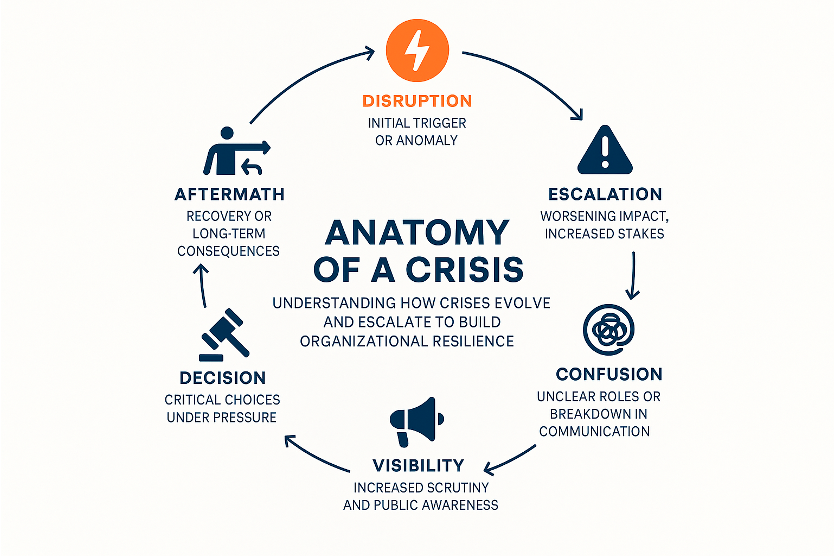

Chapter 5: Resilience Evolution
Resilience is more than a buzzword. It has become one of the most referenced yet misunderstood terms in modern organizational discourse. Governments pledge to build it, consultants market it, executives cite it, and entire industries claim to need more of it. But while the term is ubiquitous, its depth is often lost in metaphor. Too often, it is reduced to vague ideas of “bouncing back” or “staying strong.” This course manual restores meaning to resilience by tracing its multidisciplinary roots, historical evolution, and current strategic importance in a world defined by volatility, disruption, and interconnected risks.
At its essence, resilience is not simply an emotional state or motivational slogan. It is a structural and functional capability-an organization’s ability to absorb shocks, maintain core functions, and adapt under stress. The manual starts by identifying the origins of the word, from the Latin resilire, meaning to rebound or spring back. In early physics and engineering, this referred to materials that could absorb energy and return to their shape. The steel rod that bends but doesn’t break; the suspension bridge that flexes in a storm. This logic of endurance through flexibility is the conceptual foundation for all later understandings of resilience.
However, as systems became more complex and uncertainty more pervasive, resilience evolved from a physical property to a systems principle. One of the first major sectors to embrace this shift was the military. In the fog of war, nothing goes to plan. Military strategists realized that survivability hinged not on avoiding disruption, but on continuing the mission despite it. The modern doctrines of mission command, decentralized leadership, scenario-based planning, and rapid improvisation all stem from this understanding. Resilience, in the military context, was about redundancy, adaptability, and psychological readiness-not control, but continuity under chaos.
This military mindset later influenced national emergency management systems, shaping how countries prepare for crises such as terrorism, natural disasters, or cyberattacks. But parallel to this, another lineage emerged: ecological resilience. In 1973, Canadian ecologist C.S. Holling redefined resilience not as resistance to change, but as a system’s ability to reorganize and recover without losing its core function or identity. In ecosystems, disruption is natural. Forests burn, rivers flood, populations decline. But resilient systems adapt-they change form while preserving structure. This perspective deeply influenced urban planning, disaster risk reduction, and climate adaptation.
Cities, like ecosystems, are systems under pressure. They require resilience to withstand infrastructure failure, extreme weather, social unrest, and economic shocks. Urban resilience planning involves diversification of energy grids, decentralization of transport networks, cross-functional governance, and community cohesion. The shift in thinking-from trying to prevent all disruptions to building systems that adapt and bounce forward-is a hallmark of the ecological approach to resilience.
Meanwhile, psychology brought resilience into the realm of the individual. Studying trauma survivors, childhood development, and mental health, researchers found that some individuals not only survive adversity but grow from it. Resilience here was not innate toughness, but the ability to find meaning, maintain agency, regulate emotion, and access support. Critically, resilience was not seen as a fixed trait-it was a process that could be cultivated. This insight changed leadership development, employee wellbeing programs, and team performance models across sectors.
By the early 2000s, resilience had arrived in the corporate world through risk management and cybersecurity. As businesses grew more dependent on digital systems, it became clear that technical defences alone were insufficient. Cyberattacks, data breaches, system failures, and insider threats exposed organizations to risks that couldn’t always be prevented. This gave rise to cyber resilience-the capability not just to stop threats, but to detect them early, respond effectively, and recover quickly. Firewalls became necessary but not sufficient. Crisis teams, tested contingency plans, and recovery protocols became essential.
This shift marked a broader transformation. Resilience became a strategic differentiator. Companies that demonstrated resilience were better able to maintain operations, retain customer trust, and protect reputations during disruptions. Boards began asking different questions-not just “Are we secure?” but “Are we ready?” Resilience moved from the domain of risk officers to the C-suite. Annual reports began referencing resilience as a core pillar of ESG strategy. Investors and regulators began assessing it. Executive KPIs began to reflect it.
Consulting firms and standards bodies responded. They developed resilience maturity models, diagnostic assessments, and capability frameworks. These measured not just technological redundancy, but decision-making agility, leadership trust, cultural preparedness, and cross-silo collaboration. A resilient organization, by these models, wasn’t just one that could recover quickly-it was one that could adapt structurally and emerge stronger.
Across every field explored-military, ecology, psychology, cybersecurity, and corporate strategy-the common thread is adaptive capacity. Resilience is not about returning to “normal.” It is about evolving toward a new equilibrium, one that incorporates lessons, strengthens foundations, and improves future readiness. Resilience is not static. It is dynamic. It requires a mindset of continuous learning and a willingness to lead through uncertainty.
The manual also emphasizes that resilience is both a leadership principle and a cultural attribute. Resilient organizations do not centralize resilience in one department; they embed it across the enterprise. Leaders model calm under pressure, enable rapid decision-making, and foster psychological safety. Teams train for disruption, debrief failures, and align around shared values. The culture prioritizes honesty over blame, learning over perfection, and transparency over control.
A compelling case study reinforces these principles. During a massive ransomware attack that crippled national infrastructure, one regional hospital stood out. While others went offline, this hospital maintained operations-because it had invested in resilience ahead of time. It had conducted cross-functional simulations, clarified escalation paths, tested backups, and prepared staff. When crisis hit, there was no confusion. The hospital functioned because resilience was not an abstract goal-it was a practiced reality.
To help participants apply the lessons of the manual, the included exercise “Mapping Your Resilience Lineage” invites teams to trace their organization’s response to past disruptions. Through timeline-building, group discussion, and reflective analysis, they assess whether past crises led to growth or stagnation. This exercise challenges participants to confront hard truths about their organization’s culture: Do they prepare, improvise, or avoid? What legacy of resilience do they want to build?
In conclusion, resilience is not a trend. It is a necessity. It is not something to be acquired in response to crisis, but something that must be cultivated in advance. In an age of polycrisis-where cyber threats, climate events, political unrest, and economic shocks converge-resilience is what separates decline from durability. It is the connective tissue of future-ready organizations: a mindset, a practice, and a promise to continue-not in spite of disruption, but because of it.
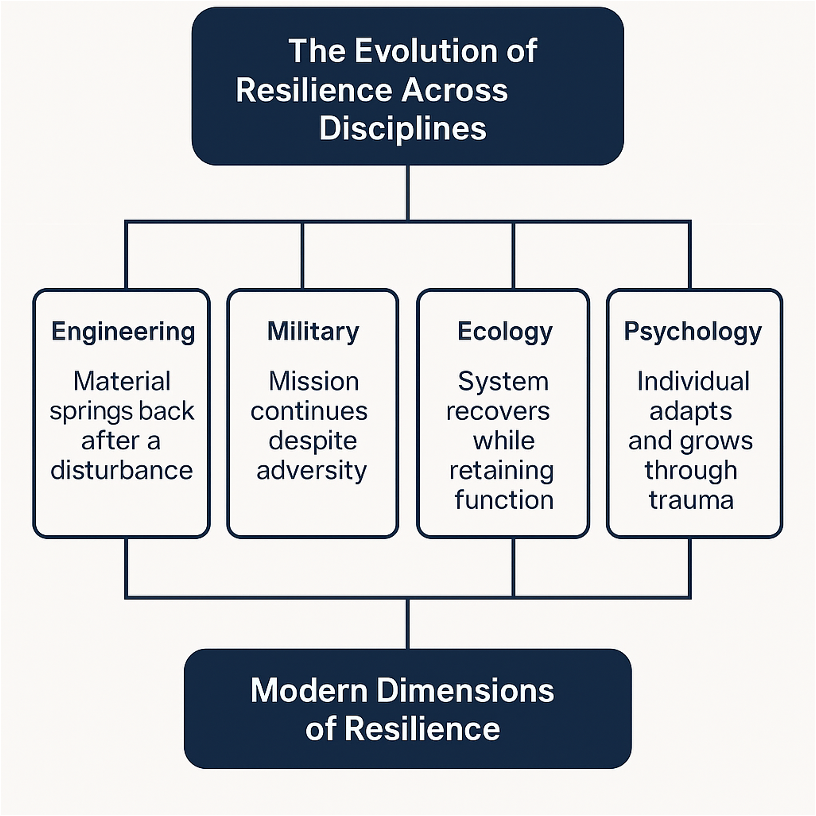

Chapter 6: Organizational Structure
When crisis strikes, it’s not usually the lack of resources that causes the greatest damage-it’s the absence of clarity. Whether the trigger is a cyber breach, natural disaster, operational failure, or reputational threat, the true risk lies in the fog that follows: confusion over roles, responsibilities, authority, and timing. This manual establishes that the most resilient organizations are not the ones with the most resources, but the ones with the clearest structures-living systems of coordination, decision-making, and communication built long before a crisis hits.
The core argument is simple: structure is the skeleton of resilience. It determines how people respond, how decisions are made, and how quickly an organization can pivot under pressure. Good structure is not a set of charts or policies. It is a dynamic architecture of relationships, behaviours, and responsibilities that comes alive during disruption. It is elastic, not rigid-capable of stretching without snapping, adapting without losing coherence.
In everyday operations, structure may be invisible. But under stress, its quality becomes immediately evident. Weak structures collapse under pressure; resilient ones guide the organization through chaos. This manual outlines the components of crisis-ready structure: governance, role clarity, communication flow, and leadership posture.
Governance: The Framework for Decision-Making
Effective governance is the foundation of a functioning crisis structure. It defines how decisions are made, who is accountable, and how authority flows under pressure. In crisis situations, traditional governance structures are often too slow or too centralized to respond adequately. That’s why high-reliability organizations create alternative structures, such as:
• Crisis Management Teams (CMTs)
• Tactical Response Cells
• Emergency Operations Centers (EOCs)
• Resilience Hubs
These bodies operate on faster cycles, with flatter hierarchies and delegated authority. They don’t replace standard governance but form a parallel command structure designed for speed, coordination, and real-time responsiveness.
Governance in resilient organizations is not only functional-it’s also ethical. It ensures that decisions are accountable, transparent, and timely. The goal is not perfection but integrity under pressure.
Role Clarity: Knowing Who Does What
One of the most common failure points in crisis is the absence of role clarity. Organizations often assume people know what to do because their names are on a plan. But in practice, roles may be undefined, alternates may be untrained, and decision rights may be ambiguous.
Resilient organizations address this proactively. They rehearse roles, rotate responsibilities, and clarify expectations before a crisis begins. Every person involved in crisis response should be able to answer:
• What is my task?
• What decisions can I make?
• Who do I report to?
• Who do I support-and who supports me?
In matrixed organizations, the situation is even more complex. People report to multiple leaders, sit on overlapping teams, and carry dual roles. In a crisis, such ambiguity can paralyze action. That’s why temporary, simplified authority lines are often enacted during disruption. For example, an HR director may temporarily report to a unified crisis cell, bypassing traditional reporting for speed and focus.
Communication Flow: Speed, Looping, Redundancy
Communication is the lifeblood of crisis management, and structure determines how that blood flows. Effective reporting lines are short, looped, and agile. They support:
• Upward escalation
• Lateral coordination
• Downward command
This ensures that insights from the field reach decision-makers quickly-and that instructions are returned clearly and promptly. Tools such as dashboards, chat apps, and email alerts help, but resilient organizations don’t rely solely on technology. They stress-test human behaviours behind tools, ensuring backups exist if systems fail.
For instance, printed contact trees, pre-verified escalation paths, and role cards become essential when digital systems go offline-during holidays, night shifts, or widespread outages.
Rhythm and Predictability
In the chaos of crisis, predictable rhythm becomes an anchor. Resilient crisis teams work in time blocks. They may hold check-ins every 30 minutes, issue stakeholder updates every 2 hours, and conduct coordination meetings hourly. These rituals build focus, prevent drift, and create psychological safety. A consistent rhythm supports momentum and limits stress.
Leadership: Posture and Distribution
Leadership is the center of crisis structure-but not in a command-and-control sense. Resilient leaders exhibit calm visibility, compassionate decisiveness, and inclusive engagement. They step forward to set tone but not to micromanage. They empower others, ask questions, listen deeply, and model clarity. Most importantly, they absorb stress without passing it down.
But crisis leadership is not a solo performance. It must be distributed. No one leader can manage every decision or relationship in a large-scale event. Therefore, authority must be delegated. That requires trust, training, and standardization. A great structure allows good leadership to echo across departments, locations, and time zones.
Stress Testing and Scenario Planning
No structure, no matter how well-designed, is crisis-ready if it has never been tested. That’s why scenario planning, tabletop exercises, and “red team” simulations are critical. These practices expose weaknesses, reveal assumptions, and show how escalation actually happens – not how it’s imagined to happen.
Exercises should go beyond checklist rehearsals. They must be immersive, high-pressure, and multidisciplinary. Simulations reveal where information gets stuck, where decisions bottleneck, and where accountability is missing.
Decision Frameworks: FORDEC, OODA, and More
Crisis structure also includes decision-making frameworks. Tools like the FORDEC model (Facts, Options, Risks, Decision, Execution, Check) or the OODA Loop (Observe, Orient, Decide, Act) help reduce cognitive overload under stress. They provide clarity without rigidity, guiding action based on principles, not panic.
These frameworks empower teams to make good decisions in real time-aligning their actions with strategic goals and organizational values, even when information is incomplete.
Brand and External Interfaces
Structure protects more than operations-it protects reputation. How an organization appears during a crisis depends on the consistency, speed, and clarity of its communication. Delayed updates appear evasive. Contradictory messages erode trust. But when communication is aligned, timely, and fact-based, the organization projects confidence-even amid uncertainty.
This requires structured external interfaces. Who speaks to the media? Who manages regulators, partners, vendors? These roles must be trained and integrated-not invented mid-crisis. A strong internal structure must be mirrored externally.
Emotional Stability and Morale
Crises are emotional experiences. Teams face fear, confusion, and burnout. Ambiguity is the enemy of morale. Clear structure gives people a place to stand, a role to play, and a path forward. It reduces anxiety and channels energy productively.
For customer-facing teams and frontline responders-often the most exposed and least empowered-structure is protection. It shields not from risk, but from unnecessary confusion. It shows: “You are not alone. You are part of a system that knows how to act.”
Evolution and Continuous Improvement
Finally, structure must evolve. As teams change, technologies shift, and new risks emerge, structure must be reassessed. Every crisis offers an opportunity to tune the system. After-action reviews should focus not only on what went wrong, but on how structure performed: Was escalation timely? Were roles clear? Did governance adapt?
Culture plays a key role here. Organizations that embrace structural learning-that reward openness, own mistakes, and celebrate improvement-embed resilience not just in process, but in identity.
Case Study: The Power Grid Blackout
A heatwave led to cascading failures in Europe’s power grid. In one region, delayed communication and unclear leadership exacerbated the outage. Emergency plans existed, but no one activated them. Local teams worked at cross-purposes. The result: reputational and operational damage.
Elsewhere, a northern utility had rehearsed its structure. Within 10 minutes, its crisis cell activated. Roles were clear. Communications were fast and aligned. Stakeholders were briefed every hour. Power was restored methodically within 24 hours. The difference wasn’t budget-it was structure.
Conclusion
Resilience begins not in the moment of disruption, but in the structures built long before it. Crisis-ready organizations don’t improvise roles or governance under stress-they rehearse them. They don’t chase clarity in chaos-they embed it in culture. Structure is not bureaucracy. It is freedom-the freedom to act with speed, coordination, and confidence when it matters most.
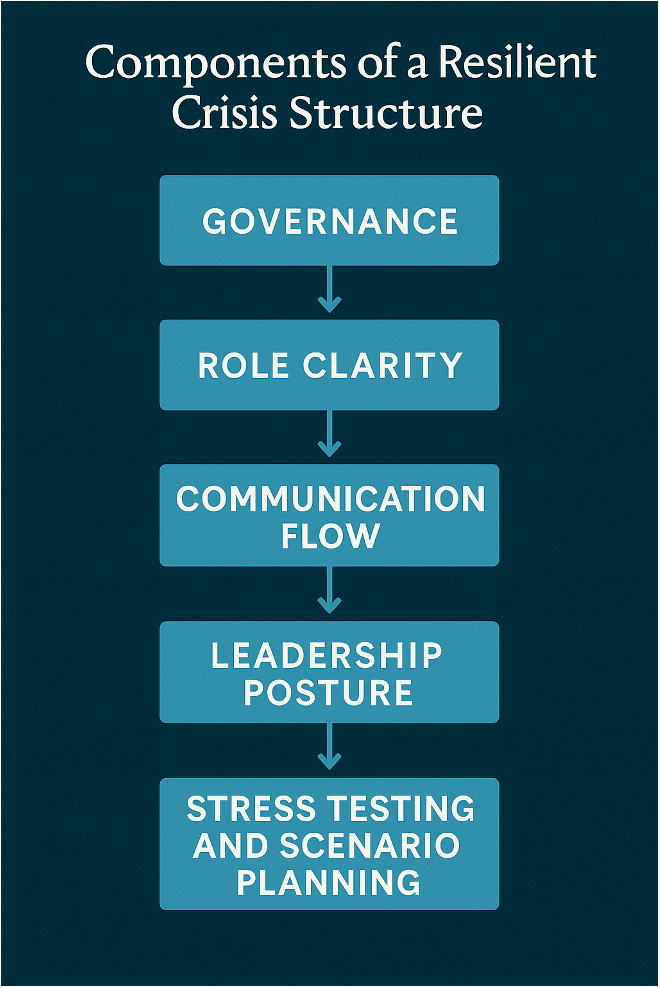

Chapter 7: Resilient Command Model
Resilience in crisis doesn’t happen by chance-it’s the product of intentional design. It stems from deliberate planning, practiced coordination, and a shared commitment to act decisively under pressure. At the center of this resilience lies the Crisis Management Team (CMT)-a dedicated group entrusted with leading an organization through disruption, stabilizing operations, protecting critical assets, and preserving reputation. The effectiveness of this team can determine whether a crisis is contained or escalates into catastrophe.
A high-performing CMT is far more than a technical task force. It embodies an organization’s collective ability to respond with clarity, speed, and control when the unexpected strikes. Its success depends on three interdependent elements: structure, scope, and scalability.
Structure: Roles and Responsibilities
A resilient CMT is cross-functional, drawing members from diverse parts of the organization. Core roles typically include:
• Incident Commander – the overall decision-maker
• IT Lead – managing technical containment and recovery
• Legal Counsel – ensuring regulatory compliance
• Communications Lead – handling internal and external messaging
• Operations Lead – overseeing business continuity
• Human Resources – protecting employee wellbeing
Additional specialists – such as cybersecurity experts or PR consultants, depending on the crisis
For a CMT to function well, role clarity is non-negotiable. Each member must understand their responsibilities and authority-including who acts as backup if they’re unavailable. Ambiguity in a crisis creates delays, conflicting decisions, or even complete paralysis. A pre-established crisis plan provides the foundation, but flexibility is crucial: the CMT must adapt as the situation evolves.
Scope: From Detection to Recovery
The mandate of the CMT extends far beyond resolving a technical problem. It is responsible for:
• Detecting incidents early
• Assessing severity and potential impact
• Activating response protocols
• Managing internal coordination
• Communicating with stakeholders
• Making escalation decisions
• Ensuring service continuity and recovery
The team must decide which functions must stay live, what can be paused, and how to allocate scarce resources during disruption. A resilient CMT balances urgency with discipline-taking decisive action while avoiding panic or misinformation.
Scalability: Adapting to Crisis Size
Not every disruption requires a full-scale response. A well-designed CMT must be scalable, able to expand or contract based on the scope and intensity of the incident. Smaller incidents may be handled by a lean core team, while larger events may require broader participation-including external advisors and additional functional leaders.
To enable this flexibility, organizations often develop scenario-based playbooks and tiered response models. These define clear thresholds for activating different levels of response-from department-level interventions (Tier 1) to executive-led crisis coordination (Tier 3). Scalability also ensures that the team doesn’t burn out during prolonged events by shifting between tactical operations, strategic planning, and recovery mode.
Operational Foundations: Rhythm, Authority, and Culture
A strong CMT operates on clear rhythms and routines. Cadence matters: regular huddles every 30 minutes, structured updates every 90, and full team alignments every few hours help maintain momentum and focus. The CMT leader acts as an orchestrator-ensuring everyone is heard, decisions are tracked, and outcomes are aligned.
But leadership is not just about presence-it’s about behaviour. Effective crisis leaders remain calm, communicative, and confident. They absorb pressure without passing it down. They model integrity and build trust, especially when decisions must be made without perfect information.
The culture of the CMT is equally important. Psychological safety allows team members to raise concerns, challenge assumptions, and admit uncertainty. A blame-based culture weakens resilience; a learning-based one strengthens it. Crisis exposes organizational character-how well a team collaborates under pressure often determines whether a disruption becomes a failure or a success story.
Integration and Communication
CMTs don’t operate in isolation. They must be deeply integrated into broader governance structures. That means clear escalation paths to executive leadership, strong links to business continuity, and coordination with departments like IT, Legal, HR, and Risk.
Communication is critical. The CMT must control messaging internally and externally-ensuring that employees, partners, regulators, and the public hear consistent, timely, and credible information. Assigning trained spokespersons, preparing message templates in advance, and securing communication channels are best practices.
Interfaces with the outside world are also vital. The team must know how to engage law enforcement, work with regulatory agencies, update clients, and manage the media. Delays here are costly-public trust can evaporate if organizations appear confused, evasive, or unprepared.
Documentation and Drills
Even the best-designed CMT must be tested. Tabletop exercises and full-scale simulations develop “muscle memory,” uncover hidden gaps, and refine response protocols. These exercises also ensure that playbooks-brief, visual guides for specific crisis types-remain current and usable.
Good documentation is fast, flexible, and focused. Every team member should know exactly where to find activation checklists, contact directories, escalation matrices, and communication templates-within seconds, not minutes.
Lessons from the Field
The manual concludes with real-world examples. A fintech startup, following a minor data breach, built its CMT from scratch-clarifying roles, training members, and rehearsing responses. When a major incident occurred months later, the team responded smoothly. Another case, involving a ransomware attack on a water utility, demonstrated the power of preparation. Within 30 minutes of detection, the crisis team was activated, coordinated, and communicating-containing the impact and preserving trust.
Conclusion
In crisis, time is unforgiving. Delay multiplies damage. Confusion fractures credibility. The organizations that thrive are those with a clear, practiced, and trusted Crisis Management Team. Not a symbolic group, but a functional command structure-built in calm, tested in tension, and trusted when it matters most.


Chapter 8: Measuring Resilience
In an era of escalating digital threats, stakeholder scrutiny, and regulatory complexity, organizational resilience can no longer remain an abstract ideal. It must become a measurable, trackable, and improvable capability-treated with the same strategic rigor as financial performance or operational efficiency. Resilience is not simply a mindset; it is a structured, data-informed practice that must be embedded into the daily management of the organization.
At the core of modern resilience management lies the use of Key Performance Indicators (KPIs). These indicators translate broad visions and strategic goals into tangible, measurable outcomes. However, KPIs are often misunderstood or misapplied-reduced to superficial metrics on dashboards that fail to reflect the deeper realities of organizational preparedness and adaptability. To unlock their full value, leaders must understand not just how to track performance, but how to design meaningful measurements that reflect the true state of resilience.
The roots of effective measurement lie in the philosophy of “management by objectives,” a concept popularized by Peter Drucker. He emphasized the importance of clear, shared goals and collaborative engagement across the organization. Applied to resilience, this approach ensures that the ability to absorb and recover from shocks is not accidental, but deliberate and embedded across functions and teams. It shifts responsibility for resilience from a single team to the entire organization.
Effective KPIs act as organizational compasses, helping teams focus on what matters most. Unlike vanity metrics that simply count activity (like meetings or emails), meaningful KPIs are aligned with strategic priorities and grounded in the organization’s specific context. The best KPIs serve as early-warning systems, highlight emerging risks, and prompt proactive adjustments. In a crisis-prone world, they encourage a stance of anticipation rather than reaction.
To structure resilience measurement in a comprehensive way, many organizations use the Balanced Scorecard-a framework that evaluates performance from four perspectives: financial, customer, internal process, and learning & growth. This multidimensional approach ensures that leaders don’t focus solely on end results, but also on the enablers of resilience: skilled staff, effective processes, and stakeholder trust. For instance, financial KPIs might measure recovery costs, while learning KPIs might track crisis simulation participation.
Within this framework, it is vital to differentiate between leading and lagging indicators. Leading indicators, such as the number of risk assessments conducted or time to detect incidents, signal potential future performance. Lagging indicators, like system downtime or customer attrition post-crisis, reveal the outcome of past efforts. A well-balanced KPI system includes both, giving leaders visibility into what’s coming and what has already occurred.
Beyond scorecards, maturity models provide structured benchmarks for resilience. Frameworks like the NIST Cybersecurity Framework or ENISA’s Resilience Maturity Model describe stages of development from “initial” to “optimized.” These help organizations identify where they stand today and what steps are needed to progress. KPIs act as milestones on this journey, making the path to greater resilience tangible and achievable.
But measurement is only as useful as the discipline behind it. How, when, and with whom metrics are used matters just as much as what is measured. Metrics should be part of the organizational rhythm-not relegated to annual reviews or compliance checklists. The frequency of tracking should reflect the volatility of the risks involved: cybersecurity metrics may require daily attention, while culture-related metrics might be reviewed quarterly. The key is aligning cadence with context.
Benchmarking also adds value, both internally and externally. Internal benchmarking across departments helps identify outliers-areas that excel or struggle disproportionately. External benchmarking against industry peers provides perspective and motivation. If incident response times or training participation lag behind competitors, it signals a need for attention and potential adaptation of best practices.
However, measurement integrity is essential. KPIs must be built on consistent definitions, transparent methodologies, and honest interpretation. Manipulating data to create a rosier picture undermines trust and devalues the process. The most resilient organizations involve diverse stakeholders in designing and reviewing metrics, combining quantitative data with qualitative insights from the frontline. This reduces the risk of “measurement myopia”-focusing only on what’s easy to count, rather than what’s most important.
Most importantly, measurement should be dynamic and iterative. Metrics must evolve with shifting threats and priorities. Dashboards are not static-they must be reviewed, debated, and adjusted. What gets measured should prompt real conversations: What does the data mean? What should we do next? What new questions does this raise? Resilience measurement must be a living process of discovery and action.
A powerful example of this evolution comes from Maersk, the global shipping giant. In 2017, Maersk was devastated by the NotPetya cyberattack. Despite prior investments in security, the attack exposed significant weaknesses in detection, recovery, and communication. In response, Maersk overhauled its resilience metrics. It introduced new KPIs, such as time to detect incidents, recovery speed, and communication effectiveness. It ran regular crisis simulations and red team assessments. Critically, it tracked results on a centralized dashboard reviewed by leadership. The lesson was clear: resilience improves when it is measured-and reviewed-with intent
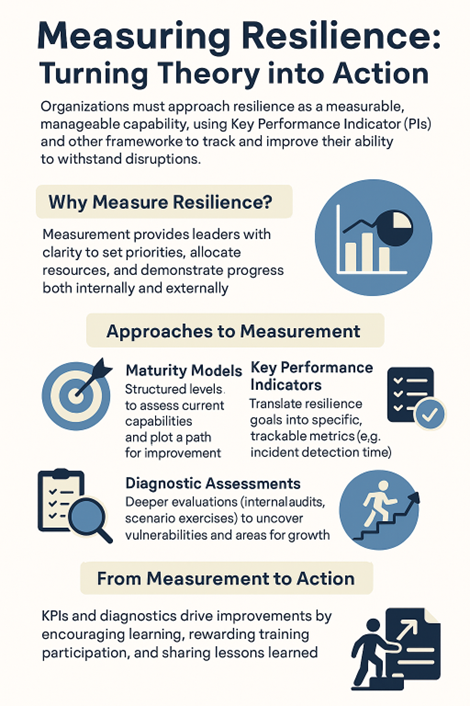

Chapter 9: Resilience Leadership
Organizational resilience is not a tool, a procedure, or a policy-it is a way of being. It cannot be installed or audited into existence. True resilience is a behavioural and cultural capability: a shared set of assumptions, norms, and responses that govern how people think, act, and interact under pressure. It determines how organizations absorb disruption, adapt to change, and recover from crisis without losing sight of their purpose. At its core, resilience lives in culture-and culture, more than any other single element, is shaped by leadership.
Culture is the invisible infrastructure that determines how people react to stress, communicate under uncertainty, and navigate ambiguity or conflict. It decides whether teams freeze or act, fragment or align, conceal or disclose. Resilient culture is not reactive-it is proactive, grounded in psychological safety, shared responsibility, and leadership consistency. And it begins long before a crisis strikes.
Leadership sets the tone of resilience, not just through formal policies or mission statements, but through everyday behaviour. The most resilient organizations are not necessarily those with the thickest crisis binders. They are the ones where people are trusted to act without waiting for permission. They are the places where speaking up is welcomed, where decisions are made where the facts are clearest, and where initiative is rewarded over obedience. This does not emerge by accident-it is cultivated over time through deliberate leadership modelling: openness, humility, accountability, and respect.
One common misunderstanding is the belief that resilience is only tested in crisis. In reality, it is tested every day-in hallway conversations, decision-making meetings, team conflicts, and unexpected problems. Culture is shaped in these ordinary moments and solidified through repetition. How leaders react when someone makes a mistake, how they respond to dissent, and how they handle bad news all reinforce or undermine the resilience of the organization. Over time, these micro-signals become the organization’s “normal.”
Psychological safety is the foundation of a resilient culture. It is the belief that individuals can express concerns, admit mistakes, ask questions, and challenge assumptions without fear of ridicule or retribution. In crisis, this safety becomes essential-because no system, however advanced, can function well if people are afraid to speak. Silence, driven by fear or hierarchy, erodes readiness faster than any technical deficiency.
Leadership presence plays a central role in maintaining that safety. True presence goes beyond visibility. It means showing up in meetings with attention, asking open questions, listening with empathy, and thanking people for raising uncomfortable truths. The best leaders under pressure are not those who bark orders or project false certainty. They are those who absorb stress, stay calm, and create space for others to perform. In moments of uncertainty, the leader’s demeanour sets the tone for the entire organization.
The military has long demonstrated the power of proximate leadership in high-risk environments. In combat zones, rank matters-but so does presence, consistency, and the ability to communicate intent under pressure. The same holds true in the corporate world. Crisis teams perform best when their leaders are engaged, responsive, and invested in the team’s success-not when they operate from a distance or via disconnected statements.
Storytelling also plays a powerful role in shaping a resilient culture. Organizations create shared meaning through the stories they tell-about past crises, recoveries, and moments of strength or failure. Resilient leaders don’t shy away from difficult stories. They use them to reinforce learning, highlight unsung heroes, and connect current risks to past lessons. Memory, not mythology, is what anchors teams during future disruptions.
However, a common failure of leadership is the gap between stated values and lived behaviour. Saying “we value transparency” while avoiding uncomfortable truths or claiming “we empower teams” while micromanaging every move, undermines credibility. These gaps create cynicism, and cynicism kills resilience. People must believe that their leaders mean what they say, or they will disengage just when their commitment is most needed.
Resilience also requires cross-functional trust and collaboration. Crises never respect organizational boundaries-they cut across IT, legal, HR, operations, and communications. If these functions do not trust each other, or if leadership fails to model unity, the response will falter. Senior leaders must actively bridge silos, resolve turf wars, and reward collaboration. A fragmented leadership team sends a dangerous message: when the pressure rises, alignment breaks.
Cultural alignment also depends on systems and routines. Culture cannot thrive on rhetoric alone. It must be supported by practical scaffolding: regular simulations, honest debriefs, embedded feedback loops, and performance metrics that reflect complexity, not just speed or efficiency. If employees are punished for delay but not rewarded for risk awareness, they will hide problems. If leaders only reward perfection, people will avoid transparency. Systems must reinforce the values that culture seeks to uphold.
In global organizations, culture becomes more complex. Norms differ by geography. What builds trust in one region may be misunderstood in another. Leaders must adapt their style while holding to core principles – respect, clarity, and preparation. Local leadership must be empowered to express resilience in ways that resonate with their teams, not simply implement top.

Chapter 10: Self-Assessment
Resilience in organizations is not a software solution, a checklist item, or a policy manual. It is a living, dynamic quality rooted in how people think, decide, and behave-especially under pressure. It is not merely the presence of systems or strategies, but the way people act when those systems are tested. At the heart of this lies culture: the shared beliefs, behaviours, and expectations that shape how teams respond to ambiguity, conflict, and disruption. And more than any other force, that culture is shaped and sustained by leadership.
Resilient organizations are not defined by the number of plans they have on the shelf, but by the mindset their people bring to uncertainty. In such environments, employees feel trusted to act, empowered to raise concerns, and confident that they’ll be supported for speaking up. Resilience thrives not in command-and-control structures, but in cultures where decision-making is distributed, where clarity flows freely, and where initiative is rewarded over obedience. These qualities do not emerge by accident. They are cultivated by leaders through consistent behaviour-by modelling openness, encouraging dialogue, and showing accountability even in the face of failure.
A common misconception is that resilience is only tested in crises. In truth, it is tested every day. It is evident in how decisions are made, how feedback is shared, and how leaders respond to dissent, surprise, and bad news. The daily routines of communication, transparency, and mutual respect form a behavioural infrastructure that either supports or undermines resilience when a true disruption occurs. An organization that tolerates fear, silences doubt or punishes mistakes may appear calm in normal times-but it is brittle when pressure mounts.
Culture is shaped in moments but built through repetition. Every interaction-an email, a meeting, a decision-is a cultural signal. When a frontline employee raises a risk, are they thanked or ignored? When a mistake is made, is it investigated or buried? When new ideas are suggested, are they welcomed or dismissed? Over time, these small signals compound into a set of unspoken rules that define what’s normal. Leaders, through their presence and consistency, set the tone for what’s acceptable, expected, and safe to express.
One of the most critical ingredients in a resilient culture is psychological safety-the belief that it is safe to take interpersonal risks. In such environments, people are more likely to raise issues early, share concerns without fear, and act with greater ownership. This is not about eliminating all conflict or discomfort; it is about building trust that enables honest conversations. When trust is absent, silence takes hold. And silence is toxic in a crisis-it delays decisions, hides problems, and amplifies risk.
Resilient leadership means showing up with presence-not just being visible, but being engaged, listening, admitting what you don’t know, and staying grounded in facts. Strong leaders don’t pretend to be invincible. They invite others to speak, absorb tension without escalating it, and avoid turning uncertainty into blame. In doing so, they anchor the team and create conditions for others to act with clarity and courage.
This principle is evident in high-stakes environments like the military, where failure can be immediate and fatal. There, leadership is defined by clarity, calm, and proximity. People don’t follow rank-they follow consistency. This lesson is just as relevant in the boardroom as it is on the battlefield: teams need to feel that their leaders are close enough to understand, competent enough to guide, and human enough to trust.
Resilience is also a product of shared narrative. Organizations make sense of events through stories: stories of past challenges, turning points, failures, and recoveries. These narratives shape how people interpret the present and prepare for the future. Resilient organizations don’t just tell stories of success-they tell stories of struggle, reflection, and learning. Leaders curate these stories not as mythology, but as memory. When a team remembers its past resilience, it gains confidence in its ability to respond again.
One of the most corrosive threats to a resilient culture is the gap between stated values and lived behaviour. Leaders may proclaim a commitment to transparency, empowerment, or preparedness-but if their actions contradict their words, cynicism sets in. Employees quickly detect inconsistency. And when belief in leadership erodes, engagement follows. Resilience demands commitment. And commitment is rooted in trust.
Cross-functional collaboration is another essential dimension. Resilience cannot live in silos. IT, HR, Legal, Communications, Operations-all must be aligned. Turf wars, unclear responsibilities, or misaligned incentives break down coordination and amplify risk. Leaders must model collaboration, convene joint decision-making forums, and resolve friction at the top before it cascades downward.
Culture must also be supported by systems. It is not enough to say the right things-leaders must build scaffolding around those values. Are simulations regular? Are mistakes reviewed with honesty? Are incentives aligned with risk awareness, early escalation, and collaboration? Systems either reinforce the desired behaviours-or quietly sabotage them.
In global organizations, cultural nuances must also be respected. Psychological safety or leadership visibility may look different in different regions. Leaders must recognize that resilience has universal principles-clarity, respect, shared responsibility-but local expressions. The challenge is to create a consistent foundation while allowing for contextual adaptation.
Technology adds another layer. Remote work, digital communication, and dispersed teams make leadership presence harder to convey. Leaders must be more intentional: over-communicate, ask more questions, check in frequently, and build relational trust through effort, not assumption. The tools may change, but the human need for connection, clarity, and trust remains the same.
Ultimately, a resilient culture is not only about recovery-it is about regeneration. After a disruption, resilient leaders create space for reflection. They ask: What did we learn? What helped us adapt? What should we change? These conversations are not reserved for crisis reviews-they must be part of the organization’s rhythm. Because resilience is not a destination-it is a practice. And leadership is the daily discipline that keeps it alive.
Case in Point:
A global financial services firm under cyberattack demonstrated resilient leadership. Rather than hiding the breach, the CEO communicated immediately with transparency. Roles were delegated, stakeholders were engaged, and mistakes were acknowledged in real time. In the aftermath, a company-wide debrief was held. Employee trust and pride increased-not because the crisis was avoided, but because it was met with honest, composed, and competent leadership. The message was clear: resilience starts with how leaders show up.
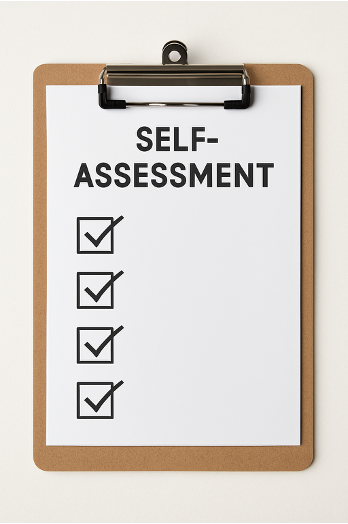

Chapter 11: Strategic Resilience Objectives
The moment an organization completes a meaningful self-assessment marks a critical inflection point in its resilience journey. With blind spots revealed and strengths clarified, the pressing question becomes: What now? While some organizations pause at this stage-collecting reports, acknowledging gaps, and then resuming routine operations-others seize the opportunity for transformation. These forward-thinking organizations use the clarity gained from self-assessment to set strategic resilience objectives: focused, structured, and measurable commitments that guide the development of real-world capability.
Resilience is not built on vague aspirations or generic intentions. It is forged through deliberate focus. Strategic focus enables organizations to align leadership, coordinate action, and track measurable progress. But such focus must be defined and owned. It starts by converting insights from assessment-whether they come from incident reviews, cross-functional discussions, or revealed vulnerabilities-into a small set of strategic objectives. These objectives are not invented in isolation; they are distilled from patterns, pain points, and conversations. And they are shaped, championed, and reinforced by leadership at every level.
A strong resilience objective is not an idea-it is a design. It identifies what needs to change, why it matters, how it will be measured, and who is responsible. The best objectives share four core qualities: relevance (they address real issues), clarity (they’re understandable across the organization), measurability (they include indicators of progress), and traction (they are embedded in daily operations and have visible sponsorship).
For example, a strategic objective might be: “Ensure every business unit runs a live crisis simulation each quarter, with findings logged and reviewed.” Or: “Establish a trained, cross-functional crisis management team with named alternates and clear escalation protocols by Q3.” These objectives avoid vagueness. They set direction, define ownership, and reinforce commitment to improvement.
Just as important as the objectives themselves are the guiding principles that shape how they are pursued. While objectives say what to do, principles guide how to do it-especially when conditions change. For instance, principles like “Decisions live closest to the facts,” “Transparency builds trust,” or “Failing forward is progress” help teams navigate uncertainty and conflict. When principles are consistently referenced in leadership communication, simulations, and debriefs, they become part of the cultural fabric-not decorative slogans, but decision-making anchors.
Organizations often face a challenge of abundance following assessment: too many findings, too many potential initiatives. This makes prioritization essential. Effective prioritization considers both impact and leverage: Which objective reduces the most risk? Which action creates systemic improvement? Which investment builds momentum and confidence? For example, clarifying communication protocols or initiating quarterly simulation cycles can catalyse other improvements, making them high-leverage choices.
Prioritization is not just analytical-it’s emotional. Teams carry scars from previous crises, and objectives that ignore lived experience can breed scepticism. Transparent prioritization processes that include diverse voices-from IT and HR to operations and frontline staff-build ownership and trust. In organizations with varied geographies or maturity levels, a good approach is to define shared resilience themes (like “Improve leadership response capability”) and let individual units adapt these into local objectives that fit their context.
Timeframes also matter. Not all objectives should be tackled in a quarter. Some may be foundational and span multiple years. For example, a three-year goal to integrate resilience into procurement could be phased: Year 1 focuses on supplier risk scoring, Year 2 on contractual frameworks, and Year 3 on supplier simulations. A good strategic portfolio balances quick wins with long-term capability building.
Measurement must accompany action. Objectives need indicators that show progress, whether through quantitative metrics (e.g., incident detection time, simulation participation rates) or qualitative feedback (e.g., employee confidence, stakeholder trust). These metrics create feedback loops that foster accountability, support learning, and help leaders course-correct in real time.
Every objective must have a clear owner-not just a task manager, but someone responsible for unblocking barriers, coordinating teams, and championing progress. Ownership clarifies responsibility, ensures follow-through, and creates visibility around improvement efforts. In high-performing organizations, ownership is distributed but supported-with resources, leadership attention, and regular review.
Case Study: A Logistics Company’s Turning Point
A regional logistics provider, after suffering a cyberattack, found its crisis response fragmented across teams and countries. A facilitated self-assessment revealed three critical gaps: unclear crisis roles, poor communication protocols, and leadership confusion under pressure. Instead of rushing to fix everything, the leadership paused and created three strategic objectives:
• Define and train a regional crisis structure with alternates and escalation paths.
• Launch a resilience communication campaign, including role cards and monthly updates.
• Integrate resilience metrics into board-level dashboards.
Each was linked to guiding principles-like “Communication creates clarity”-and assigned senior sponsors. Within a year, simulations improved, confidence increased, and crisis coordination became smoother. The event that once exposed the company’s fragility became the catalyst for resilience maturity.
Conclusion
Setting strategic resilience objectives is how organizations convert insight into intention and intention into capability. It ensures that resilience becomes more than an audit item-it becomes a central pillar of how the organization thinks, acts, and grows. When guided by shared principles, prioritized through inclusive processes, and supported by ownership and measurement, these objectives become the roadmap to resilience in action.
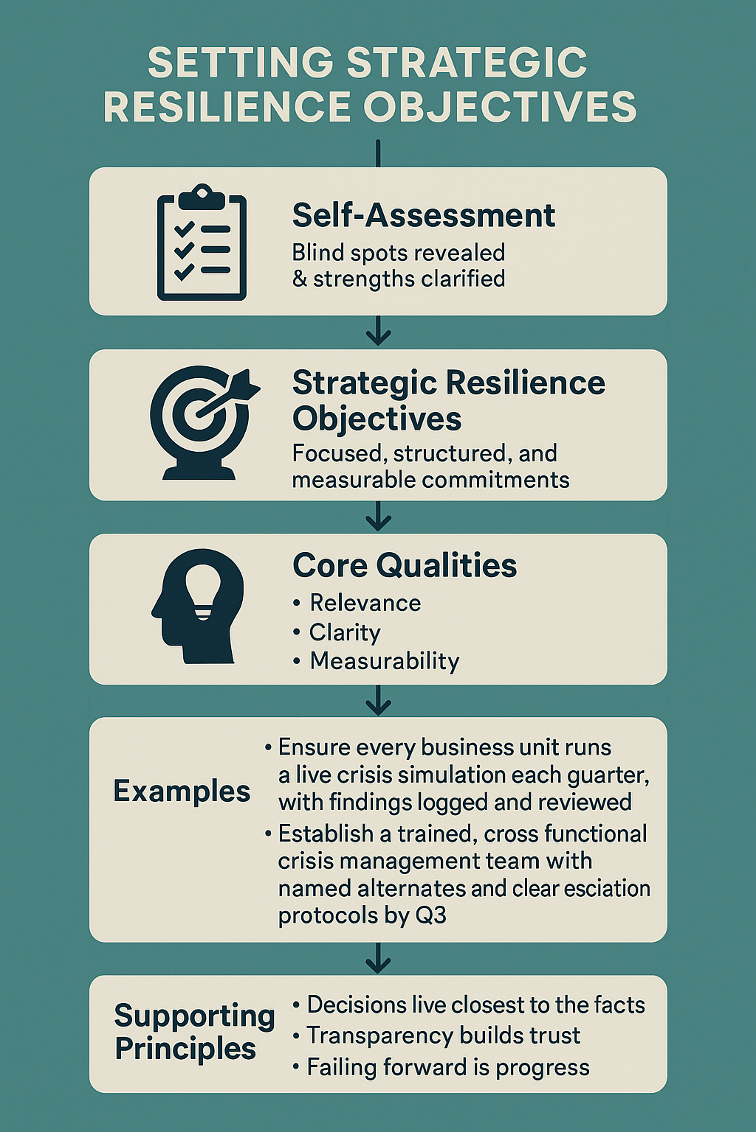

Chapter 12: Synthesis & Expectations
Completing the first workshop day does not mark the end, but rather the beginning of a transformative year-long journey toward organizational resilience. The final module serves as a crucial bridge from learning to action, from insight to implementation. It focuses on two key themes: synthesis and orientation. Together, they provide the foundation for sustained progress in building resilience across the organization.
Synthesis: Seeing the Whole Picture
After examining the resilience cycle, comparing cybersecurity with resilience, exploring case studies like Sony Pictures, and conducting readiness assessments, it becomes essential to step back and connect the dots. Synthesis transforms fragmented lessons into a coherent narrative-a story that empowers teams to understand not only what they’ve learned, but why it matters and how it fits into a broader strategic direction.
Synthesis gives teams the opportunity to clarify what resilience truly means for their specific context. It reframes resilience not merely as a technical function or compliance checkbox, but as a holistic, organization-wide capability. Culture, leadership, measurement, and proactive learning are just as critical as systems and infrastructure. Every element supports the others. This interconnected understanding is what enables sustainable improvement.
Orientation: Setting the Tone for the Year Ahead
With synthesis complete, orientation guides the next steps. It is a structured invitation for participants to own the resilience journey, contribute ideas, and commit to real progress. Effective orientation accomplishes several goals:
– Connecting the Dots: It reintroduces the key lessons from all modules-definitions, frameworks, exercises, and case studies-and shows how they build logically toward maturity.
– Establishing Expectations: It lays out the cadence, content, and commitment required for the ongoing workshop series, ensuring clarity about structure and objectives.
– Assigning Roles: It clarifies who is responsible for what, not just during the sessions but in the organization at large. Everyone plays a part in making resilience real.
– Building Engagement: Orientation fosters early wins, encourages team dialogue, and builds trust-essential ingredients for long-term cultural change.
– Creating Accountability: By defining how progress will be measured, shared, and reviewed, it establishes a shared commitment to transparency and learning.
Case Example: A Year of Transformation
A global engineering firm demonstrated the power of this approach. Following several poorly managed incidents, the organization adopted a structured year-long resilience program. The first session helped participants map the interdependencies between cyber threats, business continuity, leadership, and organizational culture. They then co-created a roadmap with quarterly priorities, ranging from crisis team drills to cultural change initiatives. Regular check-ins, forums, and workshops helped maintain momentum. By the end of the year, the firm reported both technical improvements and deeper cross-functional collaboration-proof that resilience is as much about people as it is about process.
Workshop Exercise: Designing a Resilience Roadmap
In the closing exercise, participants co-design a strategic roadmap for the next twelve months. The process includes:
– Mapping the most important insights from the 12 prior modules.
– Identifying linkages, gaps, and priorities.
– Defining three top organizational objectives for resilience.
– Assigning champions or working groups to lead implementation and track progress.
Each participant also commits to one personal action that supports resilience in their role-ensuring that the learning journey turns into lived practice.
Case Study: Creating a Shared Resilience Charter
In another example, a diverse task force came together after several days of intense resilience exercises. Despite shared insight, something still felt missing. Then, prompted by their facilitator, they created a resilience charter: a set of sentences that captured their collective values. Statements like “We act early, not perfectly,” and “We prepare as a team, not in silos,” became more than declarations-they became behavioural anchors.
Six months later, a real incident tested the organization’s response. They acted with calm and coordination. The charter wasn’t just symbolic-it was a functional guide under pressure.
Final Exercise: Shared Compass
The concluding activity of the workshop is not a technical task, but a moment of meaning. Participants reflect on what they’ve learned, what they’re committing to, and what values they want to embody going forward. The group then co-creates a Resilience Charter-a living statement of shared purpose. Short, clear phrases like “We trust the process more than the plan,” or “We learn aloud, not in silence,” are recorded, remembered, and referenced throughout the year.
This moment transforms the group from a collection of individuals into a team aligned around a common mission. The charter becomes their compass-not a contract, but a commitment.
Looking Ahead: Building Real-World Resilience
The journey ahead is not about checking boxes-it’s about building culture. Resilience is not an outcome; it’s a relationship. It grows in the space between fear and preparation, between control and adaptability, between assumptions and action. As participants move into the next phase, they are not simply learning more-they are becoming different. More connected. More committed. More capable.
The next twelve modules will deepen the journey across leadership decision-making, stakeholder communication, digital continuity, operational recovery, and more. But these are not standalone topics. They are interlocking pieces of one core mission: to build an organization that remains functional, trusted, and adaptive-no matter the disruption.
The final message of this workshop is clear: resilience is not what we know. It is what we do-together-when it matters most.
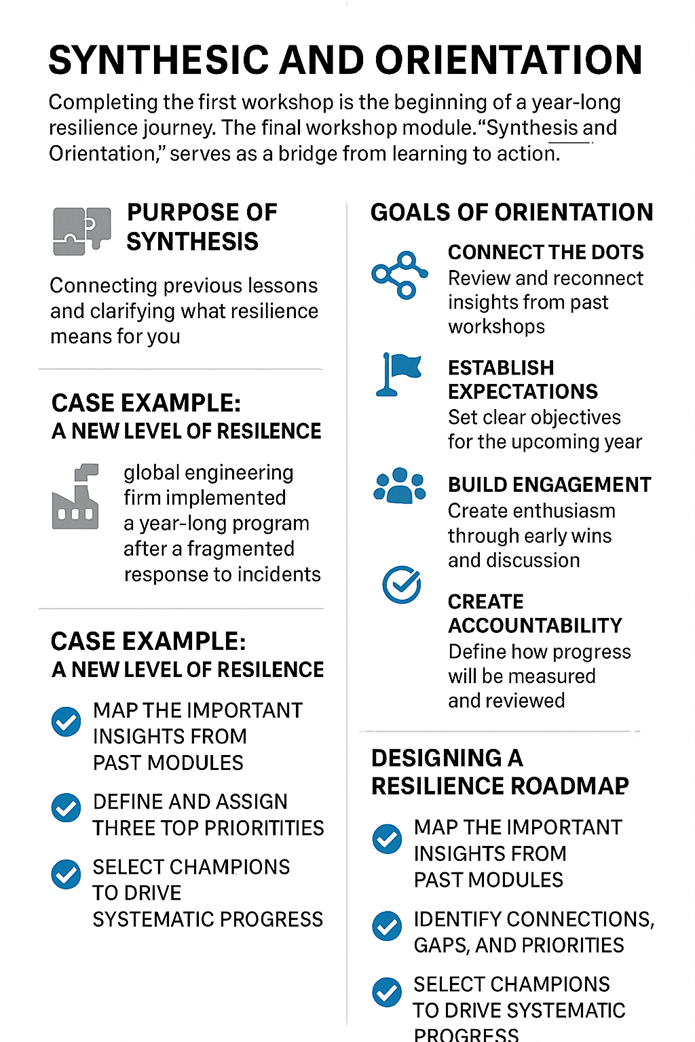
Curriculum
Destination Resilience – Workshop 1 – Roadmap to Resilience
- Resilience Defined
- Resilience Cycle
- Cybersecurity vs. Cyber Resilience
- Anatomy of a Crisis
- Resilience Evolution
- Organizational Structure
- Resilient Command Model
- Measuring Resilience
- Resilience Leadership
- Self-Assessment
- Strategic Resilience Objectives
- Synthesis & Expectations
Distance Learning
Introduction
Welcome to Appleton Greene and thank you for enrolling on the Destination Resilience corporate training program. You will be learning through our unique facilitation via distance-learning method, which will enable you to practically implement everything that you learn academically. The methods and materials used in your program have been designed and developed to ensure that you derive the maximum benefits and enjoyment possible. We hope that you find the program challenging and fun to do. However, if you have never been a distance-learner before, you may be experiencing some trepidation at the task before you. So we will get you started by giving you some basic information and guidance on how you can make the best use of the modules, how you should manage the materials and what you should be doing as you work through them. This guide is designed to point you in the right direction and help you to become an effective distance-learner. Take a few hours or so to study this guide and your guide to tutorial support for students, while making notes, before you start to study in earnest.
Study environment
You will need to locate a quiet and private place to study, preferably a room where you can easily be isolated from external disturbances or distractions. Make sure the room is well-lit and incorporates a relaxed, pleasant feel. If you can spoil yourself within your study environment, you will have much more of a chance to ensure that you are always in the right frame of mind when you do devote time to study. For example, a nice fire, the ability to play soft soothing background music, soft but effective lighting, perhaps a nice view if possible and a good size desk with a comfortable chair. Make sure that your family know when you are studying and understand your study rules. Your study environment is very important. The ideal situation, if at all possible, is to have a separate study, which can be devoted to you. If this is not possible then you will need to pay a lot more attention to developing and managing your study schedule, because it will affect other people as well as yourself. The better your study environment, the more productive you will be.
Study tools & rules
Try and make sure that your study tools are sufficient and in good working order. You will need to have access to a computer, scanner and printer, with access to the internet. You will need a very comfortable chair, which supports your lower back, and you will need a good filing system. It can be very frustrating if you are spending valuable study time trying to fix study tools that are unreliable, or unsuitable for the task. Make sure that your study tools are up to date. You will also need to consider some study rules. Some of these rules will apply to you and will be intended to help you to be more disciplined about when and how you study. This distance-learning guide will help you and after you have read it you can put some thought into what your study rules should be. You will also need to negotiate some study rules for your family, friends or anyone who lives with you. They too will need to be disciplined in order to ensure that they can support you while you study. It is important to ensure that your family and friends are an integral part of your study team. Having their support and encouragement can prove to be a crucial contribution to your successful completion of the program. Involve them in as much as you can.
Successful distance-learning
Distance-learners are freed from the necessity of attending regular classes or workshops, since they can study in their own way, at their own pace and for their own purposes. But unlike traditional internal training courses, it is the student’s responsibility, with a distance-learning program, to ensure that they manage their own study contribution. This requires strong self-discipline and self-motivation skills and there must be a clear will to succeed. Those students who are used to managing themselves, are good at managing others and who enjoy working in isolation, are more likely to be good distance-learners. It is also important to be aware of the main reasons why you are studying and of the main objectives that you are hoping to achieve as a result. You will need to remind yourself of these objectives at times when you need to motivate yourself. Never lose sight of your long-term goals and your short-term objectives. There is nobody available here to pamper you, or to look after you, or to spoon-feed you with information, so you will need to find ways to encourage and appreciate yourself while you are studying. Make sure that you chart your study progress, so that you can be sure of your achievements and re-evaluate your goals and objectives regularly.
Self-assessment
Appleton Greene training programs are in all cases post-graduate programs. Consequently, you should already have obtained a business-related degree and be an experienced learner. You should therefore already be aware of your study strengths and weaknesses. For example, which time of the day are you at your most productive? Are you a lark or an owl? What study methods do you respond to the most? Are you a consistent learner? How do you discipline yourself? How do you ensure that you enjoy yourself while studying? It is important to understand yourself as a learner and so some self-assessment early on will be necessary if you are to apply yourself correctly. Perform a SWOT analysis on yourself as a student. List your internal strengths and weaknesses as a student and your external opportunities and threats. This will help you later on when you are creating a study plan. You can then incorporate features within your study plan that can ensure that you are playing to your strengths, while compensating for your weaknesses. You can also ensure that you make the most of your opportunities, while avoiding the potential threats to your success.
Accepting responsibility as a student
Training programs invariably require a significant investment, both in terms of what they cost and in the time that you need to contribute to study and the responsibility for successful completion of training programs rests entirely with the student. This is never more apparent than when a student is learning via distance-learning. Accepting responsibility as a student is an important step towards ensuring that you can successfully complete your training program. It is easy to instantly blame other people or factors when things go wrong. But the fact of the matter is that if a failure is your failure, then you have the power to do something about it, it is entirely in your own hands. If it is always someone else’s failure, then you are powerless to do anything about it. All students study in entirely different ways, this is because we are all individuals and what is right for one student, is not necessarily right for another. In order to succeed, you will have to accept personal responsibility for finding a way to plan, implement and manage a personal study plan that works for you. If you do not succeed, you only have yourself to blame.
Planning
By far the most critical contribution to stress, is the feeling of not being in control. In the absence of planning we tend to be reactive and can stumble from pillar to post in the hope that things will turn out fine in the end. Invariably they don’t! In order to be in control, we need to have firm ideas about how and when we want to do things. We also need to consider as many possible eventualities as we can, so that we are prepared for them when they happen. Prescriptive Change, is far easier to manage and control, than Emergent Change. The same is true with distance-learning. It is much easier and much more enjoyable, if you feel that you are in control and that things are going to plan. Even when things do go wrong, you are prepared for them and can act accordingly without any unnecessary stress. It is important therefore that you do take time to plan your studies properly.
Management
Once you have developed a clear study plan, it is of equal importance to ensure that you manage the implementation of it. Most of us usually enjoy planning, but it is usually during implementation when things go wrong. Targets are not met and we do not understand why. Sometimes we do not even know if targets are being met. It is not enough for us to conclude that the study plan just failed. If it is failing, you will need to understand what you can do about it. Similarly if your study plan is succeeding, it is still important to understand why, so that you can improve upon your success. You therefore need to have guidelines for self-assessment so that you can be consistent with performance improvement throughout the program. If you manage things correctly, then your performance should constantly improve throughout the program.
Study objectives & tasks
The first place to start is developing your program objectives. These should feature your reasons for undertaking the training program in order of priority. Keep them succinct and to the point in order to avoid confusion. Do not just write the first things that come into your head because they are likely to be too similar to each other. Make a list of possible departmental headings, such as: Customer Service; E-business; Finance; Globalization; Human Resources; Technology; Legal; Management; Marketing and Production. Then brainstorm for ideas by listing as many things that you want to achieve under each heading and later re-arrange these things in order of priority. Finally, select the top item from each department heading and choose these as your program objectives. Try and restrict yourself to five because it will enable you to focus clearly. It is likely that the other things that you listed will be achieved if each of the top objectives are achieved. If this does not prove to be the case, then simply work through the process again.
Study forecast
As a guide, the Appleton Greene Destination Resilience corporate training program should take 12-18 months to complete, depending upon your availability and current commitments. The reason why there is such a variance in time estimates is because every student is an individual, with differing productivity levels and different commitments. These differentiations are then exaggerated by the fact that this is a distance-learning program, which incorporates the practical integration of academic theory as an as a part of the training program. Consequently all of the project studies are real, which means that important decisions and compromises need to be made. You will want to get things right and will need to be patient with your expectations in order to ensure that they are. We would always recommend that you are prudent with your own task and time forecasts, but you still need to develop them and have a clear indication of what are realistic expectations in your case. With reference to your time planning: consider the time that you can realistically dedicate towards study with the program every week; calculate how long it should take you to complete the program, using the guidelines featured here; then break the program down into logical modules and allocate a suitable proportion of time to each of them, these will be your milestones; you can create a time plan by using a spreadsheet on your computer, or a personal organizer such as MS Outlook, you could also use a financial forecasting software; break your time forecasts down into manageable chunks of time, the more specific you can be, the more productive and accurate your time management will be; finally, use formulas where possible to do your time calculations for you, because this will help later on when your forecasts need to change in line with actual performance. With reference to your task planning: refer to your list of tasks that need to be undertaken in order to achieve your program objectives; with reference to your time plan, calculate when each task should be implemented; remember that you are not estimating when your objectives will be achieved, but when you will need to focus upon implementing the corresponding tasks; you also need to ensure that each task is implemented in conjunction with the associated training modules which are relevant; then break each single task down into a list of specific to do’s, say approximately ten to do’s for each task and enter these into your study plan; once again you could use MS Outlook to incorporate both your time and task planning and this could constitute your study plan; you could also use a project management software like MS Project. You should now have a clear and realistic forecast detailing when you can expect to be able to do something about undertaking the tasks to achieve your program objectives.
Performance management
It is one thing to develop your study forecast, it is quite another to monitor your progress. Ultimately it is less important whether you achieve your original study forecast and more important that you update it so that it constantly remains realistic in line with your performance. As you begin to work through the program, you will begin to have more of an idea about your own personal performance and productivity levels as a distance-learner. Once you have completed your first study module, you should re-evaluate your study forecast for both time and tasks, so that they reflect your actual performance level achieved. In order to achieve this you must first time yourself while training by using an alarm clock. Set the alarm for hourly intervals and make a note of how far you have come within that time. You can then make a note of your actual performance on your study plan and then compare your performance against your forecast. Then consider the reasons that have contributed towards your performance level, whether they are positive or negative and make a considered adjustment to your future forecasts as a result. Given time, you should start achieving your forecasts regularly.
With reference to time management: time yourself while you are studying and make a note of the actual time taken in your study plan; consider your successes with time-efficiency and the reasons for the success in each case and take this into consideration when reviewing future time planning; consider your failures with time-efficiency and the reasons for the failures in each case and take this into consideration when reviewing future time planning; re-evaluate your study forecast in relation to time planning for the remainder of your training program to ensure that you continue to be realistic about your time expectations. You need to be consistent with your time management, otherwise you will never complete your studies. This will either be because you are not contributing enough time to your studies, or you will become less efficient with the time that you do allocate to your studies. Remember, if you are not in control of your studies, they can just become yet another cause of stress for you.
With reference to your task management: time yourself while you are studying and make a note of the actual tasks that you have undertaken in your study plan; consider your successes with task-efficiency and the reasons for the success in each case; take this into consideration when reviewing future task planning; consider your failures with task-efficiency and the reasons for the failures in each case and take this into consideration when reviewing future task planning; re-evaluate your study forecast in relation to task planning for the remainder of your training program to ensure that you continue to be realistic about your task expectations. You need to be consistent with your task management, otherwise you will never know whether you are achieving your program objectives or not.
Keeping in touch
You will have access to qualified and experienced professors and tutors who are responsible for providing tutorial support for your particular training program. So don’t be shy about letting them know how you are getting on. We keep electronic records of all tutorial support emails so that professors and tutors can review previous correspondence before considering an individual response. It also means that there is a record of all communications between you and your professors and tutors and this helps to avoid any unnecessary duplication, misunderstanding, or misinterpretation. If you have a problem relating to the program, share it with them via email. It is likely that they have come across the same problem before and are usually able to make helpful suggestions and steer you in the right direction. To learn more about when and how to use tutorial support, please refer to the Tutorial Support section of this student information guide. This will help you to ensure that you are making the most of tutorial support that is available to you and will ultimately contribute towards your success and enjoyment with your training program.
Work colleagues and family
You should certainly discuss your program study progress with your colleagues, friends and your family. Appleton Greene training programs are very practical. They require you to seek information from other people, to plan, develop and implement processes with other people and to achieve feedback from other people in relation to viability and productivity. You will therefore have plenty of opportunities to test your ideas and enlist the views of others. People tend to be sympathetic towards distance-learners, so don’t bottle it all up in yourself. Get out there and share it! It is also likely that your family and colleagues are going to benefit from your labors with the program, so they are likely to be much more interested in being involved than you might think. Be bold about delegating work to those who might benefit themselves. This is a great way to achieve understanding and commitment from people who you may later rely upon for process implementation. Share your experiences with your friends and family.
Making it relevant
The key to successful learning is to make it relevant to your own individual circumstances. At all times you should be trying to make bridges between the content of the program and your own situation. Whether you achieve this through quiet reflection or through interactive discussion with your colleagues, client partners or your family, remember that it is the most important and rewarding aspect of translating your studies into real self-improvement. You should be clear about how you want the program to benefit you. This involves setting clear study objectives in relation to the content of the course in terms of understanding, concepts, completing research or reviewing activities and relating the content of the modules to your own situation. Your objectives may understandably change as you work through the program, in which case you should enter the revised objectives on your study plan so that you have a permanent reminder of what you are trying to achieve, when and why.
Distance-learning check-list
Prepare your study environment, your study tools and rules.
Undertake detailed self-assessment in terms of your ability as a learner.
Create a format for your study plan.
Consider your study objectives and tasks.
Create a study forecast.
Assess your study performance.
Re-evaluate your study forecast.
Be consistent when managing your study plan.
Use your Appleton Greene Certified Learning Provider (CLP) for tutorial support.
Make sure you keep in touch with those around you.

Tutorial Support
Programs
Appleton Greene uses standard and bespoke corporate training programs as vessels to transfer business process improvement knowledge into the heart of our clients’ organizations. Each individual program focuses upon the implementation of a specific business process, which enables clients to easily quantify their return on investment. There are hundreds of established Appleton Greene corporate training products now available to clients within customer services, e-business, finance, globalization, human resources, information technology, legal, management, marketing and production. It does not matter whether a client’s employees are located within one office, or an unlimited number of international offices, we can still bring them together to learn and implement specific business processes collectively. Our approach to global localization enables us to provide clients with a truly international service with that all important personal touch. Appleton Greene corporate training programs can be provided virtually or locally and they are all unique in that they individually focus upon a specific business function. They are implemented over a sustainable period of time and professional support is consistently provided by qualified learning providers and specialist consultants.
Support available
You will have a designated Certified Learning Provider (CLP) and an Accredited Consultant and we encourage you to communicate with them as much as possible. In all cases tutorial support is provided online because we can then keep a record of all communications to ensure that tutorial support remains consistent. You would also be forwarding your work to the tutorial support unit for evaluation and assessment. You will receive individual feedback on all of the work that you undertake on a one-to-one basis, together with specific recommendations for anything that may need to be changed in order to achieve a pass with merit or a pass with distinction and you then have as many opportunities as you may need to re-submit project studies until they meet with the required standard. Consequently the only reason that you should really fail (CLP) is if you do not do the work. It makes no difference to us whether a student takes 12 months or 18 months to complete the program, what matters is that in all cases the same quality standard will have been achieved.
Support Process
Please forward all of your future emails to the designated (CLP) Tutorial Support Unit email address that has been provided and please do not duplicate or copy your emails to other AGC email accounts as this will just cause unnecessary administration. Please note that emails are always answered as quickly as possible but you will need to allow a period of up to 20 business days for responses to general tutorial support emails during busy periods, because emails are answered strictly within the order in which they are received. You will also need to allow a period of up to 30 business days for the evaluation and assessment of project studies. This does not include weekends or public holidays. Please therefore kindly allow for this within your time planning. All communications are managed online via email because it enables tutorial service support managers to review other communications which have been received before responding and it ensures that there is a copy of all communications retained on file for future reference. All communications will be stored within your personal (CLP) study file here at Appleton Greene throughout your designated study period. If you need any assistance or clarification at any time, please do not hesitate to contact us by forwarding an email and remember that we are here to help. If you have any questions, please list and number your questions succinctly and you can then be sure of receiving specific answers to each and every query.
Time Management
It takes approximately 1 Year to complete the Destination Resilience corporate training program, incorporating 12 x 6-hour monthly workshops. Each student will also need to contribute approximately 4 hours per week over 1 Year of their personal time. Students can study from home or work at their own pace and are responsible for managing their own study plan. There are no formal examinations and students are evaluated and assessed based upon their project study submissions, together with the quality of their internal analysis and supporting documents. They can contribute more time towards study when they have the time to do so and can contribute less time when they are busy. All students tend to be in full time employment while studying and the Destination Resilience program is purposely designed to accommodate this, so there is plenty of flexibility in terms of time management. It makes no difference to us at Appleton Greene, whether individuals take 12-18 months to complete this program. What matters is that in all cases the same standard of quality will have been achieved with the standard and bespoke programs that have been developed.
Distance Learning Guide
The distance learning guide should be your first port of call when starting your training program. It will help you when you are planning how and when to study, how to create the right environment and how to establish the right frame of mind. If you can lay the foundations properly during the planning stage, then it will contribute to your enjoyment and productivity while training later. The guide helps to change your lifestyle in order to accommodate time for study and to cultivate good study habits. It helps you to chart your progress so that you can measure your performance and achieve your goals. It explains the tools that you will need for study and how to make them work. It also explains how to translate academic theory into practical reality. Spend some time now working through your distance learning guide and make sure that you have firm foundations in place so that you can make the most of your distance learning program. There is no requirement for you to attend training workshops or classes at Appleton Greene offices. The entire program is undertaken online, program course manuals and project studies are administered via the Appleton Greene web site and via email, so you are able to study at your own pace and in the comfort of your own home or office as long as you have a computer and access to the internet.
How To Study
The how to study guide provides students with a clear understanding of the Appleton Greene facilitation via distance learning training methods and enables students to obtain a clear overview of the training program content. It enables students to understand the step-by-step training methods used by Appleton Greene and how course manuals are integrated with project studies. It explains the research and development that is required and the need to provide evidence and references to support your statements. It also enables students to understand precisely what will be required of them in order to achieve a pass with merit and a pass with distinction for individual project studies and provides useful guidance on how to be innovative and creative when developing your Unique Program Proposition (UPP).
Tutorial Support
Tutorial support for the Appleton Greene Destination Resilience corporate training program is provided online either through the Appleton Greene Client Support Portal (CSP), or via email. All tutorial support requests are facilitated by a designated Program Administration Manager (PAM). They are responsible for deciding which professor or tutor is the most appropriate option relating to the support required and then the tutorial support request is forwarded onto them. Once the professor or tutor has completed the tutorial support request and answered any questions that have been asked, this communication is then returned to the student via email by the designated Program Administration Manager (PAM). This enables all tutorial support, between students, professors and tutors, to be facilitated by the designated Program Administration Manager (PAM) efficiently and securely through the email account. You will therefore need to allow a period of up to 20 business days for responses to general support queries and up to 30 business days for the evaluation and assessment of project studies, because all tutorial support requests are answered strictly within the order in which they are received. This does not include weekends or public holidays. Consequently you need to put some thought into the management of your tutorial support procedure in order to ensure that your study plan is feasible and to obtain the maximum possible benefit from tutorial support during your period of study. Please retain copies of your tutorial support emails for future reference. Please ensure that ALL of your tutorial support emails are set out using the format as suggested within your guide to tutorial support. Your tutorial support emails need to be referenced clearly to the specific part of the course manual or project study which you are working on at any given time. You also need to list and number any questions that you would like to ask, up to a maximum of five questions within each tutorial support email. Remember the more specific you can be with your questions the more specific your answers will be too and this will help you to avoid any unnecessary misunderstanding, misinterpretation, or duplication. The guide to tutorial support is intended to help you to understand how and when to use support in order to ensure that you get the most out of your training program. Appleton Greene training programs are designed to enable you to do things for yourself. They provide you with a structure or a framework and we use tutorial support to facilitate students while they practically implement what they learn. In other words, we are enabling students to do things for themselves. The benefits of distance learning via facilitation are considerable and are much more sustainable in the long-term than traditional short-term knowledge sharing programs. Consequently you should learn how and when to use tutorial support so that you can maximize the benefits from your learning experience with Appleton Greene. This guide describes the purpose of each training function and how to use them and how to use tutorial support in relation to each aspect of the training program. It also provides useful tips and guidance with regard to best practice.
Tutorial Support Tips
Students are often unsure about how and when to use tutorial support with Appleton Greene. This Tip List will help you to understand more about how to achieve the most from using tutorial support. Refer to it regularly to ensure that you are continuing to use the service properly. Tutorial support is critical to the success of your training experience, but it is important to understand when and how to use it in order to maximize the benefit that you receive. It is no coincidence that those students who succeed are those that learn how to be positive, proactive and productive when using tutorial support.
Be positive and friendly with your tutorial support emails
Remember that if you forward an email to the tutorial support unit, you are dealing with real people. “Do unto others as you would expect others to do unto you”. If you are positive, complimentary and generally friendly in your emails, you will generate a similar response in return. This will be more enjoyable, productive and rewarding for you in the long-term.
Think about the impression that you want to create
Every time that you communicate, you create an impression, which can be either positive or negative, so put some thought into the impression that you want to create. Remember that copies of all tutorial support emails are stored electronically and tutors will always refer to prior correspondence before responding to any current emails. Over a period of time, a general opinion will be arrived at in relation to your character, attitude and ability. Try to manage your own frustrations, mood swings and temperament professionally, without involving the tutorial support team. Demonstrating frustration or a lack of patience is a weakness and will be interpreted as such. The good thing about communicating in writing, is that you will have the time to consider your content carefully, you can review it and proof-read it before sending your email to Appleton Greene and this should help you to communicate more professionally, consistently and to avoid any unnecessary knee-jerk reactions to individual situations as and when they may arise. Please also remember that the CLP Tutorial Support Unit will not just be responsible for evaluating and assessing the quality of your work, they will also be responsible for providing recommendations to other learning providers and to client contacts within the Appleton Greene global client network, so do be in control of your own emotions and try to create a good impression.
Remember that quality is preferred to quantity
Please remember that when you send an email to the tutorial support team, you are not using Twitter or Text Messaging. Try not to forward an email every time that you have a thought. This will not prove to be productive either for you or for the tutorial support team. Take time to prepare your communications properly, as if you were writing a professional letter to a business colleague and make a list of queries that you are likely to have and then incorporate them within one email, say once every month, so that the tutorial support team can understand more about context, application and your methodology for study. Get yourself into a consistent routine with your tutorial support requests and use the tutorial support template provided with ALL of your emails. The (CLP) Tutorial Support Unit will not spoon-feed you with information. They need to be able to evaluate and assess your tutorial support requests carefully and professionally.
Be specific about your questions in order to receive specific answers
Try not to write essays by thinking as you are writing tutorial support emails. The tutorial support unit can be unclear about what in fact you are asking, or what you are looking to achieve. Be specific about asking questions that you want answers to. Number your questions. You will then receive specific answers to each and every question. This is the main purpose of tutorial support via email.
Keep a record of your tutorial support emails
It is important that you keep a record of all tutorial support emails that are forwarded to you. You can then refer to them when necessary and it avoids any unnecessary duplication, misunderstanding, or misinterpretation.
Individual training workshops or telephone support
Please be advised that Appleton Greene does not provide separate or individual tutorial support meetings, workshops, or provide telephone support for individual students. Appleton Greene is an equal opportunities learning and service provider and we are therefore understandably bound to treat all students equally. We cannot therefore broker special financial or study arrangements with individual students regardless of the circumstances. All tutorial support is provided online and this enables Appleton Greene to keep a record of all communications between students, professors and tutors on file for future reference, in accordance with our quality management procedure and your terms and conditions of enrolment. All tutorial support is provided online via email because it enables us to have time to consider support content carefully, it ensures that you receive a considered and detailed response to your queries. You can number questions that you would like to ask, which relate to things that you do not understand or where clarification may be required. You can then be sure of receiving specific answers to each individual query. You will also then have a record of these communications and of all tutorial support, which has been provided to you. This makes tutorial support administration more productive by avoiding any unnecessary duplication, misunderstanding, or misinterpretation.
Tutorial Support Email Format
You should use this tutorial support format if you need to request clarification or assistance while studying with your training program. Please note that ALL of your tutorial support request emails should use the same format. You should therefore set up a standard email template, which you can then use as and when you need to. Emails that are forwarded to Appleton Greene, which do not use the following format, may be rejected and returned to you by the (CLP) Program Administration Manager. A detailed response will then be forwarded to you via email usually within 20 business days of receipt for general support queries and 30 business days for the evaluation and assessment of project studies. This does not include weekends or public holidays. Your tutorial support request, together with the corresponding TSU reply, will then be saved and stored within your electronic TSU file at Appleton Greene for future reference.
Subject line of your email
Please insert: Appleton Greene (CLP) Tutorial Support Request: (Your Full Name) (Date), within the subject line of your email.
Main body of your email
Please insert:
1. Appleton Greene Certified Learning Provider (CLP) Tutorial Support Request
2. Your Full Name
3. Date of TS request
4. Preferred email address
5. Backup email address
6. Course manual page name or number (reference)
7. Project study page name or number (reference)
Subject of enquiry
Please insert a maximum of 50 words (please be succinct)
Briefly outline the subject matter of your inquiry, or what your questions relate to.
Question 1
Maximum of 50 words (please be succinct)
Maximum of 50 words (please be succinct)
Question 3
Maximum of 50 words (please be succinct)
Question 4
Maximum of 50 words (please be succinct)
Question 5
Maximum of 50 words (please be succinct)
Please note that a maximum of 5 questions is permitted with each individual tutorial support request email.
Procedure
* List the questions that you want to ask first, then re-arrange them in order of priority. Make sure that you reference them, where necessary, to the course manuals or project studies.
* Make sure that you are specific about your questions and number them. Try to plan the content within your emails to make sure that it is relevant.
* Make sure that your tutorial support emails are set out correctly, using the Tutorial Support Email Format provided here.
* Save a copy of your email and incorporate the date sent after the subject title. Keep your tutorial support emails within the same file and in date order for easy reference.
* Allow up to 20 business days for a response to general tutorial support emails and up to 30 business days for the evaluation and assessment of project studies, because detailed individual responses will be made in all cases and tutorial support emails are answered strictly within the order in which they are received.
* Emails can and do get lost. So if you have not received a reply within the appropriate time, forward another copy or a reminder to the tutorial support unit to be sure that it has been received but do not forward reminders unless the appropriate time has elapsed.
* When you receive a reply, save it immediately featuring the date of receipt after the subject heading for easy reference. In most cases the tutorial support unit replies to your questions individually, so you will have a record of the questions that you asked as well as the answers offered. With project studies however, separate emails are usually forwarded by the tutorial support unit, so do keep a record of your own original emails as well.
* Remember to be positive and friendly in your emails. You are dealing with real people who will respond to the same things that you respond to.
* Try not to repeat questions that have already been asked in previous emails. If this happens the tutorial support unit will probably just refer you to the appropriate answers that have already been provided within previous emails.
* If you lose your tutorial support email records you can write to Appleton Greene to receive a copy of your tutorial support file, but a separate administration charge may be levied for this service.

How To Study
Your Certified Learning Provider (CLP) and Accredited Consultant can help you to plan a task list for getting started so that you can be clear about your direction and your priorities in relation to your training program. It is also a good way to introduce yourself to the tutorial support team.
Planning your study environment
Your study conditions are of great importance and will have a direct effect on how much you enjoy your training program. Consider how much space you will have, whether it is comfortable and private and whether you are likely to be disturbed. The study tools and facilities at your disposal are also important to the success of your distance-learning experience. Your tutorial support unit can help with useful tips and guidance, regardless of your starting position. It is important to get this right before you start working on your training program.
Planning your program objectives
It is important that you have a clear list of study objectives, in order of priority, before you start working on your training program. Your tutorial support unit can offer assistance here to ensure that your study objectives have been afforded due consideration and priority.
Planning how and when to study
Distance-learners are freed from the necessity of attending regular classes, since they can study in their own way, at their own pace and for their own purposes. This approach is designed to let you study efficiently away from the traditional classroom environment. It is important however, that you plan how and when to study, so that you are making the most of your natural attributes, strengths and opportunities. Your tutorial support unit can offer assistance and useful tips to ensure that you are playing to your strengths.
Planning your study tasks
You should have a clear understanding of the study tasks that you should be undertaking and the priority associated with each task. These tasks should also be integrated with your program objectives. The distance learning guide and the guide to tutorial support for students should help you here, but if you need any clarification or assistance, please contact your tutorial support unit.
Planning your time
You will need to allocate specific times during your calendar when you intend to study if you are to have a realistic chance of completing your program on time. You are responsible for planning and managing your own study time, so it is important that you are successful with this. Your tutorial support unit can help you with this if your time plan is not working.
Keeping in touch
Consistency is the key here. If you communicate too frequently in short bursts, or too infrequently with no pattern, then your management ability with your studies will be questioned, both by you and by your tutorial support unit. It is obvious when a student is in control and when one is not and this will depend how able you are at sticking with your study plan. Inconsistency invariably leads to in-completion.
Charting your progress
Your tutorial support team can help you to chart your own study progress. Refer to your distance learning guide for further details.
Making it work
To succeed, all that you will need to do is apply yourself to undertaking your training program and interpreting it correctly. Success or failure lies in your hands and your hands alone, so be sure that you have a strategy for making it work. Your Certified Learning Provider (CLP) and Accredited Consultant can guide you through the process of program planning, development and implementation.
Reading methods
Interpretation is often unique to the individual but it can be improved and even quantified by implementing consistent interpretation methods. Interpretation can be affected by outside interference such as family members, TV, or the Internet, or simply by other thoughts which are demanding priority in our minds. One thing that can improve our productivity is using recognized reading methods. This helps us to focus and to be more structured when reading information for reasons of importance, rather than relaxation.
Speed reading
When reading through course manuals for the first time, subconsciously set your reading speed to be just fast enough that you cannot dwell on individual words or tables. With practice, you should be able to read an A4 sheet of paper in one minute. You will not achieve much in the way of a detailed understanding, but your brain will retain a useful overview. This overview will be important later on and will enable you to keep individual issues in perspective with a more generic picture because speed reading appeals to the memory part of the brain. Do not worry about what you do or do not remember at this stage.
Content reading
Once you have speed read everything, you can then start work in earnest. You now need to read a particular section of your course manual thoroughly, by making detailed notes while you read. This process is called Content Reading and it will help to consolidate your understanding and interpretation of the information that has been provided.
Making structured notes on the course manuals
When you are content reading, you should be making detailed notes, which are both structured and informative. Make these notes in a MS Word document on your computer, because you can then amend and update these as and when you deem it to be necessary. List your notes under three headings: 1. Interpretation – 2. Questions – 3. Tasks. The purpose of the 1st section is to clarify your interpretation by writing it down. The purpose of the 2nd section is to list any questions that the issue raises for you. The purpose of the 3rd section is to list any tasks that you should undertake as a result. Anyone who has graduated with a business-related degree should already be familiar with this process.
Organizing structured notes separately
You should then transfer your notes to a separate study notebook, preferably one that enables easy referencing, such as a MS Word Document, a MS Excel Spreadsheet, a MS Access Database, or a personal organizer on your cell phone. Transferring your notes allows you to have the opportunity of cross-checking and verifying them, which assists considerably with understanding and interpretation. You will also find that the better you are at doing this, the more chance you will have of ensuring that you achieve your study objectives.
Question your understanding
Do challenge your understanding. Explain things to yourself in your own words by writing things down.
Clarifying your understanding
If you are at all unsure, forward an email to your tutorial support unit and they will help to clarify your understanding.
Question your interpretation
Do challenge your interpretation. Qualify your interpretation by writing it down.
Clarifying your interpretation
If you are at all unsure, forward an email to your tutorial support unit and they will help to clarify your interpretation.
Qualification Requirements
The student will need to successfully complete the project study and all of the exercises relating to the Destination Resilience corporate training program, achieving a pass with merit or distinction in each case, in order to qualify as an Accredited Destination Resilience Specialist (APTS). All monthly workshops need to be tried and tested within your company. These project studies can be completed in your own time and at your own pace and in the comfort of your own home or office. There are no formal examinations, assessment is based upon the successful completion of the project studies. They are called project studies because, unlike case studies, these projects are not theoretical, they incorporate real program processes that need to be properly researched and developed. The project studies assist us in measuring your understanding and interpretation of the training program and enable us to assess qualification merits. All of the project studies are based entirely upon the content within the training program and they enable you to integrate what you have learnt into your corporate training practice.
Destination Resilience – Grading Contribution
Project Study – Grading Contribution
Customer Service – 10%
E-business – 05%
Finance – 10%
Globalization – 10%
Human Resources – 10%
Information Technology – 10%
Legal – 05%
Management – 10%
Marketing – 10%
Production – 10%
Education – 05%
Logistics – 05%
TOTAL GRADING – 100%
Qualification grades
A mark of 90% = Pass with Distinction.
A mark of 75% = Pass with Merit.
A mark of less than 75% = Fail.
If you fail to achieve a mark of 75% with a project study, you will receive detailed feedback from the Certified Learning Provider (CLP) and/or Accredited Consultant, together with a list of tasks which you will need to complete, in order to ensure that your project study meets with the minimum quality standard that is required by Appleton Greene. You can then re-submit your project study for further evaluation and assessment. Indeed you can re-submit as many drafts of your project studies as you need to, until such a time as they eventually meet with the required standard by Appleton Greene, so you need not worry about this, it is all part of the learning process.
When marking project studies, Appleton Greene is looking for sufficient evidence of the following:
Pass with merit
A satisfactory level of program understanding
A satisfactory level of program interpretation
A satisfactory level of project study content presentation
A satisfactory level of Unique Program Proposition (UPP) quality
A satisfactory level of the practical integration of academic theory
Pass with distinction
An exceptional level of program understanding
An exceptional level of program interpretation
An exceptional level of project study content presentation
An exceptional level of Unique Program Proposition (UPP) quality
An exceptional level of the practical integration of academic theory
Preliminary Analysis
Foundations of Organizational Resilience
This preliminary analysis serves as a preparatory guide for all participants of Workshop 1. Each chapter of the workshop covers a central theme essential to understanding, building, and leading organizational resilience in today’s volatile world. To maximize the value of your participation, you are encouraged to review the following articles, studies, and resources in advance. The list below combines both current thought leadership and practical case study insights, offering participants a strong foundation for each topic.
1. Resilience Defined
To grasp the conceptual foundations of resilience and its critical role in organizational success, participants should begin with Diane Coutu’s seminal article, “How Resilience Works,” published by Harvard Business Review (May 2002). This classic text, available here, defines the three core characteristics of resilient people and organizations. For those seeking more depth, the book Resilience: Why Things Bounce Back by Andrew Zolli & Ann Marie Healy (Simon & Schuster, 2012) explores these themes in detail and is available in libraries and digital formats.
2. Resilience Cycle
To understand the cyclical nature of organizational resilience, start with the World Economic Forum’s accessible summary, “Building Resilience in Uncertain Times” (2021). For a deeper academic approach, Erica Seville’s Resilient Organizations: How to Survive, Thrive and Create Opportunities through Crisis and Change (especially Chapter 2: “The Resilience Cycle”) provides actionable frameworks and is widely available as an eBook.
3. Cybersecurity vs. Cyber Resilience
Clarifying the difference between cyber defence and holistic cyber resilience is essential in the digital era. The ENISA publication “Cybersecurity and Resilience for SMEs” (2022) is open-access and highly practical. For more advanced insight, Peter Trim & Yang-Im Lee’s book, Cyber Security Management: A Governance, Risk and Compliance Perspective (Chapter 4: “Cyber Resilience”) is recommended.
4. Crisis Anatomy
Understanding how small incidents can evolve into organizational crises is the focus of this topic. Harvard Business Review’s “Crisis Management: How to Prepare For the Unexpected” (2020) offers timely and actionable guidance, available here. For practical learning, the case study “The 2014 Sony Hack: Five Years Later” on CSO Online here is indispensable. For further reading, Ian Mitroff’s book Crisis Leadership: Planning for the Unthinkable is highly recommended.
5. Resilience Evolution
To explore the military roots and evolving doctrines of resilience, read RAND Corporation’s report, “Lessons from the Military for Business Resilience” (RAND PDF). A thought-provoking academic perspective can be found in Nassim Nicholas Taleb’s Antifragile: Things That Gain from Disorder (especially Resilience Defined).
6. Organizational Structure
Examining how organizational design affects resilience, Deloitte’s “Governance for Resilience: Key Elements” (PDF) is practical and contemporary. For in-depth leadership perspectives, consult Eric J. McNulty & Leonard Marcus’s You’re It: Crisis, Change, and How to Lead When it Matters Most.
7. Resilient Command Model
For the structure and function of crisis management teams, the public FEMA “Incident Command System Resources” are always accessible (FEMA ICS Resource Center). For academic depth, see Deborah E. Gibbons’s Communities, Organizations, and Disaster Preparedness, particularly Chapter 5.
8. Measuring Resilience
To learn how resilience is measured, start with ENISA’s “Resilience Maturity Model” and the open-access NIST “Cybersecurity Framework” (NIST Cyber Framework). For more on metrics and diagnostics, see David Denyer & Nancy Tilbury’s Managing Organizational Resilience: Tools and Techniques for Effective Business Continuity Management.
9. Resilience Leadership
To understand how culture and leadership drive resilience, McKinsey’s “Leadership in a Crisis” is a useful overview (Read here). Daniel Goleman’s Leadership: The Power of Emotional Intelligence is an excellent deeper read on leadership tone and culture.
10. Self-Assessment
For self-assessment tools, the British Standards Institution (BSI) provides a public position paper (BSI PDF). For academic application, John A. Parnell’s Crisis Management in the New Strategy Landscape, Chapter 11 is recommended.
11. Strategic Resilience Objectives
To turn assessment into actionable strategy, Deloitte’s “From Surviving to Thriving: Setting Strategic Objectives for Resilience” offers practical advice. Donald Sull’s book Simple Rules: How to Thrive in a Complex World is valuable for guiding principles.
12. Synthesis & Expectations
For frameworks that integrate and align learning, The Resilience Shift’s open-access publications provide a broad overview (Resilience Shift Publications). Erica Seville’s Resilient Organizations (Chapter 12: “The Future of Resilience”) offers a perspective on long-term orientation.
All recommended books can be found via major libraries or academic ebook platforms. Most articles are open-access or available through institutional subscriptions.
Course Manuals 1-12
Course Manual 1: Resilience Defined
At first glance, resilience might seem like a simple concept – the ability to bounce back from adversity, to keep going in the face of difficulty. It’s the word we use when describing someone who survives hardship, when cities recover from disaster, or when organizations push through crises. But behind the apparent simplicity of the term lies something much more complex. Resilience is not just a personal trait or an abstract value. It is a dynamic capability, a strategic necessity, and a mindset that shapes how individuals, organizations, and entire systems deal with disruption.
In recent years, particularly during and after the COVID-19 pandemic, the word “resilience” has become part of our everyday vocabulary. It appears in political speeches, corporate strategy papers, and crisis recovery plans. It’s used to describe everything from emotional strength to national security. But this increased visibility has also brought confusion. The more people talk about resilience, the more meanings it seems to acquire. That’s why it’s essential – before diving into strategy, cyber preparedness, or organizational design – to define clearly what we mean when we talk about resilience in this workshop series.
At its core, resilience is about how we respond when things do not go according to plan. It’s about how we navigate stress, recover from disruption, and adapt to new conditions. In engineering, resilience is the ability of a material to deform under pressure and return to its original shape. In ecology, it refers to a system’s capacity to absorb disturbance without collapsing into a fundamentally different state. In psychology, resilience describes the inner strength that enables a person to survive and grow after trauma. In cybersecurity, it’s about the ability of systems to detect, withstand, and recover from attacks –
not to avoid every incident, but to manage and move forward through them.
What all these interpretations share is a focus on continuity and adaptability. They reflect a shift away from the illusion of perfect control and toward a more realistic understanding of the world as uncertain, complex, and often unpredictable. Resilience does not mean resisting change. It means moving with change, shaping it where possible, and maintaining core functions under pressure.
But resilience is not just reactive. It is also anticipatory and strategic. It’s not only about recovering after a crisis but also about preparing for one before it hits – or even transforming in the face of ongoing disruption. This is especially relevant in today’s interconnected world, where challenges are no longer isolated. Economic volatility, geopolitical tensions, pandemics, climate change, cyber threats – these risks do not occur in silos. They overlap, cascade, and evolve. And so must we.
To understand resilience more deeply, we must look at three dimensions: its meaning, the mindset behind it, and the mission it serves. These three elements form the intellectual framework of this course manual and serve as the foundation for everything that follows in this workshop series.
The meaning of resilience begins with accepting that disruptions are not exceptions – they are part of reality. Too often, individuals and organizations assume that success means stability, and that disruption is something to be feared or denied. But this mindset leaves us vulnerable. The resilient approach acknowledges that volatility is normal. What matters is how we are prepared to meet it. This shift in meaning – from stability to adaptability – is critical. It moves us from a defensive posture to a proactive one. It changes the question from “How do we avoid failure?” to “How do we continue functioning when conditions change?”
This understanding also reveals a deeper truth: resilience is not one-size-fits-all. What resilience looks like depends on the context. For a hospital, it might mean continuing emergency care during a system outage. For a business, it could mean maintaining customer trust during a data breach. For a city, it might mean restoring water supply after an extreme weather event. The resilience of any system is defined not just by its ability to survive but by its ability to fulfil its purpose under stress.
This brings us to mindset. The resilient mindset is not about rigidity or heroism. It is about clarity, curiosity, and calm. It recognizes that disruption can be both a threat and a teacher. Resilient people and resilient organizations see value in adversity – not because they enjoy crisis, but because they understand its potential to reveal weakness, uncover strength, and accelerate change. This mindset involves emotional agility, cognitive flexibility, and strategic patience. It thrives not on certainty, but on learning.
Developing this mindset takes time and intention. For individuals, it involves building habits of reflection, optimism, and self-regulation. For organizations, it means creating cultures that reward openness, tolerate failure as part of innovation, and encourage communication across silos. One of the most important components of a resilient mindset is humility – the willingness to admit what we don’t know, ask for help, and learn in real time. This mindset is not fixed. It is something that can be taught, modelled, and reinforced – especially through leadership.
In this context, leadership plays a critical role. Leaders shape the emotional climate of an organization. In a crisis, they are the ones others look to for guidance, clarity, and reassurance. A resilient leader is not the one who controls every variable but the one who can hold complexity without becoming overwhelmed – who can act decisively without pretending to have all the answers. Resilient leadership is grounded, communicative, and purpose driven.
Which brings us to the final component: mission. Resilience without mission is just motion. To be resilient is not only to continue functioning but to do so with intention. Resilience becomes meaningful when it serves a purpose greater than survival. That purpose – the mission – gives direction to our actions during uncertain times. It helps us prioritize what to protect, what to adapt, and what to let go of.
For organizations, mission answers the question: What are we here to do, even in a crisis? It helps align strategy with values and anchors decision-making in times of pressure. A strong sense of mission helps teams stay connected to the bigger picture, even when they are forced to change plans, take risks, or endure losses. Mission provides coherence when everything else feels fragmented.
This is especially important in the context of cyber resilience. Today’s cyber risks are fast, sophisticated, and far-reaching. They threaten not only data but trust, reputation, and operational continuity. In this environment, it is no longer enough to rely on technical controls alone. Organizations need clear escalation paths, defined responsibilities, and strong internal communication. And they need top leadership that understands their role in resilience.
Cyber crisis management begins with top management. And not just because executives are accountable – but because they are exposed. Under the GDPR, violations can result in fines of up to 20 million euros or 4% of global turnover. These are not theoretical risks. Cases like Meta, Amazon, and Uber have shown that the regulatory landscape is real, and unforgiving. Late reporting, negligence, or unclear chains of command can translate into legal liability and lasting damage to an organization’s public trust.
Therefore, resilience cannot be delegated. Leaders must ensure that functioning crisis teams are in place – and that those teams are prepared to report relevant incidents quickly and clearly. This preparation does not happen during a crisis. It happens in advance – through training, simulation, and cultural reinforcement. Leaders must also familiarize themselves with the scenarios their organizations may face. They must know the protocols, the legal implications, and the human dynamics that unfold under pressure.
One of the best ways to develop this understanding is through exercises that simulate worst-case scenarios. These simulations allow leadership teams to test their communication channels, decision-making processes, and interpersonal dynamics. They expose gaps and strengths, and they allow organizations to practice responding before real consequences are at stake. Such exercises can reveal how individuals react under pressure, how decisions are prepared, and how internal and external communication functions – or fails to function – during a crisis.
These simulations also highlight the importance of defining your crisis team clearly. Who is in the inner circle? Who are the external partners you trust – from IT forensics to legal counsel to PR experts? In a crisis, you won’t have time to figure out who to call. You need those relationships in place already, and everyone needs to know their role. That is why cyber resilience is not just an IT issue. It is a leadership issue, a communication issue, and a cultural issue.
It is worth emphasizing again: resilience is not about bouncing back to where you were. It’s about bouncing forward into where you need to be. After a major disruption, returning to the status quo is rarely the best option – nor is it always possible. Truly resilient systems and organizations take the opportunity to evolve. They adapt to the new landscape, integrate lessons learned, and become stronger as a result. This is what distinguishes mechanical recovery from meaningful transformation.
In this sense, resilience becomes a form of strategic intelligence. It allows organizations to turn volatility into momentum, pressure into innovation, and crisis into clarity. But this doesn’t happen automatically. It requires investment – in mindset, in systems, and in people.
As we begin this journey toward deeper resilience, this manual offers not just definitions but an orientation. In the modules that follow, we will explore cyber threats, protection goals, decision-making models, maturity metrics, and crisis team design. Each of these elements contributes to a more resilient posture. But all of them must be grounded in the foundation we build here: a shared understanding of what resilience means, the mindset it requires, and the mission it serves.
This first module is not about giving you all the answers. It’s about helping you ask better questions. How resilient are you, really – as a leader, as a team, as an organization? Where are your blind spots? What assumptions are you making that might not hold in a crisis? And most importantly: What do you stand for when things go wrong?
Resilience does not guarantee comfort. But it does make progress possible. It allows us to act even in uncertainty, to lead even in confusion, and to learn even in failure. That is why resilience is not a luxury – it is a prerequisite for leadership in the 21st century.
Welcome to the journey.
Resilience is a concept that has gained significant prominence in recent years, particularly following global crises such as the coronavirus pandemic. While the term “resilience” is used frequently in everyday conversation, its deeper meaning often remains unclear. Do we all understand resilience in the same way? What does it truly mean for individuals, organizations, and societies to be resilient? And how does this concept serve as the foundation for effective crisis management and cyber defence?
Resilience, in its essence, refers to the capacity to withstand and adapt to stress, adversity, or disruptive events-whether these are personal challenges, organizational disruptions, or large-scale societal crises. For individuals, it’s the ability to cope with uncertainty, change, setbacks, or trauma. For organizations and communities, it is the collective strength to recover from disruption and emerge stronger.
The pandemic tested personal and collective resilience on a global scale. Suddenly, established routines and assumptions were overturned. People and organizations alike found themselves without previous experience to draw on, forced to adapt rapidly and rethink how to continue functioning amid ongoing uncertainty. In these moments, resilience moved beyond theory-it became a necessary, living capability.
At its core, resilience is not about avoiding adversity, but about facing it with preparation and adaptability. In engineering, resilience describes a material’s ability to return to its original shape after being deformed by external forces. In psychology, resilience is sometimes called the “immune system of the soul”-a psychological strength that enables individuals to deal with difficult life situations. In both cases, the defining feature is not the absence of stress or disruption, but the ability to absorb shock, recover, and continue functioning.
This same principle applies at the organizational and societal level. Businesses, government agencies, cities, and even national infrastructures face complex risks and uncertainties: from cyberattacks and supply chain disruptions, to natural disasters, pandemics, and financial crises. Resilience means having both the mindset and the operational capacity to anticipate, prepare for, respond to, and recover from such events-while also learning and adapting in the aftermath.
It is important to understand that resilience is not a static quality. It is dynamic and can be developed, trained, and reinforced over time. Individuals can cultivate resilience through experience, a positive attitude, and self-reflection. Organizations can build it by investing in preparedness, promoting a culture of learning, and ensuring robust systems and decision-making structures.
Resilience is also deeply connected to vulnerability. Vulnerability is the degree to which a system, organization, or person is susceptible to harm. A resilient organization recognizes its vulnerabilities, honestly assesses them, and takes proactive steps to mitigate them-through redundancy, diversification, risk management, and continual learning. The more transparent an organization is about its weaknesses, the better it can prepare for inevitable disruptions.
A key element of resilience is the acceptance of uncertainty. Rather than striving for a false sense of absolute control, resilient organizations and individuals recognize that disruptive events are inevitable. Their focus shifts from prevention to preparation, from control to adaptability. This mindset does not ignore risks or underestimate dangers, but seeks to balance realism with optimism and a proactive attitude.
For cities and critical infrastructure, resilience involves coordinated capacities at multiple levels: technical, organizational, and cultural. This may include redundant systems, robust networks, and adaptive governance. For example, digital infrastructure has become a key driver of resilience. Those who embraced digital transformation early had a clear advantage during the pandemic, rapidly implementing remote work, cloud collaboration, and digital service delivery. This digital resilience is equally vital in the face of evolving cyber threats, such as ransomware or sophisticated supply chain attacks.
Redundancy and diversity are two classic principles of resilience. Redundancy means having backup systems or alternative resources-so if one part fails, another can take over. Diversity refers to the presence of multiple options, approaches, or actors, making it less likely that a single point of failure can cripple the whole system. In urban planning, for example, redundancy and diversity allow cities to cope with everything from floods to power outages, ensuring critical functions can continue.
A major crisis not only tests resilience but can also trigger transformation. Some organizations or communities may not simply “bounce back” to their original state; instead, they “bounce forward,” using the crisis as a catalyst for change and innovation. This adaptive capacity is what distinguishes true resilience from mere survival. It’s about learning, evolving, and positioning for future challenges.
Good resilience strategy involves scenario planning, proactive risk assessment, and practical training. It also requires ongoing communication and a willingness to challenge assumptions. Organizations that regularly exercise crisis scenarios, update their response plans, and encourage open discussion of risks are consistently better prepared.
Resilience is also about collaboration. No single actor-be it a person, team, or organization-can anticipate or prevent every risk alone. Effective resilience relies on networks, partnerships, and the sharing of information. This is especially true in the context of cybersecurity, where the interconnectedness of digital systems means that the vulnerability of one organization can expose many others.
Finally, the mission of resilience is not simply to survive the next crisis, but to create the conditions for long-term health, adaptability, and growth. This mission requires a conscious, collective effort to cultivate a resilient mindset, invest in preparedness, and learn from each experience.

Case Study: The Resilient Hospital
In a European country, a regional hospital faced a sudden, massive cyberattack. Many similar institutions were forced to suspend services, revert to paper-based systems, or cancel appointments. However, this particular hospital managed to maintain critical operations with minimal disruption. The difference was not superior technology, but preparation and practice. Through regular resilience exercises, a clear escalation plan, cross-functional crisis teams, and a culture of open communication, the hospital responded quickly and effectively. Within 20 minutes, staff switched to alternative systems, communicated clearly with patients and partners, and kept essential services running. This experience underlines the importance of operationalizing resilience-not just as a plan, but as a practiced, living capability.

Exercise: What Is Your Definition of Resilience and Why?
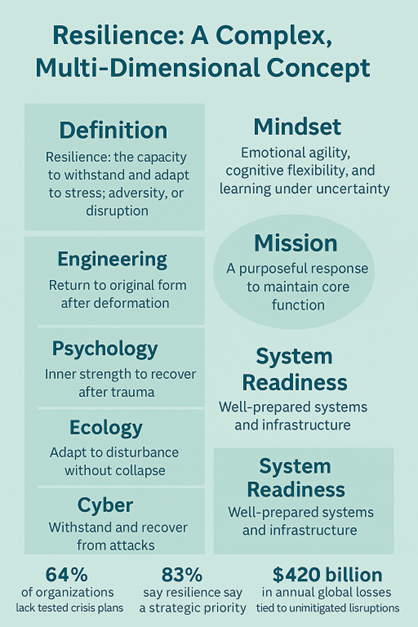

Course Manual 2: Resilience Cycle
Resilience is not a trait we either have or don’t have. It is a process – a living system that develops, adjusts, and improves over time. In the first module, we defined resilience as a combination of mindset, mission, and readiness. But to build real capability, we must look more closely at how resilience unfolds. It does not begin when crisis strikes, nor does it end when stability returns. Instead, it evolves through a recognizable cycle – one that helps us understand where we are, what comes next, and how to lead with purpose throughout.
The Resilience Cycle is a five-phase framework that captures the full lifecycle of resilience in any context – whether in a person, a team, an organization, or a system. It includes Preparation, Disruption, Response, Recovery, and Adaptation. Each phase has its own character, pace, vocabulary, and risks. Together, these phases form the foundation for how resilient systems anticipate, absorb, and grow through disruption.
This course manual is designed to give you a clear conceptual overview of the cycle and to prepare you to explore it in practice. The workshop session ahead will involve applying this model to real case studies and organizational challenges. But first, we must understand what each phase really means – and why it matters.
Phase 1: Preparation – Designing Resilience Before It’s Needed
Resilience begins long before crisis arrives. The preparation phase is often overlooked because it happens in the absence of visible problems. Yet it is the most influential part of the cycle. The work done here will determine how a person, team, or organization performs under pressure. This is the phase of building readiness – practically, emotionally, and structurally.
In practical terms, preparation involves identifying potential risks, creating flexible plans, assigning roles, rehearsing scenarios, and building a common understanding of how to respond. But good preparation also goes beyond checklists. It includes cultivating a culture that encourages questioning, feedback, and shared responsibility. It means creating space for difficult conversations – about vulnerabilities, blind spots, and the realities of uncertainty.
Organizations often confuse documentation with preparedness. Having a crisis plan on a shelf is not the same as being ready. True readiness means people know what to do, whom to inform, and how to act when signals are unclear. Teams that train together build muscle memory – the kind that allows them to improvise under stress without panic.
Leaders in this phase must be proactive, not reactive. They must be willing to invest time in conversations that feel hypothetical or uncomfortable. They must also resist the temptation of “it’s never happened before” thinking. Complacency is the enemy of preparation. The question is not if something will go wrong, but when – and whether we’ll be ready.
The language in this phase often includes terms like risk awareness, continuity planning, and early detection. It is the language of anticipation – a willingness to ask: what could go wrong, and are we prepared to face it together?
Phase 2: Disruption – When the System is Shaken
The second phase, disruption, marks the point at which normal operations are interrupted. Disruption may come in many forms: a cyberattack, a leadership scandal, a data breach, a sudden loss of key personnel, or an external event like a pandemic or power outage. The specific trigger matters less than what it reveals – the pressure test it applies to the system.
During disruption, stress levels rise. Uncertainty spreads. People may lack complete information. Miscommunication is common, and emotional reactions – fear, denial, urgency – influence decisions. The real challenge in this phase is not the event itself, but the system’s ability to absorb the shock without cascading failure.
Disruption is the phase in which assumptions are challenged. Plans are tested. Weaknesses surface. Some teams become paralyzed, unsure of what to do. Others act with urgency, but without coordination. What distinguishes a resilient system at this stage is not that it avoids disruption altogether, but that it recognizes the moment for what it is: a call to activate, not to wait.
Disruption is not a pause in business as usual – it is a new context that requires new behaviour. Recognizing this is crucial. Many systems fail not because of the disruption itself, but because of the delay in acknowledging its seriousness.
The vocabulary of disruption includes escalation, incident recognition, and impact assessment. It also includes stress signals and tipping points. But more than technical language, it calls for emotional awareness. Leaders who can remain calm, communicate clearly, and admit what they don’t yet know help reduce chaos and build collective focus.
Phase 3: Response – Clarity in the Chaos
When the initial shock of disruption gives way to action, the system enters the response phase. This is the moment for decisive movement. The goal is not to fix everything immediately, but to contain damage, protect people and assets, and create space for coordinated decision-making.
The response phase is often the most visible part of resilience – where leaders speak to the public, teams activate protocols, and systems are pushed to their limits. But good response is not about heroics. It’s about clarity. The most effective crisis teams are not necessarily the fastest, but the ones that act with structure and focus.
In this phase, it is crucial to prioritize. Not everything can be fixed at once. Knowing what matters most, what can wait, and who has the authority to act is what separates a coordinated response from a chaotic one. This is where leadership presence becomes vital – not in the form of command and control, but in the ability to make decisions with limited information and high consequences.
Response is also where earlier investments in training and preparation pay off. Teams that have practiced together move more confidently. They understand their roles. They know who speaks to whom. They have language for rapid decision-making under pressure – models like FORDEC or OODA that provide cognitive scaffolding in moments of stress.
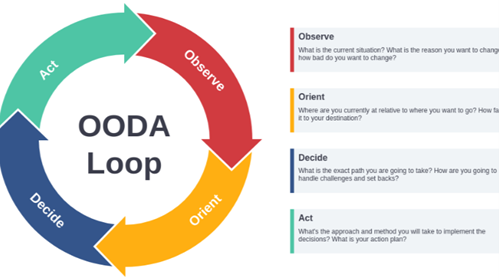
Communication is central in this phase – not just messaging to the outside world, but internal communication that keeps people aligned, informed, and calm. Inconsistent or delayed communication can multiply damage, while transparency and rhythm can restore trust even in difficult moments.
The tone of this phase is active, urgent, and pragmatic. It is not about perfection, but momentum. Moving together – even imperfectly – is often more valuable than waiting for full clarity.
Phase 4: Recovery – Regaining Balance
Once the immediate crisis is contained, the system shifts into the recovery phase. This is a slower, often more complex period in which the organization attempts to return to functionality. Systems are restored. Damage is assessed. Processes begin to normalize. But recovery is not only operational – it is also cultural, emotional, and strategic.
Many organizations rush this phase. The desire to get “back to normal” is strong. But resilient organizations resist the temptation to simply restore the old state. Instead, they use the recovery period to learn. They ask what broke – and why. They invite feedback from all levels. They look beyond surface repairs and address root causes.
Recovery is also the phase where long-term trust is rebuilt. Stakeholders – internal and external – need to see accountability, honesty, and a willingness to improve. Communication remains important, not only in explaining what happened, but in sharing what’s being done to prevent recurrence.
Leaders in the recovery phase must manage both pace and patience. Too fast, and reflection is lost. Too slow, and morale may decline. People may be exhausted, grieving, or disoriented. Acknowledging the human toll of crisis is just as important as restoring business operations. Resilience includes empathy.
In this phase, the language of resilience shifts again – to include words like reflection, rebuilding, stabilization, and trust recovery. Organizations that make space for real learning and healing during this period often come back stronger – not just functionally, but culturally.
Phase 5: Adaptation – From Reaction to Evolution
The final phase of the cycle – and in many ways the most important – is adaptation. This is where recovery becomes learning, and learning becomes transformation. In this phase, organizations integrate the lessons from disruption and reshape their systems accordingly. They adapt not only to survive, but to grow stronger.
Adaptation means asking the harder questions: Should we restore this process as it was, or design it differently? What have we learned about our culture, our leadership, or our blind spots? Where did we succeed because of luck, and where because of preparation? What kind of organization do we want to be when the next disruption arrives?
This phase is often neglected. Once stability returns, the pressure to move on is strong. But skipping adaptation means the same mistakes are likely to happen again. Resilient organizations use this phase to evolve. They update systems. They redesign roles. They shift resources. They challenge old assumptions. They embed new habits.
Leaders who support adaptation are those who value learning over blame. They don’t look for perfection – they look for patterns. They invite cross-level dialogue. They treat crisis not just as a test, but as a teacher.
Adaptation is forward-looking. Its vocabulary includes evolution, redesign, renewal, innovation, and maturity. It’s the language of resilience not as defence, but as possibility.
The Cycle Is Always in Motion
The resilience cycle is not a straight line. In reality, these phases often overlap. Some parts of the organization may be in preparation, while others are still recovering from a past disruption. The goal is not to move through the cycle once, but to keep moving through it with greater awareness and agility each time.
This model provides a shared map. It helps teams name where they are, what’s next, and what kind of leadership is required at each step. It also offers a shared vocabulary – one that helps people move beyond generalities and into specific, actionable conversations.
You may find, as you reflect on your own experience, that some phases come naturally to you. Perhaps you thrive in preparation or lead well under disruption. Perhaps your organization is great at response, but weak at adaptation. This is normal. The value of the cycle is not to label success or failure, but to guide continuous growth.
Looking Ahead
As we move into the workshop session for this module, you’ll be asked to apply this cycle to real-world examples and team dynamics. The goal is not just to memorize the phases, but to internalize the logic of the cycle – and begin to recognize it in your work, your leadership, and your organization.
Think about where your team is now. Are you investing enough in preparation? Are you learning from past disruptions? Are your people clear on what to do if the unexpected happens tomorrow?
Resilience is not a badge – it is a discipline. And like all disciplines, it requires structure, feedback, and practice. The cycle is a tool to help you lead through uncertainty – not just by reacting better, but by building smarter systems that adapt over time.
Resilience is a process. Let’s begin treating it like one.
Resilience is not a static state or a single achievement. Rather, it is a process-a dynamic cycle that organizations, teams, and individuals move through repeatedly as they face new challenges, disruptions, and opportunities for growth. To understand resilience in practice, it is essential to grasp the phases of the resilience cycle and how each phase builds on the others. This systemic perspective transforms resilience from a vague aspiration into a structured, actionable approach that any organization can apply.
At the heart of the resilience cycle are five fundamental steps: anticipate, prepare, respond, recover, and adapt. These phases are interconnected and iterative; no single step stands alone, and the cycle repeats as the environment changes and new risks or opportunities emerge. By internalizing this cycle, organizations can shift their mindset from reactive crisis management to proactive resilience building.
The first phase, anticipation, is about looking forward-identifying potential threats, disruptions, or changes before they happen. Anticipation means scanning the environment, monitoring weak signals, and recognizing emerging trends. In practice, this could involve scenario planning, risk mapping, cyber threat intelligence, or consultation with experts across disciplines. Organizations that invest in anticipation are better able to spot early warning signs and avoid being blindsided by sudden shocks.
The second phase, preparation, builds on anticipation. Once risks and opportunities are identified, organizations must take concrete steps to get ready for them. Preparation involves developing contingency plans, building up resources, training teams, and setting clear roles and responsibilities. In cyber resilience, this might mean creating backup procedures, updating incident response plans, or conducting tabletop exercises. Preparation is an investment in capability-it ensures that when the unexpected occurs, the organization is not starting from scratch.
The third phase, response, is triggered when a disruption or crisis actually strikes. This is the moment when plans are put into action. Effective response requires clear communication, rapid decision-making, and coordinated effort across teams and departments. In the digital world, response can include isolating compromised systems, informing stakeholders, activating crisis communications, or engaging external partners. The quality of the response often determines the immediate impact of the event and the potential for escalation or containment.
The fourth phase, recovery, begins as the crisis subsides and operations begin to stabilize. Recovery is about restoring essential services, rebuilding trust with stakeholders, and returning to normal-or, in some cases, to a new normal. The recovery phase is often overlooked in traditional crisis management, but it is critical for long-term success. It includes assessing the damage, supporting affected teams or clients, and gradually resuming business operations. In the cyber context, this could involve restoring data from backups, conducting forensic investigations, and communicating transparently with regulators and customers.
The fifth and final phase, adaptation, is what truly distinguishes resilience from basic crisis response. After recovery, resilient organizations take time to reflect on what happened, extract lessons, and make necessary changes to improve future performance. Adaptation is a continuous learning process. It might involve updating risk assessments, modifying plans, retraining staff, or even changing the organization’s structure or culture. Adaptation ensures that each disruption, rather than merely being survived, becomes an opportunity for improvement and innovation.
This five-phase cycle does not exist in a vacuum. It operates within a broader system of relationships, dependencies, and external influences. No organization is an island. Suppliers, partners, regulators, customers, and even competitors can affect an organization’s resilience. Understanding these interconnections is essential. In the digital age, for example, a cyber incident at a key vendor can quickly become your own crisis. This is why modern resilience thinking emphasizes not just internal processes, but also supply chain resilience, sector-wide collaboration, and information sharing.
A systemic perspective on resilience also means recognizing that different phases may overlap or happen in parallel. In complex crises, teams may need to anticipate future threats even as they are recovering from a current incident. Preparation and adaptation may be ongoing, rather than discrete steps. Flexibility and the ability to pivot between phases are crucial skills for resilience leaders.
Equally important is the language of resilience-the shared vocabulary that allows organizations to talk about risk, uncertainty, and opportunity with precision. Terms like vulnerability, robustness, redundancy, diversity, threat, hazard, and exposure each have specific meanings. For instance, vulnerability refers to the susceptibility to harm, while robustness describes the strength to withstand a shock without significant degradation. Redundancy is the presence of backup systems, and diversity is the range of options or approaches available to respond to change. A threat is a potential cause of an unwanted incident, while a hazard is a source of potential harm. Exposure measures how much an organization stands to lose if a risk materializes. Using these terms accurately helps organizations diagnose problems, set priorities, and communicate effectively with stakeholders.
The resilience cycle is not a checklist to be completed once and forgotten. It is a living, breathing process that must be embedded in the organization’s culture and routines. This requires leadership commitment, regular training, and the willingness to challenge assumptions. The organizations that thrive are those that view resilience as everyone’s responsibility-not just that of the crisis management team or IT department.
In today’s volatile environment, adopting the resilience cycle as a guiding framework transforms the way organizations approach risk. It shifts the focus from passive risk avoidance to active risk management and opportunity creation. When the resilience cycle is internalized, organizations become more agile, adaptable, and ultimately, more successful in the face of uncertainty.
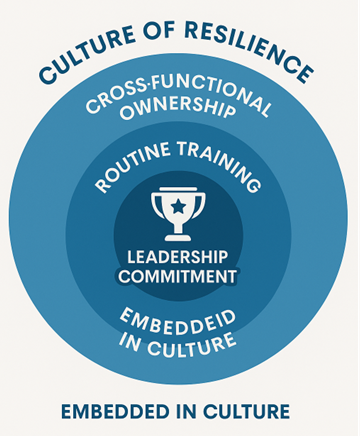

Case Study: The Resilient Manufacturer
A mid-sized manufacturer faced a supply chain disruption when a key international supplier was hit by a cyberattack, halting deliveries of critical components. Because the company had invested in the resilience cycle, it was able to quickly anticipate the broader impacts, activate backup suppliers (preparation), coordinate its crisis response across procurement, IT, and communications teams (response), restore production levels through alternate sources (recovery), and update its supplier risk assessments and contracts for the future (adaptation). The disruption, though costly, became an opportunity to strengthen relationships, diversify supply chains, and improve internal coordination.

Exercise: Mapping Your Resilience Cycle
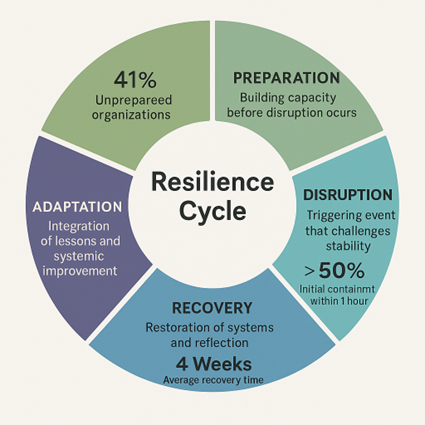

Course Manual 3: Cybersecurity vs. Cyber Resilience
In a world increasingly shaped by digital infrastructure, cybersecurity has become one of the defining responsibilities of modern organizations. From firewalls and multi-factor authentication to antivirus protocols and endpoint detection, companies have invested billions in building virtual defences. These systems form the digital perimeter-the first line of protection against an ever-growing catalogue of threats. But with each new breach, each leaked dataset, each ransom paid in cryptocurrency, a new question arises: Is security alone enough?
Cybersecurity has historically aimed to prevent harm. It is designed to block intrusion, detect anomalies, and ensure that systems remain intact and under control. Its mindset is rooted in defence-in the hope that, with enough vigilance and investment, we can keep attackers out and our systems safe. And yet, even the most heavily secured organizations are being breached. Even well-defended networks can be brought to a halt. The uncomfortable truth is that while cybersecurity is essential, it is no longer sufficient. In today’s hyperconnected environment, the goal must expand. We must ask not only how we protect systems, but how we continue functioning when protection fails. This is the realm of cyber resilience.
Cybersecurity and cyber resilience are often used interchangeably in headlines and boardrooms. But in practice, they represent different ways of thinking. Cybersecurity is about control: stopping threats, plugging holes, enforcing rules. Cyber resilience is about continuity: preparing for disruption, maintaining critical operations, and recovering quickly when things go wrong. Think of cybersecurity as building a strong ship-one designed to weather storms. Think of cyber resilience as training the crew-ensuring they know what to do when water comes over the side, or when the engine fails mid-ocean. One focuses on strength, the other on survivability. Where cybersecurity asks, “How do we keep them out?”, cyber resilience asks, “What happens when they get in?” Where one aims to prevent failure, the other assumes failure is inevitable-and builds readiness around that reality.
Cybersecurity is still vital. But resilience steps in when certainty ends. It doesn’t seek perfection. It seeks adaptability. And in a world of complex, unpredictable digital risk, adaptability is becoming the ultimate asset. One of the most important insights to emerge in recent years is that resilience is not just a technical concern. It’s not a niche issue for CISOs or IT departments. When a cyberattack occurs, it’s the entire organization that suffers. Operations freeze. Revenue stops. Customers lose trust. Reputational damage spreads faster than any virus. And it’s not the firewalls that respond to crisis. It’s the leadership.
Boards now realize that cyber resilience belongs in strategic planning. General counsels realize that data protection is a regulatory obligation. Communications officers understand the risks of silence or missteps under public pressure. Human resources feels the weight of internal uncertainty. Every part of the organization plays a role in resilience-and that’s why it must be addressed cross-functionally. Resilient organizations understand this. They move beyond the illusion that security is enough. They ask: If we’re hit tomorrow, who leads? What fails first? What do we protect at all costs? Who needs to know what-and when?
These are not technical questions. They’re leadership questions. Governance questions. Cultural questions. Cyber resilience starts with awareness. It grows through preparedness. And it becomes real in the moment of disruption-not because the threat was avoided, but because the organization is ready to act. There are countless examples of companies that were technically secure-and still fragile. They had the tools but not the coordination. They had antivirus software but no crisis playbook. They had backup systems-but didn’t know how to access them under pressure. The tools were there. The human readiness was not.
This kind of fragility reveals itself in hesitation. In unclear chains of command. In the absence of a spokesperson. In delays to notify stakeholders. In teams waiting for permission rather than acting with purpose. It reveals itself when organizations confuse compliance with capability. By contrast, resilient organizations prepare not just for threats, but for decisions. They train cross-functional teams. They map their dependencies. They rehearse difficult scenarios and stress-test their own assumptions. They may still be hit-but they don’t freeze. They understand that resilience is not just about having a plan. It’s about making sure the right people can carry it out, under pressure, with clarity.
Let’s be clear: security is essential. Without it, there is no baseline of safety. But security without resilience is incomplete. A company may be fully patched, encrypted, and monitored-but still unable to respond when an incident occurs. If legal doesn’t know when to escalate, if leadership can’t communicate under pressure, if employees don’t know their role in a breach scenario, then the organization is not resilient. It is only secure-until it isn’t.
Resilience starts with a shift in mindset. It asks: What if this happens to us? Are we ready? It moves the conversation from avoidance to response-from resistance to recovery. And it equips leaders to act, not just protect. Cybersecurity often focuses on numbers: number of vulnerabilities patched, threats blocked, firewalls updated, attacks prevented. These are useful-but they measure what didn’t happen. Resilience measures what comes next. A resilient organization tracks its ability to detect, respond, and recover. It looks at recovery time. Communication speed. Stakeholder trust. Decision-making under pressure. Cross-team coordination. These are harder to quantify, but essential to resilience. They measure capability under stress-not just performance in peace.
This is not an argument against cybersecurity. It’s an argument for completeness. Cyber resilience does not replace security-it completes it. It fills the gap between prevention and recovery. It prepares for the moment when the unexpected arrives, and the rules no longer apply. When organizations understand this, everything changes. Planning shifts from silos to systems. Crisis simulations become cross-departmental. Cyber risk becomes a shared language-not a technical burden. Leadership stops hoping for the best-and starts preparing for the real.
This shift doesn’t require endless investment. It requires awareness, coordination, and practice. It requires leaders to ask better questions. And it requires organizations to build the muscle to move-even when systems fail. Cybersecurity protects. Cyber resilience prevails.
In a world where digital infrastructure forms the backbone of nearly every industry, the traditional boundaries between cybersecurity and cyber resilience have become increasingly important to understand-and to question. While both terms are often used interchangeably in headlines and meetings, their underlying philosophies, goals, and practical implications are fundamentally different. Recognizing this distinction is not just a matter of semantics; it shapes how organizations plan, invest, communicate, and ultimately survive in a threat-laden environment.
Cybersecurity, at its core, is about prevention and protection. The goal is to keep threats at bay-to build strong digital walls, detect intrusions, patch vulnerabilities, and enforce strict access controls. Cybersecurity professionals focus on minimizing the attack surface, monitoring for anomalies, blocking malicious traffic, and maintaining the integrity of systems and data. The language of cybersecurity is one of defence, control, and compliance. Metrics often revolve around the number of attacks blocked, the percentage of systems patched, or the frequency of security audits. The underlying assumption is clear: If we build a strong enough perimeter and remain vigilant, we can keep attackers out and our systems safe.
Cyber resilience, by contrast, begins where cybersecurity ends. It accepts the uncomfortable reality that no system is invulnerable, no defence is perfect, and that breaches, disruptions, and failures are not just possible but inevitable. Cyber resilience asks a different set of questions: How do we maintain essential operations when protection fails? How do we detect and contain attacks that slip through our defences? How do we recover quickly, communicate transparently, and adapt in the aftermath? Cyber resilience is about continuity, agility, and learning. It is rooted in the understanding that disruption is a normal part of the digital landscape and that organizations must be prepared to operate in imperfect, unpredictable conditions.
The analogy is often made to building a ship and training its crew. Cybersecurity is like making the hull as strong as possible-resilient to leaks, reinforced against storms. Cyber resilience is about ensuring the crew knows what to do when the storm hits, the hull is breached, or the engine fails mid-voyage. It’s not enough to have a strong ship; you need a trained, adaptive team to keep it afloat in a crisis.
This distinction is more than theoretical. In real-world incidents, we see time and again that even organizations with robust cybersecurity investments are not necessarily resilient. They may have advanced tools-firewalls, intrusion detection systems, encryption-but lack the cross-functional coordination, practiced crisis playbooks, or leadership clarity to respond effectively when things go wrong. Conversely, some organizations with modest technical defences demonstrate remarkable resilience because they have cultivated a culture of preparedness, teamwork, and rapid decision-making.
A critical insight of the last decade is that cyber resilience is not just an IT issue-it is a strategic, enterprise-wide concern. When a major incident occurs, it is not only the IT team that must act. Legal, communications, operations, human resources, and leadership all have vital roles. Customers, partners, regulators, and the public demand answers and expect continuity. The days when cyber risk could be “left to the experts” are over. Boardrooms now recognize that cyber resilience belongs at the center of strategic planning, risk management, and corporate culture.
True resilience starts with a shift in mindset-from the illusion of absolute control to the embrace of uncertainty and preparation for the unexpected. This mindset does not diminish the importance of security; rather, it complements and completes it. Organizations need robust defences, but they also need agility, transparency, and the capacity to learn from each incident. Resilience means moving from a culture of blame and denial to one of openness and improvement. It means acknowledging that “if” is no longer the question-only “when,” and how ready we are to respond.
Measuring resilience is fundamentally different from measuring security. Traditional security metrics focus on what did not happen: the number of attacks prevented, vulnerabilities closed, or compliance boxes ticked. Resilience metrics, on the other hand, measure what comes after disruption: recovery times, effectiveness of communication, speed of decision-making, coordination across teams, stakeholder trust, and lessons learned. These are harder to quantify, but they tell the real story of an organization’s capacity to function under pressure.
The evolution from security to resilience also has profound implications for investment, training, and leadership. It requires organizations to invest not only in technology but also in people, processes, and culture. Crisis simulations, cross-departmental exercises, after-action reviews, and transparent reporting become central elements of the resilience strategy. Organizations that succeed in building resilience develop muscle memory-they don’t just hope for the best, they prepare for the worst and practice their response.
In today’s world, the question is no longer whether security or resilience is more important. The answer is both. Security is the foundation-resilience is the bridge to recovery and adaptation. Together, they form a complete, adaptive system for surviving and thriving in the digital age.
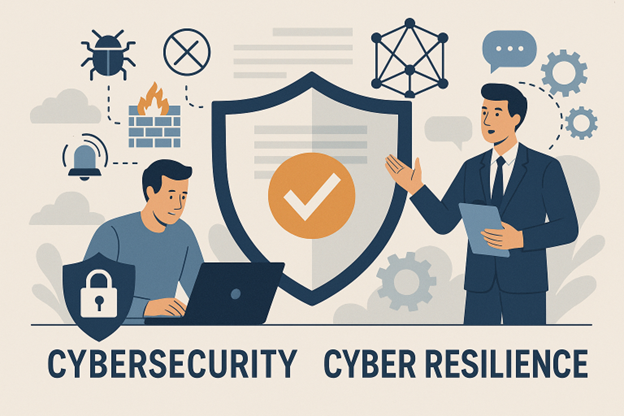

Case Study: The Email That Shut Everything Down
It started with a single email-an innocent-looking invoice attachment opened by an employee in a mid-sized manufacturing company. Within minutes, ransomware encrypted the entire network: access to files, production schedules, and payroll data was lost. The attacker demanded a cryptocurrency ransom.
The company had invested in technical controls: antivirus software, endpoint protection, multi-factor authentication. But the real test began after the breach. There were no clear roles for incident response; the IT lead was on vacation; no one knew who should inform the CEO; legal and communications were contacted too late. Two days passed before a coordinated response began. By then, clients had been lost, regulators notified late, and recovery took weeks-while trust suffered even longer.
Three weeks later, a smaller company faced a similar attack. They had weaker security, but a well-rehearsed incident response plan. Employees recognized the threat, immediately alerted leadership, and the crisis team responded. Communications went out quickly, operations were restored within 36 hours, and the company never paid the ransom. Their transparency earned respect, and the story disappeared from headlines.
Both companies faced the same threat-one was secure, but not resilient. The other, less secure, but ready.

Exercise: Cybersecurity vs. Cyber Resilience – Where Are You Now?
Present the case study to the group-read aloud or in writing. Prompt participants: What went wrong in the first company? What went right in the second? Which parts of the resilience cycle are visible? How did mindset and preparation make a difference? Discuss the contrast between technical defence and systemic readiness.
Each participant answers privately:
Participants are invited to share answers in small groups.
Small groups discuss:
What small actions could move us toward resilience?
The discussion is a starting point for awareness and next steps.
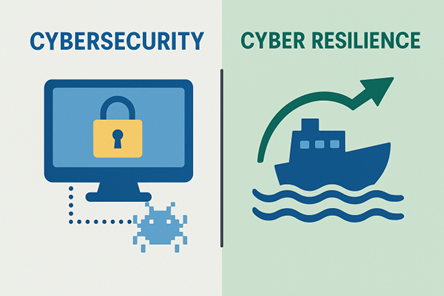

Course Manual 4: Anatomy of a Crisis
A crisis never arrives fully formed. It grows. It spreads. It morphs from a minor disruption into something larger, more dangerous, more consequential. One moment you’re facing a technical issue. The next, your systems are offline, your customers are demanding answers, your teams are overwhelmed, and your leadership is struggling to keep up. A crisis is not simply an event. It is a process-one marked by specific phases, inflection points, and decision moments that shape everything that follows. To build resilience, we must understand that process. We must learn to see the shape of a crisis before it reaches its peak. We must understand the anatomy.
The anatomy of a crisis is the anatomy of escalation. Disruptions do not become crises overnight. They evolve through stages, and with each step, the costs, the visibility, and the emotional intensity increase. But escalation is not only about the external situation. It is also about internal response. How we detect, interpret, and act on early signals will either contain escalation-or amplify it. In that sense, a crisis is not just something that happens to us. It is also something we allow, through blindness, inertia, or misjudgement. The study of crisis escalation is therefore a study of systems under stress-and of leadership under pressure.
Understanding the anatomy of a crisis means recognizing the early warning signs, anticipating the patterns of spread, and being able to act decisively before the tipping point is reached. It also means understanding the human dimension: how fear, confusion, and silence shape the crisis as much as any technical failure. In this course manual, we will walk through the phases that many crises follow-from early disruption to full-blown organizational emergency. The goal is not to create fear, but clarity. If we can see the pattern, we can shape the response. If we can name the stage, we can prepare the move. This is not about theory. It is about practice. It is about understanding what actually happens in the moments that matter-and how to lead through them.
Disruption: The Moment Something Breaks
Every crisis starts with a disruption. Something breaks. Something changes. Something happens that was not supposed to happen. It may be obvious-a server crashes, an unauthorized file is accessed, a suspicious email spreads across the network. Or it may be subtle-an outage that lasts too long, a phone call that no one returns, a strange pattern in the monitoring logs. Disruptions are the first spark. But a spark only becomes a fire if left unchecked.
The danger of the disruption phase is its ambiguity. In many organizations, early signs are misinterpreted or dismissed. Teams wait for more data. People hesitate to speak up. There is hope that the issue is temporary, that it will resolve itself. This delay-the hesitation to acknowledge that something serious may be happening-is one of the most common failure points. In resilient systems, disruptions are treated seriously from the outset. Not with panic, but with discipline. The first response is to investigate, escalate, and assess impact. A disruption may be small. But the time to act is before it becomes big.
Escalation: From Incident to Crisis
If the disruption is not contained-or if it is mishandled-it escalates. Systems that were degraded become inoperable. Functions that were slowly become completely unavailable. What was a technical issue becomes a business problem, a reputational threat, a leadership test. Escalation is the phase where responsibility expands. More people get involved. More decisions are needed. More visibility means more scrutiny. Suddenly, the organization is not just managing a problem-it is under pressure.
Escalation is often driven by three forces: scope, speed, and stakes. Scope refers to how many systems or stakeholders are affected. Speed is about how fast the situation is evolving-faster than the team can keep up. Stakes are about consequences-regulatory, reputational, legal, or human. When all three increase together, escalation becomes inevitable. In this phase, coordination is everything. The key questions become: Who is leading? What is the plan? Who needs to be informed-and when?
Leadership must move from technical troubleshooting to strategic response. The shift from IT-led to organization-led decision-making must happen quickly. One of the clearest signs of a resilient organization is its ability to shift gears during escalation-recognizing that a different kind of leadership is now required.
Confusion: The Space Where Mistakes Are Made
With escalation comes confusion. Roles are unclear. Information is incomplete. Pressure mounts. People make assumptions. Communication becomes scattered. Some teams overreact. Others go silent. In this chaos, mistakes happen-not because people are incompetent, but because the system was not designed to handle the stress.
In this phase, the biggest risks are not technical-they are human. Miscommunication, duplication of effort, emotional overreaction, lack of psychological safety. Teams may be afraid to speak up. Individuals may feel frozen. If the organization has not practiced crisis communication, the default will be improvisation-and that rarely goes well. The confusion phase is where a crisis either stabilizes or spirals. It is also where leadership presence matters most. Not just giving answers but creating calm. Not just fixing systems but aligning people. Leadership must re-establish rhythm: regular updates, clear priorities, transparent decision-making. This is where trust either grows-or collapses.
Visibility: When the Outside World Notices
If confusion is not resolved quickly, the crisis becomes visible. Customers notice. Partners ask questions. The media starts calling. Regulators send inquiries. Visibility changes the stakes. Suddenly, internal failure becomes external story. This is the moment where organizations are judged-not just on the original issue, but on how they respond. Visibility is often where legal and communication teams are pulled in. It is also where public trust is won or lost. Transparency becomes critical. So does timing. Saying too little invites speculation. Saying too much too soon invites risk. The goal is not to spin the narrative-it is to lead it. The crisis is now on stage. And the question is: will the organization act with coherence, honesty, and professionalism?
Decision: The Moment of Truth
Every crisis contains a decision moment. A turning point. A place where the path forward depends on a clear, confident choice. Sometimes that decision is operational shut the system down or keep it running. Sometimes it is legal – disclose or investigate further. Sometimes it is strategic – own the error or shift the blame. These are the moments that define leadership. They are also the moments that most test readiness. If decisions are delayed, the crisis drifts. If decisions are made in isolation, alignment fractures. But if decisions are made quickly, visibly, and with integrity, the organization stabilizes – even under pressure.
These decision moments must be prepared in advance. Not in their specifics, but in their structure. Who decides what? What authority do they have? What principles guide them? What support do they receive? Crises cannot be managed entirely by plan-but decisions can be structured by principle. This is what makes a resilient system different. It can move fast without chaos. It can act boldly without arrogance. Because the structure is there-even under strain.
Aftermath: Recovery or Residue
Eventually, the immediate crisis passes. Systems are restored. Communications are quiet. The pace slows. But the work is not over. This is the aftermath. And what happens here determines whether the organization truly recovers-or carries residue into the next crisis. The aftermath is where learning must happen. Not just technical post-mortems, but cultural reflection. What worked? What didn’t? What surprised us? What hurt us? Where were we vulnerable? Who stepped up? Who was silent?
The aftermath is where new strategies are born. New capabilities are built. New values are reinforced-or forgotten. It is also where resilience either deepens-or decays. If the organization moves on too quickly, it will forget. If it stays in fear, it will stagnate. The balance is to learn deeply-and move forward. To integrate the experience into new routines. And to signal to the organization: we are better now, not just luckier.
Crisis as Pattern, Not Surprise
The power of understanding crisis anatomy is not in avoiding crises altogether. That is not realistic. The power is in recognizing patterns. Once we see the shape, we can act earlier. Once we name the stage, we can adapt our leadership. Crisis becomes less about fear-and more about readiness. It becomes something we can talk about, train for, and improve together. This is what mature organizations do. They name the realities others avoid. They plan for the phase’s others pretend won’t come. And when disruption arrives, they are already moving.

Case Study – “Friday Afternoon”
It was a Friday afternoon when the call came in. A mid-level manager in a regional finance office had noticed something strange: multiple client files had been accessed by an unfamiliar user ID. It looked minor, maybe a permissions error. He logged a ticket and went home. No one responded until Monday. By then, the breach had grown. Sensitive financial data had been copied. The source was an external contractor’s laptop, infected via USB. Over the next two days, internal systems were reviewed. The security team debated disclosure. Leadership asked for more details before authorizing a press statement. Meanwhile, the news leaked. A journalist contacted the press office. Customers began receiving scam emails. By Wednesday, the incident had gone public. By Friday, the CEO had to step in personally to calm stakeholders.
What began as a minor disruption became a full-blown organizational crisis. Not because of malicious intent-but because of hesitation, unclear roles, slow escalation, and fragmented response. The damage was not just technical. It was cultural, reputational, and human.
Every organization hopes to avoid crisis, but the reality is that crises-large and small-are a constant feature of our complex, interconnected world. Whether triggered by cyberattacks, natural disasters, operational failures, reputational scandals, or global pandemics, a crisis has a recognizable anatomy: a series of stages through which an initial disruption can escalate, spiral, or be contained. Understanding these stages is essential for building genuine resilience, because the speed and quality of an organization’s response at each phase often determines whether the event is a recoverable incident or a catastrophe.
A crisis typically begins not with a single dramatic event, but with a disruption-a deviation from normal operations. This can be a technical failure, a cyber breach, an external shock, or an unexpected shift in the market. At this earliest stage, the disruption may not even be recognized as serious. Signals are often weak: an anomaly in the system, an error message, a rumor, or a complaint. Many crises could be averted or contained at this point, but only if organizations are vigilant and empowered to act on early warning signs.
If the disruption is not recognized or effectively addressed, it can escalate. This escalation is often marked by delay, denial, or misdiagnosis. Key stakeholders may hope the problem will resolve itself, underestimate its scope, or fear raising an alarm. Internal reporting channels may be unclear, or responsibility diffuse. In cyber incidents, for example, the breach might go undetected for days or weeks – while attackers move laterally, gain access, and escalate their privileges. Each hour of inaction increases the potential cost.
The crisis enters a new phase as the scale becomes apparent – often triggered by a sudden, visible consequence: a service outage, media report, regulatory inquiry, or customer backlash. At this point, the event becomes a true crisis – an existential threat to operations, reputation, or survival. The pressure mounts on leaders to respond, and decisions must be made quickly, often with incomplete information. It is here that the strengths and weaknesses of prior preparation are most visible.
A hallmark of effective crisis management is the ability to move from chaos to coordination. Leadership must be visible and decisive; roles and responsibilities must be clear; communication must be frequent and credible. Teams must gather facts, triage the situation, prioritize what is most critical, and act with unity. In organizations that lack practice or structure, this is where confusion, blame-shifting, or paralysis can occur. Precious time may be lost debating minor details or waiting for permission to act. Silos become entrenched, and misinformation spreads.
As the crisis unfolds, the organization faces a series of inflection points: moments when the right decision or timely action can stop the escalation-or when a misstep can deepen the crisis. These turning points require clarity, competence, and often, courage. One of the most common failure modes is mismanagement: either through overconfidence (“this can’t be that serious”), underreaction (“let’s wait and see”), or overreaction (taking drastic actions without understanding the consequences). Leaders may be tempted to hide bad news, delay communication, or ignore frontline concerns. Such mistakes can erode trust, worsen the impact, and prolong recovery.
Eventually, the acute phase of the crisis subsides. The organization shifts from emergency response to stabilization and recovery. Here, the focus turns to restoring operations, supporting affected people, learning from mistakes, and rebuilding reputation. The post-crisis period is also when the seeds of the next crisis are often sown: if organizations treat the event as a one-off anomaly, or revert to business as usual without adapting, they remain vulnerable to repeat scenarios.
Crisis escalation is rarely linear. It may surge and recede, be contained in one part of the organization while flaring up in another or be driven by external factors such as the media or regulators. In the digital era, crises unfold in real time, under intense public scrutiny, and with the potential for rapid amplification through social media and instant communication. This makes preparation, clarity, and practiced routines more important than ever.
To manage crisis escalation, organizations must invest in early detection, empowered reporting, and a culture that rewards transparency over blame. Clear escalation protocols, predefined thresholds for action, and regular simulation exercises help teams develop muscle memory for crisis moments. Just as important is the willingness to debrief honestly after each incident, so that lessons are embedded for the future.

Case Study: Sony Pictures – Anatomy of an Escalating Crisis
In late 2014, Sony Pictures Entertainment became the victim of one of the most devastating corporate hacks in history. The attackers, later linked to North Korea, spent months inside Sony’s network, quietly exfiltrating data. The first visible sign was a chilling image on employee computers, warning that confidential data had been stolen and would be released if demands were not met. What followed was a cascade of escalation: systems were shut down, films and emails were leaked, employees’ personal information was exposed, and the company was plunged into a global media storm. Leadership struggled with unprecedented decisions – how to respond to ransom demands, whether to cancel a major film release, and how to communicate with employees, customers, and the world. The attack had far-reaching consequences for Sony’s finances, reputation, and culture, and forced organizations everywhere to rethink their own crisis escalation protocols.

Exercise: Mapping the Sony Crisis – Stages and Turning Points
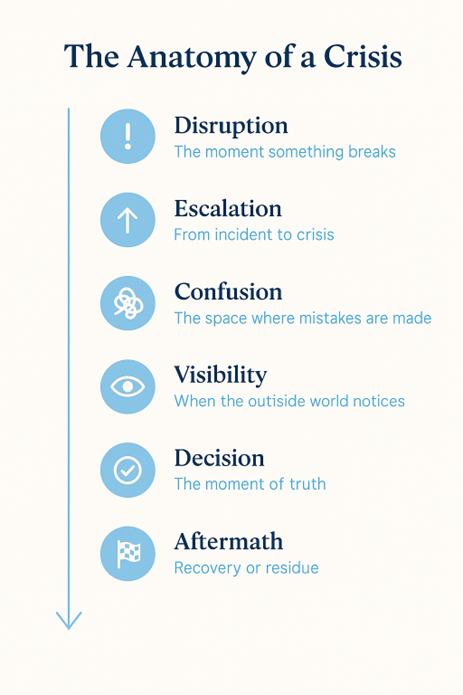

Course Manual 5: Resilience Evolution
Resilience is one of the most invoked terms in modern organizational life. Governments commit to it, consultants promise it, leaders reference it, and entire industries claim to need more of it. But the word itself has travelled a long way. It is used in boardrooms, battlefields, disaster zones, classrooms, hospitals, and technical control rooms. At its core, resilience is a way of thinking and acting that transcends sector, discipline, and language. It speaks to the fundamental question: how do we continue when things go wrong? When systems break, when certainty disappears, when the unexpected becomes reality-resilience is what determines whether we collapse, survive, or evolve.
The modern use of resilience is so widespread that its origins are often forgotten. Today, many people speak of it only in metaphor: bouncing back, staying strong, recovering quickly. But resilience is not just an emotional quality or a motivational slogan. It is a structural, functional, and strategic concept. It has roots in physics, military science, ecology, psychology, sociology, and risk governance. Its emergence across disciplines shows that resilience is not the product of a single ideology but the result of necessity-a response to the repeated observation that disruption is inevitable, and that adaptation is what makes survival meaningful.
The word resilience comes from the Latin verb resilire, meaning to rebound, to jump back, or to recoil. In early physical sciences, resilience referred to the property of a material to absorb energy and return to its original shape. A steel rod bent under pressure was resilient if it could spring back. A suspension bridge could be called resilient if it could flex under wind or load without snapping. This was a foundational idea in engineering: design not for rigidity, but for endurance. Not for perfection, but for persistence.
But as systems became more complex and disruptions more unpredictable, the idea of resilience began to evolve. No longer just about physical materials, it became a way to understand systems-particularly those that were dynamic, networked, and constantly exposed to change. One of the earliest fields to take resilience seriously was the military. Military leaders have long understood that war is inherently uncertain. As the strategist Carl von Clausewitz famously wrote, “In war, everything is simple, but even the simplest thing is difficult.” Military resilience emerged as a core doctrine not because generals feared disorder, but because they expected it. They knew that no plan survives first contact with the enemy, that battlefield conditions change in moments, and that rigid hierarchies often fail under real pressure.
In NATO doctrine and U.S. defence strategy, resilience became synonymous with mission continuity under duress. A base might be under attack. A supply chain disrupted. Communications severed. And yet, the mission had to go on. This required more than technical redundancy – it required cognitive flexibility, cross-functional coordination, and psychological readiness. War fighters were trained not just in skills, but in improvisation. Decentralized command structures, simulation exercises, fallback procedures, and chain-of-command clarity became central features. The aim was not to eliminate risk, but to withstand it, respond through it, and remain operational when others faltered. The logic was simple: prepare for what you cannot control and train your people to operate within chaos – not despite it, but because of it.
This military thinking began to influence civilian crisis management, especially in national emergency response systems. But at the same time, a different evolution of resilience was underway – in ecology. In 1973, Canadian ecologist C.S. Holling published a paper that revolutionized the way scientists thought about ecosystems. He defined resilience not as stability or resistance to change, but as the capacity of a system to absorb disturbance and reorganize while undergoing change, so that it still retains its function, structure, and identity. This idea was radical. It suggested that health in complex systems was not measured by how well they resisted shocks, but by how well they adapted without losing their integrity.
Ecological resilience introduced a shift in thinking: from controlling nature to living with it. From predicting every outcome to preparing for surprises. This influenced disaster risk management, climate adaptation, and urban planning. Cities, too, were systems. They had people, infrastructure, policies, and vulnerabilities. They could be flooded, burned, shaken, or attacked. And like ecosystems, they needed the capacity to adapt – to recover functionality even when specific structures failed. Urban resilience became a planning goal. It meant diversifying infrastructure, decentralizing energy, building social cohesion, and embedding flexibility into the governance of everything from public transport to emergency response.
In parallel, psychologists were discovering resilience in the human psyche. They studied individuals who, despite trauma, loss, or adversity, managed not only to survive but to grow. This wasn’t simple toughness. It wasn’t stoicism or denial. It was the capacity to cope, to seek support, to maintain agency. Resilience became a function of emotional regulation, meaning-making, attachment strength, and social environment. Importantly, resilience was not just a trait – it was a process. It could be cultivated. It could be learned. This insight changed how organizations approached leadership development, employee well-being, and team performance under stress.
The convergence of these disciplines set the stage for resilience to enter two domains where disruption was both likely and consequential: critical infrastructure and cyber systems. In the late 1990s and early 2000s, resilience became a key concern in national infrastructure policy. Planners asked what would happen if the power grid went down, if telecommunications failed, if supply chains were attacked. Resilience in this context meant identifying critical dependencies, building backup capacities, decentralizing control, and ensuring that no single point of failure could cripple the system.
Cyber resilience took shape shortly after. The digital world was expanding rapidly, but its underlying systems were fragile. Viruses, worms, insider threats, and later ransomware exposed a harsh reality: even secure systems could be compromised. And when they were, organizations needed more than firewalls. They needed continuity. Cyber resilience emerged as the next frontier-not to replace cybersecurity, but to complete it. It included threat detection, incident response, recovery protocols, and leadership integration. Resilience shifted the focus from prevention alone to continuity of operation under compromised conditions. The language changed again: not “how do we stop threats?” but “how do we continue functioning when they succeed?”
This shift in mindset began to reach the private sector. Resilience was no longer just a safety measure. It became a strategic differentiator. A company with resilience was a company that could handle market shocks, supply chain delays, social unrest, geopolitical tensions, or cyber incidents – without losing customer trust or operational integrity. Boards began asking new questions. Not just “are we secure?” but “are we ready?” Investors wanted to know not just about quarterly earnings, but about continuity and adaptability. Resilience appeared in annual reports. It was included in ESG metrics. It became part of executive KPIs.
Consulting firms responded by developing resilience maturity models. These frameworks measured not only technical safeguards but cultural readiness, decision-making clarity, leadership alignment, and communication flow under pressure. High resilience organizations weren’t just better at bouncing back. They were better at learning forward. They didn’t just have plans-they had people prepared to use them. They didn’t just have procedures-they had practiced responses.
The key insight across all these fields – from defence to ecology, from psychology to business – is that resilience is dynamic. It is not about returning to normal. It is about recovering, adapting, and evolving toward a new stable state. In systems terms, this is called “adaptive capacity.” In organizations, it is expressed through the ability to pivot, to reorganize resources, to maintain trust, and to operate under new conditions. What begins as recovery often becomes reinvention.
Today, resilience continues to evolve. It is deeply connected to the concept of agility. It is part of enterprise risk management. It overlaps with crisis leadership, strategic foresight, and organizational transformation. But most importantly, it reflects a deeper truth about reality itself: change is constant. Disruption is unavoidable. And preparedness is not a static plan, but an ongoing practice.
In that sense, resilience is not just a system property. It is a leadership principle. It is a culture. It is the decision to engage uncertainty with awareness instead of avoidance. To plan for impact instead of perfection. To lead under pressure, not only when things are smooth. And in the years ahead, as digital, environmental, geopolitical, and societal risks converge, resilience will not be optional. It will be what separates those who endure from those who decline. What distinguishes those who bend and adapt from those who break.
Resilience is a word that has become ubiquitous in modern management, public policy, and organizational development. But to truly grasp its significance, it is important to understand where the concept comes from, how it has evolved across different disciplines, and why it now sits at the center of strategy for organizations facing an age of constant disruption.
The roots of resilience lie in the Latin verb resilire, meaning “to leap back” or “rebound.” In the earliest scientific contexts, resilience referred to the physical properties of materials-their capacity to absorb shock and return to their original form after being stretched, bent, or compressed. Engineers used the term to describe metals or polymers that could withstand impact without breaking. This physical notion – of bouncing back after a disturbance-was the foundation for later conceptual leaps into human, organizational, and systemic resilience.
The military was one of the first institutions to expand the meaning of resilience. In the chaos of war, planners recognized that no battle plan survives first contact with the enemy. Systems would be attacked, communications disrupted, personnel scattered, and objectives upended. What determined success was not just the strength of defences, but the capacity to recover, adapt, and continue the mission despite adversity. Military resilience was about continuity under fire: redundancy in supply chains, flexibility in leadership, decentralized decision-making, and the psychological readiness of troops. Repeated exercises, war games, and debriefs ingrained resilience into doctrine-not because they predicted every scenario, but because they prepared leaders and teams to improvise, absorb losses, and find new solutions under stress.
In the 1970s, the concept made a parallel leap into ecology. The Canadian ecologist C. S. Holling defined resilience as the ability of an ecosystem to absorb disturbance and reorganize while undergoing change, so as to retain essentially the same function and structure. This was a radical departure from the old ideal of stability. Instead of resisting change, a resilient system could survive, adapt, and even transform in response to shocks. Holling’s work shaped later thinking about disaster risk, climate adaptation, and urban planning. Cities, like ecosystems, had to survive floods, fires, and breakdowns-without losing their basic character or viability. Diversity, redundancy, and decentralization became not signs of inefficiency, but necessary features for survival.
Resilience also found a home in psychology. In studies of trauma and child development, researchers observed that some individuals, despite severe adversity, managed to maintain or quickly regain stable mental health and functionality. These “resilient” individuals were not immune to pain, but they demonstrated remarkable capacity to cope, recover, and even grow from hardship. Factors such as supportive relationships, positive outlooks, flexible thinking, and the ability to seek help played crucial roles. Psychologists realized that resilience was not just a trait, but a process that could be developed, trained, and reinforced through experience and support.
By the late 20th and early 21st centuries, resilience began to influence risk management, business continuity, and-crucially-cybersecurity. As organizations became more dependent on digital systems, it became clear that no firewall, policy, or technology could provide absolute protection. Breaches, outages, and disruptions were inevitable. The new challenge was not just to prevent incidents, but to keep operating during and after them. Cyber resilience was born: the ability to detect, respond to, and recover from digital disruptions while minimizing impact on core missions and stakeholders.
In this context, standards bodies like NIST and ENISA began to define resilience not as a replacement for security, but as its necessary complement. Organizations needed strong defences, but also the capacity to absorb shocks, communicate clearly under pressure, and recover quickly. Business continuity plans, incident response teams, cross-functional crisis simulations, and post-incident reviews became best practices. Boards and leaders started asking: If the worst happens, can we keep running? Can we emerge stronger? Can we learn and adapt?
Today, resilience is recognized as a key pillar of long-term competitiveness. It is invoked not only in response to cyber threats, but also in the face of pandemics, geopolitical turmoil, supply chain shocks, and social unrest. Resilient organizations do not merely survive disruption-they treat it as a catalyst for learning, innovation, and renewal. They build feedback loops, decentralize authority during crises, foster open communication, and reward learning from mistakes. They see every disruption as both a risk and an opportunity.
Resilience is also a cultural and strategic capability. It is embedded in values, leadership behaviours, and organizational narratives. The most resilient companies treat it as a shared responsibility across all functions and hierarchies. They invest in relationships, cultivate trust, and focus on sustainable value-not just short-term gains. Resilience, in this sense, is both an operational discipline and a mindset for navigating the future.

Case Study – The Hospital That Kept Running
During a major cyberattack that disrupted public sector operations across an entire country, many organizations were paralyzed. Emergency services lost access to central databases. Government portals went dark. But one regional hospital stood out. While other facilities suspended operations and resorted to manual recordkeeping, this hospital stayed online. They didn’t rely on luck. They relied on preparation.
The hospital had invested in more than cybersecurity. They had invested in resilience. Months before the attack, they had conducted resilience workshops, mapped operational dependencies, clarified decision authority, and practiced escalation scenarios. Backup systems were not just installed – they were tested. Crisis teams were cross-functional and had trained together. When the ransomware hit, their systems switched over within minutes. Staff followed the protocol. Communications were transparent. Patients received uninterrupted care.
The lesson was clear: resilience was not a single product or policy. It was a culture of readiness. And in the face of national disruption, it made all the difference.
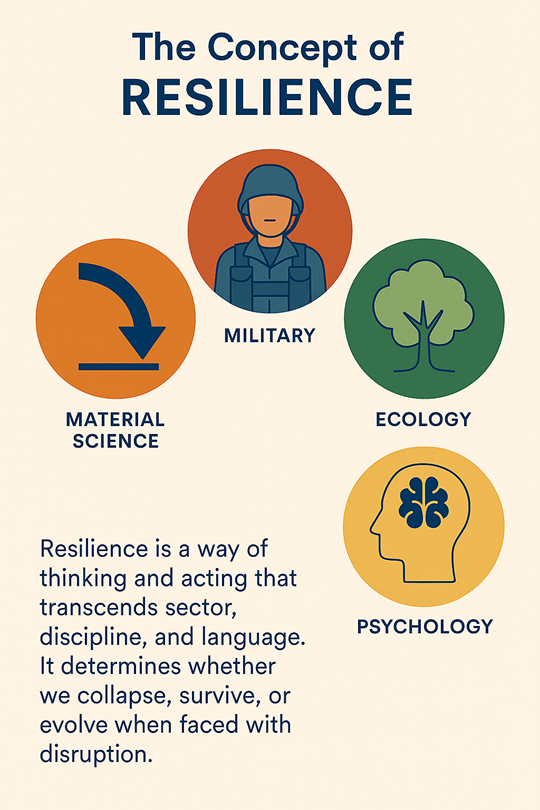

Course Manual 6: Organizational Structure
When a crisis strikes, most organizations don’t fail because of a lack of resources. They fail because of a lack of clarity. It’s not the breach, the outage, the fire, or the flood that causes the greatest damage-it’s the fog that follows. The fog of uncertainty about who is responsible, who is in charge, what should be said, when it should be said, and to whom. At the core of every effective crisis response is structure-not just boxes on an org chart, but living, practiced alignment between people, roles, responsibilities, and decision-making. A crisis-ready organization is not defined by the absence of disruption, but by the presence of coordination under stress. That coordination doesn’t begin in the moment of impact. It begins in design. Before a crisis unfolds, structure must already exist-not just on paper, but in the minds of those expected to act.
Organizational structure is the skeleton of resilience. It gives shape to how information flows, how people relate, how priorities are set, and how decisions are made. In stable times, structure may operate in the background. In crisis, it comes to the forefront. Its quality is revealed not by efficiency, but by elasticity. Can your structure stretch without snapping? Can it accelerate without collapsing? Can it distribute authority without losing control? These are the questions that separate reactive organizations from resilient ones. Crisis resilience is not an accident. It is architecture. And that architecture is built through governance, role clarity, reporting discipline, and cultural readiness.
Governance provides the framework for how decisions are made and who is accountable in complex, high-pressure environments. It is the rulebook, but also the rhythm. In resilient organizations, governance is not overly centralized or slow-moving. It is adaptive, transparent, and scalable. Good crisis governance ensures that decisions are made at the right level, at the right time, with the right inputs. That doesn’t mean every decision is correct. It means every decision is accountable. The goal is not perfection-it’s integrity under pressure.
Resilient organizations understand that normal governance structures are not built for emergencies. The same bodies that steer long-term strategy are rarely equipped to handle real-time disruption. That’s why high-reliability organizations establish alternate structures for crisis mode. These include dedicated Crisis Management Teams (CMTs), Tactical Response Cells, Emergency Operations Centers (EOCs), or cross-functional Resilience Hubs. These structures operate on different frequencies, with faster cycles, flatter hierarchies, and decision authority delegated closer to the action. Their function is not to replace existing governance, but to layer a parallel chain of command optimized for speed, clarity, and coordination.
Role clarity within these structures is non-negotiable. In too many organizations, roles are assigned in theory but never practiced in reality. People are listed on paper but don’t know their function. Alternates are named but never trained. This leads to silence in critical moments, with everyone waiting for someone else to act. Resilient teams avoid this by embedding role awareness into routine. They rehearse roles, they rotate responsibilities, and they confirm expectations. Every person involved in crisis response should be able to answer: What is my task? Who do I report to? What decisions am I authorized to make? Who do I support? Who supports me? These questions should not only be clear-they should be second nature.
Clear roles must also reflect organizational complexity. In matrixed environments, individuals may report to multiple leaders, participate in overlapping teams, and carry dual responsibilities. In a crisis, this can paralyze action. That’s why crisis structures often override the matrix with temporary authority lines. A logistics manager may report directly to the crisis lead. An HR director may work under a unified communications cell. These adjustments should be predefined and communicated in advance-not invented mid-response.
Another overlooked element of structure is the flow of information. Reporting lines are the veins through which situational awareness circulates. Without them, leadership becomes blind, frontline responders become isolated, and stakeholders become misinformed. Resilient organizations build fast, functional reporting channels that are short, looped, and agile. These channels allow for upward escalation, lateral coordination, and downward communication simultaneously. They ensure that insights from one team can reach others in minutes-not days. They prevent duplication, miscommunication, and silence.
Technology supports this, but it does not guarantee it. Too many crisis structures rely solely on tools-dashboards, chat apps, email alerts-without verifying the human behaviours behind them. What happens when the dashboard freezes? When the VPN fails? When the crisis occurs during a holiday or night shift? Reporting must work under stress, under constraint, and under imperfect conditions. That means contact lists printed in advance. It means escalation trees that don’t depend on a single person. It means analog backups that feel like overkill-until the moment they’re not.
One of the most powerful elements of structure is rhythm. In crisis, people look for pattern, predictability, and pacing. The most effective crisis teams operate in defined time blocks. They conduct standups every 30 minutes. They align every 60. They brief stakeholders every two hours. This rhythm creates movement. It prevents drift. It keeps people focused and connected. It gives structure to stress.
Leadership, of course, sits at the heart of structure. But leadership in crisis does not mean command-and-control. It means command with compassion, clarity, and confidence. The best crisis leaders know how to step forward without suffocating the team. They ask questions before giving orders. They listen before instructing. They absorb stress without passing it down. They stay visible without micromanaging. Their strength is not in knowing all the answers-but in creating the environment where others can act.
Leadership presence must be matched by leadership distribution. In large organizations, no one person can manage everything. Authority must be delegated wisely. This requires trust, training, and shared standards. A good leader sets the tone. A great structure allows that tone to be echoed across sites, functions, and time zones. The goal is coherence, not control.
Failures of structure are often subtle before they are catastrophic. A message missed. A handover fumbled. A report delayed. These moments add up-until the crisis outpaces the response. That’s why stress-testing your structure is as important as designing it. Tabletop exercises, scenario planning, and red-teaming reveal where the cracks are. They expose hidden assumptions. They show where information gets stuck. They reveal how quickly escalation actually happens – not how quickly it should. Crisis structure also includes decision frameworks. These are tools like FORDEC, OODA loops, or predefined decision matrices. They help reduce cognitive overload under stress. They allow teams to act based on principles, not panic. They align decisions with organizational values and strategic priorities. Most importantly, they prevent paralysis. In the absence of a framework, decisions are delayed, delegated endlessly, or driven by fear. A framework gives people the confidence to act-and the organization the ability to adapt. Structure also protects the brand. In crisis, perception is shaped by behaviour. If communication is delayed, the organization looks evasive. If messages contradict, the organization looks dishonest. If actions lag, the organization looks disorganized. But when structure is strong-when messages are aligned, when leaders speak with one voice, when updates are timely and accurate-the organization appears in control, even when reality is uncertain. Structure doesn’t eliminate risk, but it contains chaos. It provides a platform for credibility. There is also an emotional dimension to structure. People need to know where they stand. In a crisis, ambiguity is the enemy of morale. Clear structure gives people a place, a purpose, and a path. It reduces anxiety. It channels fear into function. It reminds teams that while the situation is unstable, the system is not. This is especially true for frontline responders, customer-facing staff, and junior team members who often bear the emotional brunt of disruption. A strong structure shields them-not from the situation, but from unnecessary uncertainty.
Crisis structure should also include external interfaces. Who talks to the media? Who engages with regulators? Who communicates with vendors, clients, or partners? These roles must be named and trained. Too many organizations forget that crises are not only internal. They are public. They are political. They are relational. A strong internal structure must be mirrored by a strong external interface-one that maintains trust, avoids liability, and reinforces the organization’s integrity.
Finally, structure is not built once. It evolves. It must be updated, refined, and recommitted regularly. As teams change, as risks emerge, as lessons are learned – structure must adapt. It is not a fixed document, but a living capability. Every crisis is an opportunity to tune the system. Every after-action review is a moment to rebuild stronger.
Behind every resilient organization lies a well-designed structure that enables rapid, coordinated, and effective action in the face of crisis. Structure is not just an organizational chart-it is the network of relationships, communication channels, and decision rights that determine how information flows, who makes critical calls, and how quickly an organization can pivot when the unexpected occurs. A strong, adaptable structure is the backbone of crisis readiness and a key driver of resilience.
Organizational resilience starts long before a crisis hits. It is built into the DNA of an organization through clear governance, transparent reporting lines, and explicit role definitions. These elements are more than bureaucratic necessities-they form the operating system that either empowers people to act or traps them in confusion and delay. In times of stability, weaknesses in structure may go unnoticed. But in a crisis, every ambiguity or gap is exposed and magnified.
Effective governance is at the heart of readiness. It defines how decisions are made, who is accountable, and what checks and balances exist. Resilient organizations establish governance models that balance central authority with local autonomy, allowing rapid escalation of critical issues while empowering frontline teams to respond within clear parameters. This blend of centralized oversight and decentralized action is especially vital in crises, where time is short and information incomplete.
Reporting lines must be explicit and known to all. During a cyber incident, for example, it should be immediately clear who reports to whom, who can activate a crisis team, who must be informed, and who has authority to communicate externally. Ambiguity in reporting lines can lead to dangerous delays, missed handoffs, and conflicting messages. Resilient organizations invest in mapping these lines, updating them regularly, and rehearsing their use in simulations and drills.
Role clarity is another cornerstone. Every member of a crisis team must understand their responsibilities, the boundaries of their authority, and the expectations placed on them. This clarity enables swift action without confusion, hesitation, or duplication of effort. In resilient organizations, role clarity is not limited to formal titles. It extends to informal leaders, subject matter experts, and trusted external partners who may be called upon in high-stress situations.
The structure of a crisis management team itself is a vital consideration. A resilient crisis team is multidisciplinary, bringing together expertise from IT, legal, communications, operations, HR, and executive leadership. Each role is mapped to specific tasks: technical containment, regulatory compliance, public messaging, stakeholder engagement, business continuity, and so on. The team must also be scalable – able to expand or contract as the situation evolves. Predefining alternates or deputies ensures continuity if a key player is unavailable.
Crisis readiness also requires practice. Even the best-designed structures can fail if untested. Regular tabletop exercises, simulations, and after-action reviews help teams internalize roles, pressure-test reporting lines, and uncover weak spots before a real crisis strikes. These exercises must be realistic and challenging, not mere box-ticking exercises. The goal is to foster confidence, build relationships, and turn procedures into instinctive actions.
One often-overlooked element of structure is integration with external partners. In today’s interconnected environment, no organization stands alone in a crisis. Vendors, regulators, law enforcement, insurers, and communications experts may all need to be involved at short notice. Resilient organizations pre-identify these contacts, clarify lines of engagement, and even involve external parties in joint exercises. Knowing who to call – and being known in return – can be the difference between timely containment and uncontrolled escalation.
Structure also extends to information management. During a crisis, information must flow quickly but securely: not only upward to leadership, but outward to partners and downward to all employees. Clear protocols for information sharing, document management, and decision tracking are essential. In the fog of crisis, the organization with clear, practiced information flows has a distinct advantage.
A resilient structure is not static. It is regularly reviewed, adapted, and improved considering new threats, business changes, and lessons learned. The best organizations make structural improvement a routine part of post-incident reviews. They reward openness about flaws and celebrate improvements, creating a culture where structure is seen as a living system rather than a rigid hierarchy.
Ultimately, organizational structure is both an enabler and a safeguard. It provides the scaffolding for rapid response, ensures accountability, and protects the organization from chaos when the pressure is on. Leaders who prioritize governance, reporting lines, and role clarity create the conditions for resilience to flourish-not just in a crisis, but every day.
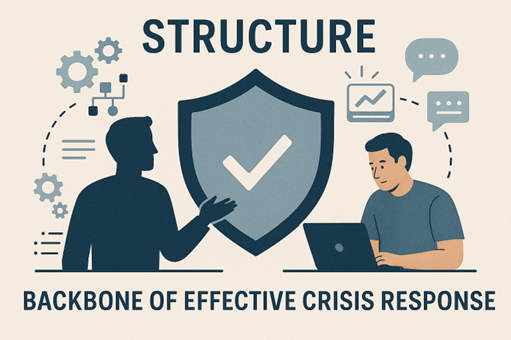

Case Study – The Power Grid Blackout
When a nationwide heatwave triggered cascading failures in the European power grid, the impact was immediate. Millions without electricity. Transportation disrupted. Hospitals under emergency protocols. But what stood out was the difference in how energy providers responded. In the south, delays in communication caused confusion between field teams and executives. Reports were outdated. The crisis lead was unreachable. Emergency plans existed – but no one activated them. Local managers improvised, but without coordination, efforts clashed. The result: public frustration, political pressure, and reputational damage.
In contrast, one northern utility had prepared. Their structure was crisp. A Crisis Response Cell was activated within ten minutes. Functional leads knew their roles. Field engineers had direct lines to the command team. Communication was clear and coordinated. Regulators were updated hourly. Customers received regular alerts. Power restoration proceeded by grid zone, not guesswork. Within 24 hours, services were stable. The difference was not in funding or scale. It was in structure – and the rehearsal of that structure long before the lights went out.

Case Study: The Incident That Exposed the Lines
A multinational company faced a ransomware attack that locked critical data and threatened global operations. The IT team acted swiftly, but confusion soon emerged: Who should inform the executive team? Who would handle regulatory notifications in each country? Who had authority to engage external forensics? The organization had grown rapidly, and reporting lines were unclear. Valuable hours were lost as teams debated responsibilities. In the aftermath, the company mapped all critical roles, clarified escalation paths, and practiced response protocols – turning a painful lesson into a new structural strength.

Exercise: Role Clarity Drill
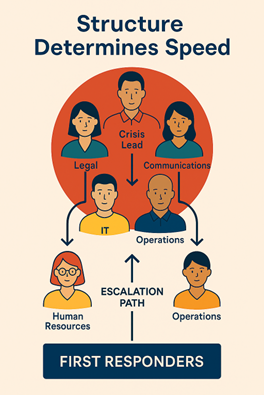

Course Manual 7: Resilient Command Model
Resilience in crisis does not happen by accident. It is the result of deliberate design-of building structures, processes, and cultures that enable organizations to respond quickly, adapt wisely, and lead decisively when the unexpected occurs. At the heart of this design is the crisis management team (CMT): a core group entrusted with navigating the storm, protecting what matters most, and ensuring that the organization emerges intact and, ideally, improved.
The crisis management team is more than a technical task force. It is the embodiment of an organization’s collective will to confront disruption, coordinate complex actions, and communicate with clarity under intense pressure. The structure, scope, and scalability of the CMT are the foundation for resilient leadership and effective crisis navigation.
Structure: A resilient CMT is cross-functional, bringing together individuals with diverse expertise and authority. Typical roles include the incident commander (overall decision-maker), IT lead (technical containment and recovery), legal counsel (compliance and regulatory interface), communications lead (internal and external messaging), operations manager (business continuity), human resources (employee welfare), and representatives from any critical business units affected by the incident. In some cases, external partners such as PR agencies or cyber forensics specialists may also be included.
Each member’s responsibilities must be explicitly defined – not only for their primary role, but as alternates if key players are unavailable. A chain of command is essential; in a fast-moving crisis, confusion about who decides what can lead to paralysis or conflicting actions. The team should operate under a pre-established crisis management plan, but with flexibility to adapt as events unfold.
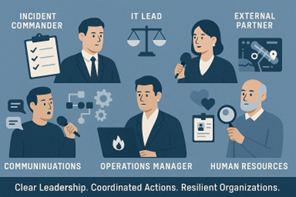
Scope: The CMT’s mandate extends beyond immediate technical fixes. It must ensure the protection of assets, the safety of people, compliance with laws, and preservation of reputation. The team’s scope covers early detection (receiving incident alerts), rapid assessment (judging severity and potential impact), activation of response protocols, coordination of resources, stakeholder communication, and the decision to escalate or de-escalate as needed. Scope also includes planning for continuity-deciding which services must remain operational, what can be temporarily suspended, and how to prioritize limited resources.
Scalability: No two crises are alike. The scale and complexity can change rapidly. A resilient CMT is designed to expand or contract as needed. For minor incidents, a small core group may suffice; in major events, additional specialists, advisors, or external partners may be brought in. Scalability requires predefined processes for onboarding new team members, delegating responsibilities, and ensuring seamless handoffs. Organizations often use “playbooks” for common scenarios, but the ability to improvise is equally critical.
Operational Principles:A resilient CMT thrives on practice, trust, and disciplined routines. Tabletop exercises and crisis simulations help the team develop muscle memory, build relationships, and surface gaps in planning or communication. After-action reviews are vital; each incident, real or simulated, is an opportunity to learn and improve. Transparency – within the team and with leadership – is essential to avoid groupthink and uncover blind spots.
Clarity of communication is paramount. In a crisis, rumours and misinformation can spread quickly, both inside and outside the organization. The CMT must coordinate messaging to employees, customers, regulators, and the public. Designating spokespersons, preparing holding statements, and using secure channels for sensitive information are best practices.
The CMT’s authority must be visible and respected across the organization. Senior leaders should publicly endorse the team’s role and decisions, reducing the temptation for others to circumvent processes or question legitimacy in the heat of the moment. Empowerment means the team can act decisively, even if senior executives are unavailable.
Integration with the Broader Organization:
A resilient CMT does not operate in isolation. It is embedded in the wider governance structure, with clear escalation paths and alignment with business continuity, risk management, and IT security. The team maintains an up-to-date contact list, knows how to reach key decision-makers at any hour, and establishes protocols for interacting with law enforcement, regulators, and partners.
Regular review and adaptation are built into the model. Changes in business structure, new regulatory requirements, or lessons from recent incidents should prompt updates to the team’s structure, membership, and playbooks.
Building a Resilient Team Culture:
Finally, resilience is as much about people as processes. The most effective CMTs cultivate psychological safety, where members feel empowered to raise concerns, question assumptions, and challenge decisions when necessary. This culture of trust and candour leads to better decisions and faster action.
When a crisis unfolds, the defining question isn’t what happened – it’s who responds. The first minutes of a disruptive event don’t just test systems or infrastructure; they test people, preparation, and leadership. If your organization doesn’t know who is in charge, who communicates, who assesses the facts, and who protects stakeholders, then the crisis itself isn’t your biggest risk – your response is. Every resilient organization has one thing in common: a well-designed crisis command model. This model is the foundation of fast, informed, and coordinated action. It doesn’t replace the rest of the business. It supports it. It enables leaders to make decisions with clarity, employees to follow trusted direction, and stakeholders to retain confidence. It’s not improvised. It’s engineered – then practiced, then trusted.
A crisis team is not a symbolic body assembled for optics. It is a functional unit with a precise mission: to preserve continuity, stabilize operations, protect people, and safeguard reputation. It must move faster than the disruption. It must interpret complexity faster than confusion spreads. It must make calls in the absence of perfect data, and it must communicate decisions without triggering chaos. None of this happens by accident. It requires structure, discipline, and rehearsal.
The architecture of a resilient command model begins with clarity of scope. The crisis team is not the IT department, the PR team, or the executive committee. It is a distinct body with authority to lead the organization’s coordinated response to a threat that disrupts or endangers critical operations, assets, or values. That threat could be a cyberattack, a supply chain failure, a regulatory breach, or a social media crisis- it doesn’t matter. What matters is that the team knows when to activate, how to activate, and what happens next.
At the centre of every command model is the core team. This team must be small, skilled, and empowered. Typically, it includes five to seven individuals with operational authority and a deep understanding of their domains. These include the designated crisis leader, a legal representative, the head of IT or cybersecurity, a senior communicator, a human resources lead, and a senior operational executive. These individuals must be available across time zones and outside of office hours. Each must have a trained alternate. Their job is not to solve everything, but to align priorities, direct actions, and keep the organization moving. Around this core sits the extended team – a flexible ring of advisors, functional leads, and technical experts brought in as needed. Their inclusion depends on the incident type. The model must adapt without losing speed.
Activation is the first point of failure – or strength. In too many cases, the team is activated too late. The breach has already spread. The media has already reported. Employees are already panicking. And the organization is still waiting for confirmation. The delay isn’t due to ignorance – it’s due to hesitation. No one wants to be the one to declare a crisis. But the most resilient organizations remove that hesitation with clear criteria and thresholds. They use a defined incident classification model. They don’t wait for certainty. They act on indicators. They know that fast containment is more valuable than slow analysis. A five-minute delay can double damage. A fifteen-minute delay can multiply recovery cost by a factor of ten.
Once activated, the team must establish a cadence. Effective teams use structured rhythms: a quick huddle every 30 minutes, a status update every 90, a full alignment call every three hours. These rhythms stabilize the team under stress. They create focus. They allow for short feedback loops and timely corrections. The crisis leader chairs these meetings – not as a dictator, but as an orchestrator. They ensure everyone is heard, decisions are logged, and actions are tracked. They know when to delegate and when to intervene. Leadership presence matters – but so does leadership behaviour. A calm composed leader can lower anxiety across an entire organization. A stressed, indecisive one will amplify confusion.
Team composition must also reflect capability, not just seniority. Crisis doesn’t care about titles. What matters is who can perform under pressure. Who has the technical knowledge, the judgment, the communication skills, the operational visibility? A seasoned mid-level leader with real crisis experience may be more valuable than a board member with none. This is why training matters. Crisis teams must not be hypothetical. They must train together, debrief together, and reflect together. Their ability to act decisively grows from shared experience, not shared email threads.
A scalable model is essential. Crises vary in intensity. A local outage should not trigger a global command structure. Nor should a regional breach be left to local improvisation. Organizations must define tiers of response. Tier 1 may be handled by department heads. Tier 2 activates a divisional crisis team. Tier 3 involves executive-level coordination. Each tier must have pre-assigned leads, clear escalation paths, and communication strategies tailored to impact. Scalability also applies across time. Some crises burn hot and fast – others smoulder. The team must adapt its posture, shifting from tactical response to strategic planning to long-term recovery without burning out or losing cohesion.
Documentation supports agility. Every team needs a crisis playbook that outlines roles, protocols, and communication flows. But a playbook alone won’t save you. If it hasn’t been opened, tested, or revised in the last twelve months, it’s a liability. Good playbooks are brief, visual, and scenario specific. They contain activation checklists, key contact data, message templates, stakeholder maps, and legal obligations. They are not manuals – they are field guides. Every member of the team should know what’s in the playbook and where to find it in 30 seconds or less.
Another key design feature is role integration. Crisis teams that function in silos are doomed to conflict and delay. The command model must integrate key functions. Communications and legal must sit together. IT and operations must share real-time data. HR must feedback employee sentiment. This is not optional. If comms doesn’t know what IT is doing, public messaging will contradict reality. If legal isn’t looped into early decisions, regulatory risks increase. If HR doesn’t know about operational impacts, workforce morale will collapse. Integration requires discipline. It requires facilitated collaboration. But it pays off when the crisis accelerates, and the pressure rises.
Crisis command must also include interfaces to the outside world. The team must know how to engage media, inform regulators, coordinate with suppliers, and reassure clients. These interfaces must be activated early – not after the first article appears or the first lawyer calls. Delays here are fatal. Public trust is not earned by perfection – it is earned by transparency, speed, and competence. A team that hides, hesitates, or contradicts itself will lose that trust – and may never get it back.
In global organizations, command models must be federated. Regional teams must have the autonomy to act quickly, but also the obligation to inform central coordination points. This requires harmonized protocols, aligned definitions, and shared principles. Time zones are not an excuse for chaos. Language differences are not a barrier to clarity. Technology helps, but only if the culture supports collaboration. If regional leads don’t trust global support – or vice versa-fragmentation is inevitable. Federated models require regular coordination outside of crisis, so that trust exists inside crisis. These structures are tested not by their complexity, but by their coherence.
Psychological safety underpins the entire model. A crisis team that punishes error, discourages challenge, or promotes blame will fail. The best teams create space for candour. They welcome dissent. They debrief honestly. They learn fast. Leaders must model vulnerability. They must admit what they don’t know. They must ask questions. The crisis doesn’t care about ego – it exposes it. Great crisis teams strip ego out of the equation. They focus on facts, people, and outcomes.
One of the greatest benefits of a strong command model is its ability to prevent escalation. When structure is clear, action is fast, and communication is aligned, many incidents never become crises. The breach is contained. The issue is explained. The public is informed. The regulator is engaged. The moment passes. That is the hidden ROI of preparedness. It’s not only about surviving disaster. It’s about avoiding it altogether – by responding well in the first place.
But when escalation does happen, the command model becomes the spine of the organization. It holds everything together. It becomes the forum where chaos is translated into clarity. Where fear is absorbed by confidence. Where paralysis is replaced with progress. And when the dust settles, it becomes the platform for learning – capturing what went wrong, what went right, and what must never be repeated.

Case Study: Building a CMT from Scratch
A fast-growing fintech startup realized, after a minor data breach, that it lacked a formal crisis management structure. The founders convened a task force, mapped out the roles described above, and recruited representatives from across the business. They ran their first tabletop exercise, uncovering confusion over authority and communication. Over the next six months, they refined their playbook, clarified responsibilities, and ran regular drills. When a major incident later hit, the team responded smoothly, containing the breach, coordinating messaging, and maintaining customer trust.

Exercise: Designing Your Crisis Management Team

Case Study – The Water Utility Breach
In a midsized European city, a ransomware attack crippled the public water utility’s digital infrastructure. The customer service portal went offline. Quality monitoring systems froze. The operations team lost visibility. But within fifteen minutes of detection, the IT lead raised the alert. Within thirty minutes, the crisis team was activated. This wasn’t luck – it was design. The organization had defined activation thresholds, rehearsed its roles, and practiced its Tier 2 structure only two months earlier.
The crisis leader, a deputy CEO, chaired the first coordination call. The legal advisor flagged notification obligations. The communications lead prepared internal and external messaging. HR updated staff. Within the hour, city officials were briefed. Backup systems were restored within 12 hours. Customers were informed promptly. No fines were issued. No trust was lost. The response was coordinated, transparent, and measured. The command model didn’t just contain the breach – it preserved the organization’s reputation.
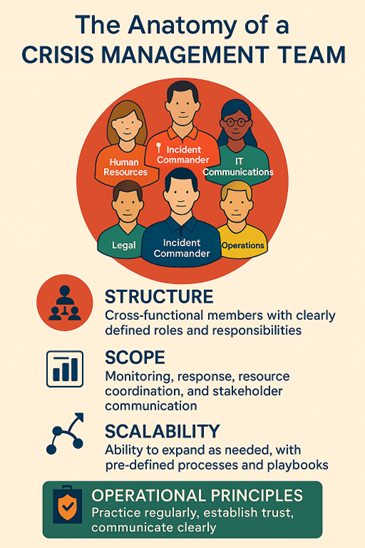

Course Manual 8: Measuring Resilience
Malware attack. The company’s global operations ground to a halt-ships could not dock or unload, offices and terminals went offline, and customers lost visibility of their shipments. Although True resilience is not just a mindset but a measurable, trackable, and improvable organizational capability. In today’s landscape of escalating digital threats and growing expectations from customers, regulators, and stakeholders, organizations can no longer treat resilience as an abstract idea. Instead, resilience must be managed as a strategic asset, with the same rigor as financial results or operational efficiency.
Key Performance Indicators, or KPIs, have become the lingua franca of modern management. In organizations striving for resilience, they play a central role in translating vision and strategy into actionable objectives and measurable outcomes. Yet KPIs are often misunderstood, reduced to mere numbers on a dashboard or quarterly report, divorced from the underlying dynamics of organizational change. To harness their true potential, leaders must appreciate the origins and philosophy of performance measurement, and the frameworks that bring clarity to complexity.
The concept of “management by objectives” traces back to Peter Drucker, who argued that effective organizations require clear goals and a shared understanding of what success looks like. Rather than relying on intuition or tradition, managers and employees work together to set targets, define deliverables, and assess progress with a critical eye. This approach represents a profound shift from hierarchical command-and-control structures, inviting employees at all levels to contribute to and own the organization’s success. In the context of resilience, management by objectives ensures that the capacity to anticipate, withstand, and recover from disruptions is not left to chance but is instead embedded in daily priorities.
KPIs are the instruments through which objectives become operational. A well-chosen KPI serves as a compass, guiding teams toward the behaviours and outcomes that matter most. However, not all indicators are created equal. Vanity metrics – such as the number of meetings held or emails sent – offer the illusion of activity without indicating genuine progress. Effective KPIs are rooted in strategy, aligned with the organization’s purpose, and sensitive to the nuances of the operating environment. They provide early warnings, illuminate blind spots, and encourage a proactive posture in the face of uncertainty.
To move beyond a scattershot approach to measurement, many organizations turn to structured frameworks such as the Balanced Scorecard. Introduced by Robert Kaplan and David Norton in the early 1990s, the Balanced Scorecard challenges organizations to view performance through multiple lenses, not just financial results. It organizes KPIs into four perspectives: financial, customer, internal processes, and learning and growth. This multidimensional approach is especially relevant to resilience, as it recognizes that robust financial health is often the product of engaged employees, efficient processes, and loyal customers – each of which can be threatened or reinforced by how an organization prepares for and responds to crises.
In practical terms, the Balanced Scorecard encourages leaders to define KPIs that reflect both leading and lagging indicators. Leading indicators signal future risks or opportunities, such as the percentage of staff who have completed crisis simulation training or the time it takes to detect and escalate incidents. Lagging indicators, by contrast, capture outcomes, such as recovery times after disruption or customer retention rates following a service outage. By balancing these types of measures, organizations develop a richer picture of their true resilience, identifying vulnerabilities before they translate into losses.
Beyond the Balanced Scorecard, other maturity models have emerged to help organizations benchmark their resilience practices. These models, such as the Capability Maturity Model Integration (CMMI) or the Resilience Maturity Model, outline progressive stages of development – from ad hoc and reactive to proactive and optimized. Each stage is defined by specific criteria, enabling organizations to assess where they stand and chart a path toward improvement. KPIs serve as milestones on this journey, clarifying which behaviours, systems, or investments are most critical at each level of maturity.
Ultimately, the power of KPIs lies not in their technical precision but in their ability to focus attention and drive action. The process of selecting, monitoring, and refining indicators becomes a catalyst for organizational learning. As teams engage in regular review cycles – discussing what the data reveals, debating root causes, and agreeing on course corrections – KPIs foster a culture of accountability and continuous improvement. When thoughtfully designed and embraced as part of a larger system of objectives and feedback, KPIs become more than measurement tools; they become engines of resilience, connecting strategy to execution and aspiration to reality.
Why Measure Resilience?
Measurement is essential for turning resilience from an aspiration into a practical reality. Without clear metrics, organizations often assume they are prepared – until a crisis exposes the gaps. Establishing meaningful measurements provides leaders with the tools to set priorities, allocate resources, track progress, and demonstrate improvement both internally and externally. Measurement brings clarity and accountability, transforming resilience from a buzzword into an achievable goal.
Approaches to Measurement
Maturity Models:
Maturity models offer a structured way to assess an organization’s current position and progress on its resilience journey. These frameworks typically outline levels from “initial” (ad hoc, reactive, undocumented) to “developed” (documented and practiced) to “optimized” (systematic, regularly reviewed, and improved). Well-known examples include the NIST Cybersecurity Framework’s Tiers and ENISA’s Resilience Maturity Model. By diagnosing their current level and targeting improvement, organizations turn intentions into action.
Key Performance Indicators (KPIs):
KPIs translate resilience goals into concrete, trackable outcomes. Relevant KPIs in resilience may include:
• Incident detection time
• Mean time to respond (MTTR)
• Frequency of crisis simulations
• Staff participation in resilience training
• Percentage of critical processes with tested continuity plans
• Stakeholder satisfaction post-incident
• Compliance with key regulations
By selecting KPIs relevant to their risk landscape, organizations move from ticking boxes to making meaningful progress.
Diagnostic Assessments:
Diagnostics – internal audits, external reviews, and scenario-based exercises – offer deeper insight. They help organizations uncover not only technical vulnerabilities, but also weaknesses in communication, leadership, and decision-making under stress. The value of diagnostics often lies as much in the learning and collaboration generated as in the score itself.
When it comes to measuring resilience – or any critical aspect of organizational performance – what you choose to measure is only part of the equation. Equally important are the how, when, and with whom of the measurement process. These dimensions determine whether your metrics become a living management tool or simply a periodic reporting exercise with little practical impact.
First, measurement must be embedded into the rhythm of the organization, not relegated to an annual review or compliance checklist. The frequency of measurement should match the pace at which risks and conditions change. For some resilience metrics, especially those tied to fast-moving risks like cybersecurity incidents or supply chain disruptions, weekly or even daily tracking may be necessary. For broader indicators, such as employee engagement in preparedness or maturity in response protocols, monthly or quarterly reviews may suffice. What matters is that the cadence of measurement supports timely decision-making, enabling leaders to detect trends, respond to anomalies, and avoid complacency.
Comparisons are also crucial. Measuring in isolation provides little insight into whether you are improving, stagnating, or falling behind. Organizations benefit from both internal and external benchmarks. Internal benchmarking involves comparing performance across departments, sites, or over time to identify pockets of excellence or persistent vulnerabilities. External benchmarking, by contrast, situates your performance in the wider industry or sector context. Are your incident response times faster or slower than peer organizations? Are your training participation rates above or below average? These comparisons not only provide motivation but also uncover best practices and potential blind spots.
The “how” of measurement extends to the integrity and transparency of the process. Metrics must be collected consistently, using standardized definitions and methodologies. Gaming the numbers-reporting only the positives or redefining success to fit existing outcomes-undermines trust and utility. Wherever possible, involve a diverse group of stakeholders in designing and interpreting metrics, ensuring that numbers are complemented by qualitative insights and frontline experience. This approach prevents “measurement myopia,” where organizations fixate on what is easy to count at the expense of what truly matters.
Finally, measurement should be dynamic and iterative. The most effective organizations treat their dashboards as living documents, regularly refining what they track as new risks emerge and strategies evolve. Feedback loops are essential: what do the numbers really mean, what actions have they prompted, and what new questions have arisen? By making measurement a participatory, adaptive process rather than a static obligation, organizations ensure that their KPIs remain relevant – and that resilience is actively managed, not just observed.

Case Study: Maersk and the Importance of Resilience Measurement
In June 2017, Maersk, the world’s largest container shipping company, was crippled by the NotPetya Maersk had invested in cybersecurity and business continuity, the attack exposed several key gaps:
Incident detection was too slow: By the time the malware was recognized, damage was done.
Backup and recovery plans were insufficient: Restoring operations required improvisation and luck – such as finding a lone unaffected server in Ghana.
Communication faltered: Employees in different regions had inconsistent information, revealing gaps in crisis communication protocols.
After the crisis, Maersk redefined how it measured and managed resilience. The company established new KPIs for detection, recovery, and communication speed, and began regular, company-wide crisis simulations. Diagnostics expanded to include independent reviews and red team exercises. Crucially, results were tracked on a central dashboard and regularly reviewed by leadership. Maersk’s transformation proved that what gets measured gets improved, and resilience became a visible business metric shared across the enterprise.
From Measurement to Action
Measuring resilience is only the first step. High-performing organizations use KPIs and diagnostics to drive real improvements, review results regularly, and keep resilience on the agenda at all levels. As threats evolve, so must measurement tools and frameworks-turning data into decisions, and lessons into action.
Culture and Leadership
Metrics alone are not enough. Culture and leadership turn numbers into progress:
• Leaders encourage open, blame-free reviews of incidents.
• Staff are rewarded for raising concerns and participating in training.
• Lessons learned are shared, not hidden.
• Measurement becomes a driver for learning and improvement, not just compliance.

Group Exercise: The Maersk Resilience Dashboard
You are Maersk’s crisis management team meeting after the NotPetya attack. Your task: agree on how to measure and communicate resilience better in the future.
Identify Two Key Gaps:
As a group, agree on the two biggest measurement gaps that worsened the crisis.
Decide on three resilience KPIs Maersk should prioritize and track company-wide.
Sketch or describe a dashboard for tracking these KPIs and agree who owns each one and how results will be shared.
Assign or volunteer for roles (e.g., CISO, CIO, Communications, Supply Chain, Audit Lead), but keep the session practical and collaborative.
Present your two main gaps, three chosen KPIs, and a simple dashboard approach to the group. Discuss briefly how you would ensure ongoing review and improvement.
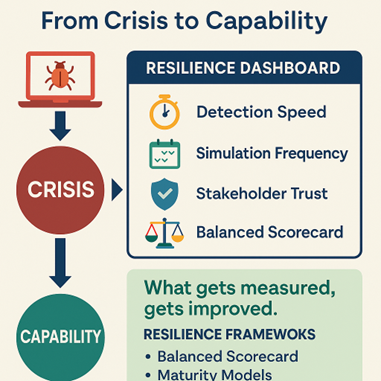

Course Manual 9: Resilience Leadership
While policies, technology, and plans form the skeleton of resilience, it is culture and leadership that provide the beating heart. The ability of an organization to anticipate, withstand, recover from, and adapt to disruption is rooted not only in its systems, but in its shared values, behaviours, and leadership example. Culture shapes how people act under stress, how they communicate, and how quickly they adapt. Leadership determines whether resilience is a daily practice or a forgotten policy.
Culture as the Bedrock of Resilience
Culture is often defined as “how things are done around here.” In resilient organizations, culture is not left to chance. It is deliberately cultivated and reinforced at every level – from the boardroom to the front lines. A resilience culture is characterized by openness, trust, accountability, and a willingness to challenge assumptions. It rewards curiosity, learning from mistakes, and raising concerns without fear of blame. People feel empowered to speak up, take initiative, and collaborate across silos.
This culture is also visible in how organizations handle bad news. In low-resilience cultures, problems are hidden, whistleblowers punished, and “shooting the messenger” is common. In high-resilience cultures, issues are surfaced early, lessons are shared widely, and transparency is valued over image management. The mantra is: “The sooner we know, the sooner we can act.”
A true resilience culture is inclusive. Diversity of thought and experience is encouraged; dissenting voices are heard and respected. In complex crises, having a team that can see the problem from multiple perspectives is a strategic advantage. Employees know that their contributions matter-and that the organization is committed to their safety and well-being.
Leadership Sets the Tone
Leadership’s influence on resilience cannot be overstated. Leaders model behaviour – by how they respond to setbacks, how they handle uncertainty, and how they communicate in difficult moments. Leaders who remain calm, transparent, and principled under pressure create psychological safety, enabling others to do the same.
Effective leaders invest in resilience before it is needed. They champion training and simulation, insist on honest after-action reviews, and ensure that resources for preparedness are never on the chopping block. They frame resilience as essential to long-term success, not a compliance obligation or box-ticking exercise.
Leaders also embody humility and a growth mindset. They admit when they do not have all the answers, seek input from others, and invite constructive challenge. This humility is a shield against overconfidence – a common cause of crisis escalation. Leaders who are willing to adapt and learn, even (or especially) after mistakes, inspire others to do the same.
Communication and Trust
Communication is the lifeblood of resilience culture. Leaders must communicate openly and frequently, especially during times of change or uncertainty. This means sharing both good news and bad, being honest about challenges, and explaining the rationale for decisions. In resilient organizations, communication is two-way: leaders listen as well as speak, and employees at all levels know that their feedback matters.
Trust – between leaders and staff, across teams, and with external partners – is the ultimate currency. Trust is built through consistency, fairness, and shared purpose. It allows for rapid mobilization in crisis and fuels the confidence needed to innovate and adapt. When trust is strong, teams move faster, information flows more freely, and mistakes are less likely to escalate.
Cultural Markers of Resilience
Learning from Failure: Incidents, near-misses, and mistakes are viewed as learning opportunities. After-action reviews are routine, and lessons are integrated into training and planning.
Preparedness as a Value: Resilience is seen as part of daily work, not a special project. Exercises, scenario planning, and risk discussions are normalized.
Responsiveness to Change: The organization adapts quickly to new information, regulatory changes, or emerging threats. Change management is proactive, not reactive.
Empowerment: Employees are trusted to make decisions in their area of expertise and escalate issues without fear.
Visible Leadership: Leaders are present, accessible, and supportive, especially in challenging times.
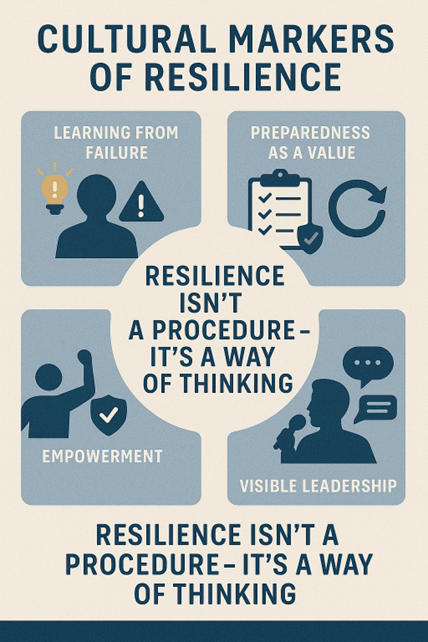
Resilience isn’t something you can install. It isn’t software. It isn’t a procedure. It isn’t a checklist item on a quarterly risk audit. It is a way of thinking, deciding, and behaving that allows an organization to absorb disruption, adapt to change, and recover under pressure without losing its purpose. And that way of thinking is rooted not in policies or technologies, but in culture. It lives in the collective assumptions, behaviours, and expectations that shape how people react to stress, how they communicate under uncertainty, and how they navigate conflict or ambiguity. Culture determines whether a team will freeze or respond, hide or disclose, fragment or align. And culture, more than any other factor, is shaped by leadership.
Leadership sets the tone-explicitly through statements and policies, but even more powerfully through daily behaviour. The most resilient organizations aren’t the ones with the most plans. They’re the ones where people know they are trusted to act. They’re the ones where staff believe they’ll be supported when they raise concerns. They’re the ones where decision-making doesn’t disappear up a chain of command but is delegated to where the facts are clearest and the action is fastest. This kind of culture isn’t created by accident. It’s cultivated through consistent leadership behaviour – modelling openness, promoting accountability, and rewarding initiative over obedience.
One of the most misunderstood aspects of resilience is the belief that it is only tested in a crisis. In reality, it is tested every day-in the way decisions are made, in how people speak to one another, in how dissent is handled, and in how leadership responds to surprise. These daily interactions form a kind of behavioural infrastructure that becomes visible when pressure hits. If the culture has been built on fear, hierarchy, and performance optics, then even a small incident can spiral into chaos. But if the culture is grounded in mutual respect, shared responsibility, and learning, even a major disruption can be navigated with confidence and agility.
Culture is shaped in moments but built in repetition. Leaders shape culture not just through speeches, but through meetings, emails, side conversations, decisions under stress, and reactions to bad news. When a team brings a problem forward, do they get thanked or questioned? When an employee makes a mistake, do they get blamed or supported? When risk is raised, is it dismissed or explored? These micro-moments accumulate. They form a pattern. And that pattern becomes the organizational norm. Leaders don’t just set the temperature. They set the thermostat – the pattern that defines what “normal” feels like.
Psychological safety is a key component of that norm. It refers to the shared belief that a team or organization is a safe space for interpersonal risk – that people can raise concerns, share doubts, offer dissenting views, and acknowledge limitations without fear of punishment or ridicule. In resilient cultures, psychological safety is not optional. It is foundational. Because when systems fail, the only thing that will keep people aligned is trust. Without it, people hide. They avoid responsibility. They delay hard conversations. They withhold bad news. And that silence kills readiness faster than any technical gap.
Trust is reinforced when leaders are present, not just visible. Presence means showing up in conversations, listening actively, admitting when you don’t know, and thanking people for telling you what’s uncomfortable. The best leaders under pressure are not those who pretend to be invulnerable. They are the ones who allow others to speak, stay grounded in facts, remain calm under scrutiny, and avoid turning uncertainty into blame. They lead by anchoring the team-not by dominating it. In crisis, this matters more than any single decision. Because a leader who builds trust creates space for everyone else to perform.
The military has long understood this. In high-pressure environments where failure is not abstract but immediate and lethal, leadership is defined not by rank alone, but by presence and clarity. Teams follow those who are consistent, grounded, and committed to shared outcomes. Tactical units perform better when commanders are physically and emotionally available – communicating intent, asking for input, and leading from beside rather than above. That principle holds in civilian organizations too. Resilient leadership is proximate. It is visible not in the media, but in meetings. Not in slogans, but in signals.
Leaders also have a role to play in building narrative. Organizations are meaning-making systems. They interpret events through stories. Stories about past crises, past leaders, moments of pride, moments of shame. In resilient cultures, those stories are curated and told with care. They include moments when the organization failed and learned. They highlight those who stepped up unexpectedly. They connect today’s risks to yesterday’s lessons. Leaders must help build that narrative – not as myth, but as memory. A team that remembers its own recovery becomes stronger with every disruption. A team that forgets its own fragility repeats the same mistakes.
One common failure point in leadership is the gap between stated values and lived behaviours. A CEO might say, “We value transparency,” but shut down uncomfortable discussions. A VP might say, “We empower teams,” but override every operational decision. A crisis lead might say, “We’re prepared,” but skip every simulation. These gaps don’t go unnoticed. Employees see the difference. And the result is cynicism. That cynicism erodes commitment – and resilience requires commitment. It requires people to care, to act, to stretch, to hold the line even when it’s hard. That kind of engagement doesn’t come from policy. It comes from trust in leadership.
Another common gap is between functions. Resilience is inherently cross-functional. It requires IT and legal, HR and communications, security and operations. But if those functions don’t trust one another-if their leaders compete instead of collaborating – then resilience collapses. Leadership must actively build bridges. That means convening cross-functional conversations. It means resolving turf wars. It means aligning incentives. And it means modelling collaboration at the top. A C-suite that functions in silos cannot expect the rest of the organization to coordinate in a crisis.
Culture also depends on systems. It’s not enough to have the right tone. You need the right scaffolding. Are simulations mandatory? Are feedback loops built into processes? Are mistakes tracked and analysed – or ignored? Are frontline teams trained – or just assumed to cope? Are post-crisis reviews honest – or performative? Systems either support culture or sabotage it. Leaders must align both. This includes aligning performance evaluations. If employees are judged only on speed, they’ll avoid complexity. If they’re judged only on perfection, they’ll hide failure. If they’re rewarded for reporting early, thinking systemically, and collaborating across boundaries – they’ll do it more.
In global organizations, culture varies by geography. What feels open in one country may feel disrespectful in another. What builds trust in one region may erode it in another. Leaders must understand that resilience is expressed differently across cultures. But the core principles remain the same: clarity, accountability, respect, and preparation. A global resilience culture must be flexible in form but firm in purpose. It must be taught, not imposed. And it must include local leadership – not just central mandates.
Technology introduces new challenges to leadership and culture. Remote teams don’t feel presence. Messages are filtered through screens. Informal signals are lost. Trust must be built more intentionally. Leaders in digital environments must overcommunicate purpose, clarify expectations, and invite feedback proactively. They must be more deliberate in how they show up, check in, and model behaviours. And they must be honest about what can be achieved through tools-and what still requires human connection.
Finally, resilience culture must be regenerative. It must not only recover from crisis-but grow because of it. This requires space for reflection. Leaders must ask: What did we learn? What surprised us? What assumptions failed? What systems helped us adapt-and what slowed us down? These questions must be part of every major debrief. They must be discussed in leadership meetings, team standups, and board reviews. Learning must be public. Only then does culture evolve.
A culture of resilience does not arise from mere declarations, policy documents, or training seminars. It emerges from the lived, daily experiences of everyone in the organization, shaped most powerfully by the tone and example set at the top. When the principle of resilience is understood, the question becomes: how can this be translated into something tangible, something that genuinely guides decisions, actions, and reactions under pressure? It is in the subtle interplay between leadership behaviour, organizational systems, and unspoken norms that resilience either flourishes or falters.
To understand where an organization stands on its journey to resilience, the process must begin with honest diagnosis. This is not about an audit in the traditional sense, but rather an exploration-using conversations, listening tours, and moments of candor to reveal what truly governs behaviour when nobody is watching. Employees are rarely deceived by posters on the wall or lofty mission statements. They recognize the real culture in the everyday stories that circulate, in how mistakes are handled, in whether speaking up is met with gratitude or avoidance. Wise leaders invest time in listening to these signals. They ask probing questions and accept uncomfortable truths, seeking to understand the gap between what is professed and what is practiced.
One of the most revealing aspects of culture is the “shadow” that leaders cast. Regardless of what is formally announced, employees tend to model the micro-behaviours, reactions, and values they observe in those above them. This shadow is especially stark in times of adversity. Does the leadership radiate calm, openness, and trust? Or do they default to control, blame, and secrecy? A leader’s instinctive response in moments of crisis becomes, for better or worse, a reference point for everyone else. The effect is often magnified in hierarchical organizations, where subordinates are acutely attuned to subtle cues-who gets praised, who is sidelined, what is swept under the rug. In these moments, the leader’s willingness to admit uncertainty, own mistakes, and model learning sends an unmistakable message: resilience is not about perfection, but about honesty and growth.
Translating values into daily practice requires much more than charismatic speeches or annual workshops. The most effective leaders use the power of narrative to anchor resilience in the organizational memory. They share stories – not just of triumph, but of setbacks, close calls, and recoveries. Through storytelling, they demystify crisis management and illustrate the human side of resilience. These stories become reference points for future challenges. Employees who hear about how curiosity once uncovered a hidden threat, or how transparency prevented a minor issue from becoming a catastrophe, are far more likely to internalize those behaviours themselves.
Yet culture is as much about the routine as it is about the dramatic. Small, consistent acts – thanking a team member for flagging a concern, openly discussing what went wrong in a project, or inviting dissenting perspectives into the room – gradually shift the organizational climate. Over time, these micro-behaviours accumulate, establishing new norms and expectations. Leaders who visibly support staff during difficult times, or who publicly recognize efforts to prepare for the unexpected, reinforce the idea that resilience is not a side project but an essential part of daily work.
One of the persistent challenges in embedding resilience into culture is the so-called “say-do” gap. Organizations may invest heavily in awareness campaigns, articulate bold visions, or set ambitious goals, only to fall short when it comes to the realities of implementation. Employees quickly detect this inconsistency. When actions do not align with words, cynicism flourishes. It is not enough to declare that psychological safety or cross-functional collaboration are priorities; these values must be reinforced through decisions about resource allocation, recognition, and, perhaps most importantly, how leaders respond when things go wrong. Genuine culture change is incremental and requires persistence. It is about celebrating small wins, learning from setbacks, and being relentless in aligning incentives with the behaviours that support resilience.
Another frequent pitfall is the tendency to mistake optimism for resilience. Leaders are often taught to project confidence, to inspire through positive messaging, and to shield their teams from worry. While a hopeful outlook can be motivating, unchecked positivity – sometimes called “toxic positivity” – can stifle honest dialogue and discourage employees from surfacing risks or admitting mistakes. Resilience requires confronting reality, even when it is uncomfortable. The organizations that weather storms best are those where bad news travels quickly, where feedback is valued, and where challenging the status quo is not seen as disloyalty but as a sign of commitment. Cultivating this level of openness demands a leadership style grounded in humility and genuine curiosity.

In organizations where hierarchy dominates, another cultural obstacle arises. Efforts to empower frontline teams may be undermined by centralized decision-making or a lingering blame culture. Employees may hesitate to act on their expertise or escalate issues for fear of reprisal. Changing this dynamic requires a concerted effort to decentralize authority and build confidence in every layer of the organization. Leaders must model trust – delegating real responsibility and supporting their teams even when mistakes occur. Empowerment, after all, is only meaningful if employees believe their decisions will be respected and backed by leadership.
For those committed to the journey, a variety of tools can help anchor resilience in culture and leadership practice. Psychological safety workshops, for example, create a safe space for teams to practice giving and receiving feedback, discussing failures, and supporting one another during uncertainty. These sessions move beyond theory, building real habits of openness and mutual support. Standardized after-action review templates ensure that lessons from incidents are systematically captured, analysed, and reintegrated into training and planning-turning every disruption into an opportunity for growth. Peer-coaching groups or “leadership resilience labs” offer leaders a forum to share challenges, test new responses, and hold each other accountable as they model new behaviours for their teams.
Sustaining culture change over time requires continuous attention and a willingness to adapt as new threats and challenges emerge. Rather than relying solely on annual surveys, forward-thinking organizations use regular pulse checks – short, frequent assessments that gauge how employees perceive progress and identify emerging issues. Leaders publicly commit to specific resilience behaviours, inviting feedback and setting an example of accountability. These commitments, coupled with visible celebrations of progress, help to normalize resilience as part of organizational life rather than a one-time initiative.
Consider the scenario of a team facing a real, high-pressure challenge: perhaps a major supplier has gone bankrupt, or a cyber incident threatens business continuity. In a traditional, siloed culture, information may be hoarded, blame may circulate, and decisions may be delayed as leaders seek to protect themselves or manage perceptions. In a resilience-oriented culture, the response is fundamentally different. Leaders surface the facts quickly, invite cross-functional collaboration, and seek input from those closest to the issue. They prioritize transparency over image, focusing first on understanding and then on decisive, coordinated action. The distinction lies not in the existence of a crisis, but in how people – guided by their leaders – choose to engage with it.
Within this framework, a practical exercise can bring these lessons to life. Imagine teams gathering to map out a current or past organizational challenge. They are invited to reflect: how would the “old” culture have responded to this situation? What behaviours, decisions, and outcomes would likely have emerged? Next, they envision the response of a resilience-focused culture. What would be different? Which specific leadership actions, communications, or policies would bridge the gap between these two realities? Through open discussion, teams surface both the obstacles and the possibilities inherent in cultural change, concluding with personal commitments to experiment with new practices in their daily work.
As the organization internalizes these lessons, the foundation of resilience becomes increasingly robust. Resilience is no longer a theoretical aspiration but a lived reality, seen in the way people collaborate, innovate, and respond to adversity. The tone set by leaders – through their words, decisions, and everyday behaviours – becomes the linchpin for everything that follows. It is through this ongoing process of reflection, experimentation, and adaptation that organizations move from aspiring to be resilient to truly embodying resilience at every level.

Case Study: Leadership in Crisis – The Financial Services Example
During a global ransomware campaign, a financial services company was targeted alongside dozens of others. The CEO, instead of hiding or minimizing the threat, immediately communicated with employees, customers, and regulators. The leadership team activated the crisis plan, delegated clear roles, and kept stakeholders updated throughout. When mistakes happened, they were acknowledged, and adjustments were made in real time. Post-crisis, the organization held an all-hands meeting to discuss what worked, what failed, and how to improve. Employee surveys later revealed an increase in trust and pride – a testament to the power of visible, honest leadership.

Exercise: Diagnosing Your Culture of Resilience
• How are mistakes or near-misses discussed?
• Are people encouraged to raise concerns?
• How is information shared across teams?
• What happens after an incident – blame or learning?
• Is preparedness built into regular routines?

Case Study – A Tale of Two CEOs
Two companies. Similar industry, similar size. Both are hit by a ransomware attack. Company A locks down communication. The CEO insists on personal control of all messaging. No one is allowed to speak to customers. Internal updates are delayed for fear of liability. Employees don’t know what’s happening. Leadership is seen – but not heard. Trust collapses. Teams disconnect. Legal obligations are missed. Regulators intervene. Reputation suffers.
Company B activates its crisis team. The CEO appears on video within three hours – calm, honest, clear. She hands operational control to the crisis lead but stays present. Staff receive hourly updates. Customer communication is approved collaboratively by legal and comms. Employees know what’s happening, even when the news isn’t good. When recovery begins, teams feel proud. The organization emerges stronger – not just because of systems, but because of culture.
The difference wasn’t size, budget, or attack vector. It was leadership behaviour – and the culture that had been built long before the breach.

Exercise – What Kind of Leadership Do You Model?
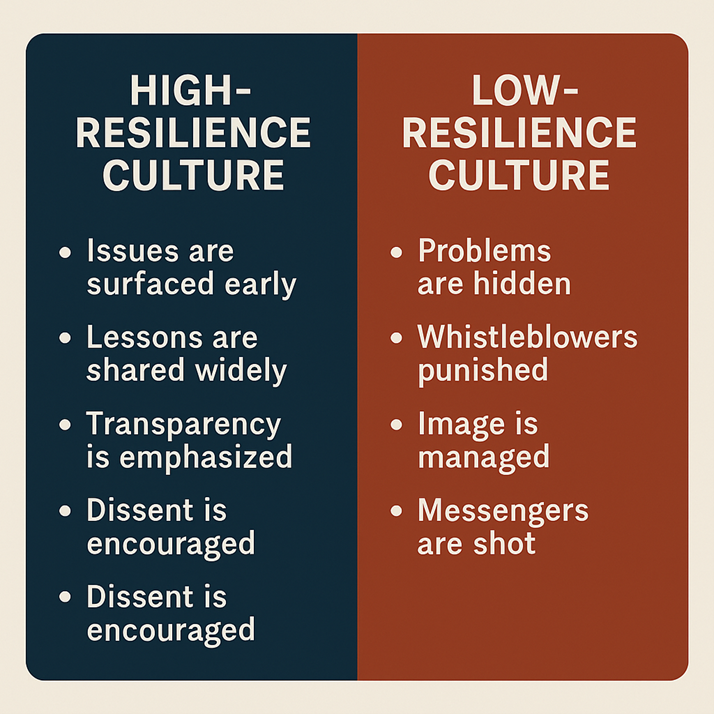
Course Manual 9: Part 2
Resilience isn’t something you can install. It isn’t software. It isn’t a procedure. It isn’t a checklist item on a quarterly risk audit. It is a way of thinking, deciding, and behaving that allows an organization to absorb disruption, adapt to change, and recover under pressure without losing its purpose. And that way of thinking is rooted not in policies or technologies, but in culture. It lives in the collective assumptions, behaviours, and expectations that shape how people react to stress, how they communicate under uncertainty, and how they navigate conflict or ambiguity. Culture determines whether a team will freeze or respond, hide or disclose, fragment or align. And culture, more than any other factor, is shaped by leadership.
Leadership sets the tone – explicitly through statements and policies, but even more powerfully through daily behaviour. The most resilient organizations aren’t the ones with the most plans. They’re the ones where people know they are trusted to act. They’re the ones where staff believe they’ll be supported when they raise concerns. They’re the ones where decision-making doesn’t disappear up a chain of command but is delegated to where the facts are clearest and the action is fastest. This kind of culture isn’t created by accident. It’s cultivated through consistent leadership behaviour – modelling openness, promoting accountability, and rewarding initiative over obedience.
One of the most misunderstood aspects of resilience is the belief that it is only tested in a crisis. In reality, it is tested every day – in the way decisions are made, in how people speak to one another, in how dissent is handled, and in how leadership responds to surprise. These daily interactions form a kind of behavioural infrastructure that becomes visible when pressure hits. If the culture has been built on fear, hierarchy, and performance optics, then even a small incident can spiral into chaos. But if the culture is grounded in mutual respect, shared responsibility, and learning, even a major disruption can be navigated with confidence and agility.
Culture is shaped in moments but built in repetition. Leaders shape culture not just through speeches, but through meetings, emails, side conversations, decisions under stress, and reactions to bad news. When a team brings a problem forward, do they get thanked or questioned? When an employee makes a mistake, do they get blamed or supported? When risk is raised, is it dismissed or explored? These micro-moments accumulate. They form a pattern. And that pattern becomes the organizational norm. Leaders don’t just set the temperature. They set the thermostat – the pattern that defines what “normal” feels like.
Psychological safety is a key component of that norm. It refers to the shared belief that a team or organization is a safe space for interpersonal risk – that people can raise concerns, share doubts, offer dissenting views, and acknowledge limitations without fear of punishment or ridicule. In resilient cultures, psychological safety is not optional. It is foundational. Because when systems fail, the only thing that will keep people aligned is trust. Without it, people hide. They avoid responsibility. They delay hard conversations. They withhold bad news. And that silence kills readiness faster than any technical gap.
Trust is reinforced when leaders are present, not just visible. Presence means showing up in conversations, listening actively, admitting when you don’t know, and thanking people for telling you what’s uncomfortable. The best leaders under pressure are not those who pretend to be invulnerable. They are the ones who allow others to speak, stay grounded in facts, remain calm under scrutiny, and avoid turning uncertainty into blame. They lead by anchoring the team – not by dominating it. In crisis, this matters more than any single decision. Because a leader who builds trust creates space for everyone else to perform.
The military has long understood this. In high-pressure environments where failure is not abstract but immediate and lethal, leadership is defined not by rank alone, but by presence and clarity. Teams follow those who are consistent, grounded, and committed to shared outcomes. Tactical units perform better when commanders are physically and emotionally available – communicating intent, asking for input, and leading from beside rather than above. That principle holds in civilian organizations too. Resilient leadership is proximate. It is visible not in the media, but in meetings. Not in slogans, but in signals.
Leaders also have a role to play in building narrative. Organizations are meaning-making systems. They interpret events through stories. Stories about past crises, past leaders, moments of pride, moments of shame. In resilient cultures, those stories are curated and told with care. They include moments when the organization failed and learned. They highlight those who stepped up unexpectedly. They connect today’s risks to yesterday’s lessons. Leaders must help build that narrative – not as myth, but as memory. A team that remembers its own recovery becomes stronger with every disruption. A team that forgets its own fragility repeats the same mistakes.
One common failure point in leadership is the gap between stated values and lived behaviours. A CEO might say, “We value transparency,” but shut down uncomfortable discussions. A VP might say, “We empower teams,” but override every operational decision. A crisis lead might say, “We’re prepared,” but skip every simulation. These gaps don’t go unnoticed. Employees see the difference. And the result is cynicism. That cynicism erodes commitment – and resilience requires commitment. It requires people to care, to act, to stretch, to hold the line even when it’s hard. That kind of engagement doesn’t come from policy. It comes from trust in leadership.
Another common gap is between functions. Resilience is inherently cross-functional. It requires IT and legal, HR and communications, security and operations. But if those functions don’t trust one another-if their leaders compete instead of collaborating – then resilience collapses. Leadership must actively build bridges. That means convening cross-functional conversations. It means resolving turf wars. It means aligning incentives. And it means modelling collaboration at the top. A C-suite that functions in silos cannot expect the rest of the organization to coordinate in a crisis.
Culture also depends on systems. It’s not enough to have the right tone. You need the right scaffolding. Are simulations mandatory? Are feedback loops built into processes? Are mistakes tracked and analysed – or ignored? Are frontline teams trained – or just assumed to cope? Are post-crisis reviews honest – or performative? Systems either support culture or sabotage it. Leaders must align both. This includes aligning performance evaluations. If employees are judged only on speed, they’ll avoid complexity. If they’re judged only on perfection, they’ll hide failure. If they’re rewarded for reporting early, thinking systemically, and collaborating across boundaries-they’ll do it more.
In global organizations, culture varies by geography. What feels open in one country may feel disrespectful in another. What builds trust in one region may erode it in another. Leaders must understand that resilience is expressed differently across cultures. But the core principles remain the same: clarity, accountability, respect, and preparation. A global resilience culture must be flexible in form but firm in purpose. It must be taught, not imposed. And it must include local leadership – not just central mandates.
Technology introduces new challenges to leadership and culture. Remote teams don’t feel presence. Messages are filtered through screens. Informal signals are lost. Trust must be built more intentionally. Leaders in digital environments must overcommunicate purpose, clarify expectations, and invite feedback proactively. They must be more deliberate in how they show up, check in, and model behaviours. And they must be honest about what can be achieved through tools – and what still requires human connection.
Finally, resilience culture must be regenerative. It must not only recover from crisis – but grow because of it. This requires space for reflection. Leaders must ask: What did we learn? What surprised us? What assumptions failed? What systems helped us adapt – and what slowed us down? These questions must be part of every major debrief. They must be discussed in leadership meetings, team standups, and board reviews. Learning must be public. Only then does culture evolve.

Case Study: Leadership in Crisis – The Financial Services Example
During a global ransomware campaign, a financial services company was targeted alongside dozens of others. The CEO, instead of hiding or minimizing the threat, immediately communicated with employees, customers, and regulators. The leadership team activated the crisis plan, delegated clear roles, and kept stakeholders updated throughout. When mistakes happened, they were acknowledged, and adjustments were made in real time. Post-crisis, the organization held an all-hands meeting to discuss what worked, what failed, and how to improve. Employee surveys later revealed an increase in trust and pride-a testament to the power of visible, honest leadership.

Exercise: Diagnosing Your Culture of Resilience
• How are mistakes or near-misses discussed?
• Are people encouraged to raise concerns?
• How is information shared across teams?
• What happens after an incident – blame or learning?
• Is preparedness built into regular routines?
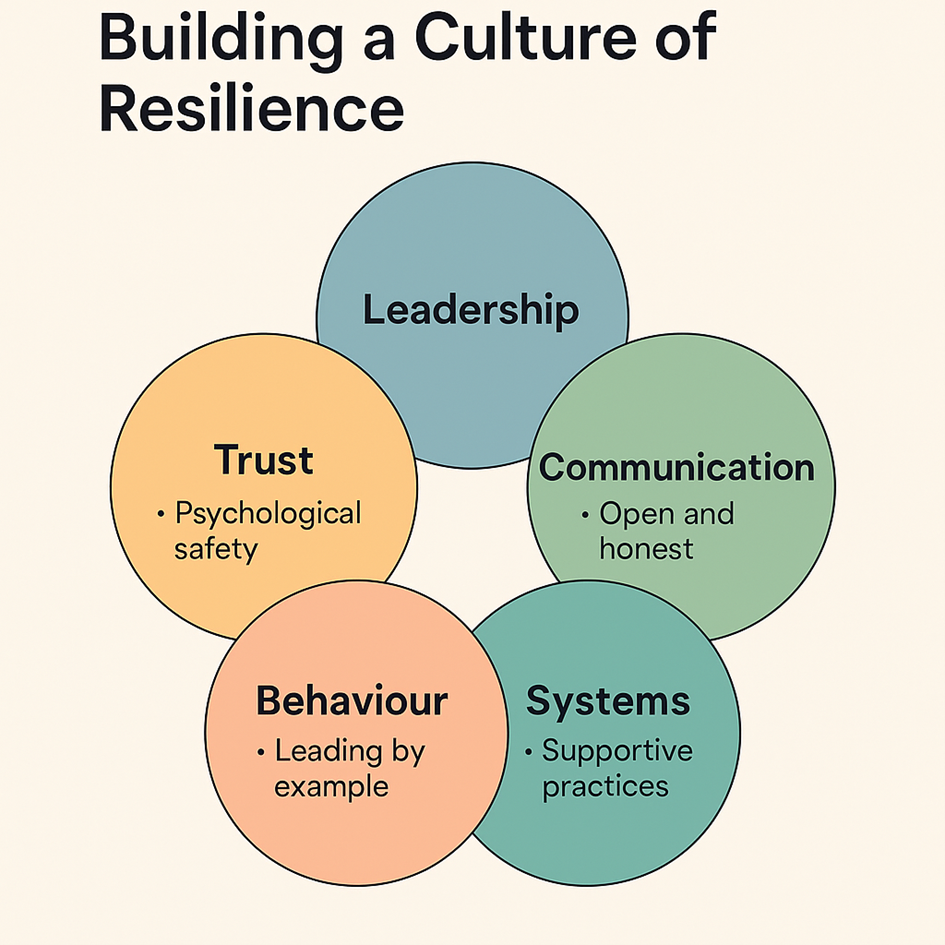

Course Manual 10: Self-Assessment
The hardest thing to see is often the thing closest to you. That’s the paradox of self-assessment. It sounds simple: figure out where you are before deciding where to go. And yet, in practice, organizations regularly underestimate their blind spots, overestimate their readiness, and misjudge their ability to respond under pressure. It’s not out of arrogance or denial. It’s because we are all wired to defend our self-image, to assume that our plans will hold, and to avoid the discomfort of admitting that we are not as prepared as we think. But in the context of resilience, this illusion becomes dangerous. Because when disruption hits – and it will – it will not ask whether we were confident. It will test whether we were ready. And readiness does not begin with strength. It begins with honesty.
Resilience is not measured only in what we build – it’s reflected in what we admit. And self-assessment is the first courageous act of leadership on the path to organizational resilience. It is the moment where a team, a department, or an entire organization decides to look in the mirror and ask not, “Are we good?” but “What aren’t we seeing?” This shift – from self-congratulation to self-inquiry – is what separates organizations that grow through disruption from those that unravel in denial. And to get there, we need more than checklists. We need curiosity, humility, and the willingness to invite discomfort as a driver of clarity.
True self-assessment requires psychological safety. People need to know that their input will not be punished, dismissed, or used against them. If they feel that saying “we’re not ready” will result in blame or budget cuts, they will hide the truth. But if leaders model openness – if they ask real questions and listen with care – people will speak. They will name the small cracks before they become fractures. They will identify the gaps that haven’t yet turned into failures. They will bring the organization’s reality into the light. But that only happens in a culture where truth is welcomed, not feared. That culture starts at the top.
When we speak of self-assessment, we are not referring to a bureaucratic risk scoring matrix or a compliance-driven audit. We are talking about a living process of discovery. It begins with questions that matter. Do we know who leads in a crisis – and are they prepared? Do our systems talk to one another, or do we rely on individual heroics? Are our plans real, or are they shelfware? Have we tested our assumptions or just documented them? What happens when one person is out of office, one vendor goes dark, one team hesitates? These are the questions that uncover resilience or reveal its absence.
There are several dimensions along which self-assessment can be explored. Structural readiness looks at whether the foundational elements of resilience are in place: plans, teams, contact trees, escalation paths, communication templates. But structure alone is not enough. Functional resilience looks at whether those structures work in practice: are they activated quickly, are the right people involved, do decisions get made, does information flow, does recovery begin without chaos. Cultural resilience examines whether people trust the system, trust each other, and trust leadership to act wisely and transparently. And behavioural resilience looks at what happens when plans collide with stress. Do people default to silence or initiative? Do they collaborate or retreat? Do they share learning or assign blame?
Blind spots often emerge in the spaces between these layers. A company might have excellent infrastructure, but no one knows how to use it under pressure. A crisis plan might exist but was written by a contractor two years ago and never opened since. A simulation might have occurred but only involved one team, on a Friday, in a safe environment with no stakes. These superficial indicators create a false sense of confidence. They lead to overconfidence bias – the psychological belief that because we’ve thought about risk, we’ve prepared for it. But preparedness is not the same as performance. And the only way to know the difference is to ask – and answer – hard questions, together.
Self-assessment works best when it becomes part of the rhythm of leadership. That means building it into annual planning cycles, quarterly reviews, and post-incident reflections. It also means conducting assessments across levels. When senior leadership believes they are ready but middle management is unclear and frontline staff are uninformed, that gap becomes the most serious threat to resilience. Multi-level assessments, anonymous pulse surveys, and facilitated conversations help close that gap. They bring divergent realities into dialogue. They align perceptions with practice.
A common trap in self-assessment is scoring too high too early. Teams want to be seen as capable. Individuals want to feel they’ve done enough. But when everyone rates themselves a four or five out of five, the conversation stops. That’s why experienced resilience facilitators often normalize underperformance. They say, “It’s okay to be at a two. It’s honest. It gives us something to work with.” In fact, some of the most mature organizations score themselves lower – not because they’re weak, but because they’ve built a culture where vulnerability is safe. They understand that the measure of resilience is not perfection – it’s progress. And progress only happens when people feel free to name what’s missing.
There’s also value in external benchmarking. Comparing your resilience practices to peers, standards, or industry norms doesn’t mean copying blindly. But it helps reframe your own story. It asks: Are we ahead or behind? Are we unique or typical? Are we satisfied-or ready to improve? Tools like the NIST framework, the ISO 22301 standard, or custom sector-specific benchmarks help calibrate the conversation. But again, the point is not to check the box. It’s to understand where the box even is.
Another powerful assessment technique is retrospective mapping. Take a past event – small or large – and walk it through. What happened first? Who noticed? Who responded? Who hesitated? When was leadership informed? What systems worked – and what systems broke? What did we learn – and what changed since then? This forensic view turns memory into muscle. It shows patterns. It uncovers fragility. And it builds confidence that next time, we’ll be better. But it only works if the story is told honestly.
Leadership vulnerability is the engine of honest assessment. When executives say, “We don’t have all the answers,” it invites participation. When they say, “We want to learn,” it creates momentum. And when they say, “We’re starting here, not there,” it makes the process real. False certainty is more dangerous than known gaps. Because known gaps can be addressed. False certainty only delays the reckoning.
This is especially important in cross-functional teams. Resilience doesn’t sit in one department. It depends on coordination between IT, HR, Communications, Legal, Risk, Security, and beyond. Each function may believe it’s doing its part. But the whole is more than the sum of its silos. A self-assessment process that brings these teams together – physically or virtually – can surface contradictions, misaligned expectations, and hidden dependencies. It turns fragmentation into collaboration. It builds the web of awareness on which resilience depends.
To illustrate how self-assessment can surface both challenge and change, we revisit the story of two hospitals. Their difference wasn’t technology. It was truth-telling.
Understanding the theory and practice of resilience is essential, but true progress begins when organizations turn the lens inward and assess their own current state. Self-assessment is not about seeking fault or blame – it is a process of honest reflection that uncovers strengths, exposes gaps, and provides a starting point for targeted improvement. In the realm of resilience, self-assessment means taking stock of preparedness, awareness, capability, and culture, so that future investment and effort are directed where they will make the greatest impact.
Why Self-Assessment Matters
Too often, organizations overestimate their readiness for disruption. It is human nature to assume that documented plans, checklists, and occasional training sessions are sufficient. Yet, as countless crises have revealed, written plans often gather dust, roles are forgotten, and critical skills fade without practice. Only by confronting reality-testing, measuring, and discussing the current state – can organizations build authentic resilience rather than false confidence.
A self-assessment also helps break the “illusion of safety” that can settle in after years without a major incident. It sparks constructive dialogue, surfaces unspoken concerns, and encourages a culture of openness. The process itself, if conducted transparently and inclusively, is a powerful signal: resilience is not a one-time project but an ongoing journey.
Components of a Resilience Self-Assessment
A meaningful self-assessment covers several key dimensions, each of which provides insight into an organization’s resilience posture.
1. Awareness and Understanding
Does everyone, from executives to frontline staff, understand what resilience means for your organization? Are the core concepts-anticipation, preparation, response, recovery, adaptation – part of daily language? Awareness is foundational: without a common understanding, efforts will be fragmented or superficial.
2. Preparedness and Planning
How well developed are your crisis management, business continuity, and incident response plans? Are these plans current, tested, and accessible? Are roles and responsibilities clear? Preparedness is not about having a thick binder on the shelf – it is about living documents, regularly rehearsed, with clear ownership.
3. Capability and Resources
Does your organization have the right people, tools, and relationships in place? Are crisis management teams cross-functional, empowered, and trained? Is there access to external expertise when needed? Are resources-time, budget, technology-allocated to resilience, or is it always “next year’s priority”?
4. Communication and Information Flow
Are reporting lines, escalation paths, and notification protocols understood and practiced? How quickly does information move in a crisis? Is there a risk of silos, confusion, or bottlenecks? Effective communication is often the difference between minor disruption and major disaster.
5. Culture and Leadership
Is there visible support for resilience from leadership? Are mistakes and near-misses used as learning opportunities? Is the culture open, collaborative, and trusting, or guarded and risk-averse? Leadership tone is the catalyst that accelerates or hinders progress.
6. Measurement and Improvement
Does the organization track resilience metrics-such as time to detect, respond, and recover? Are lessons learned from incidents embedded into future plans? Is there a process for regular review, benchmarking, and continuous improvement?
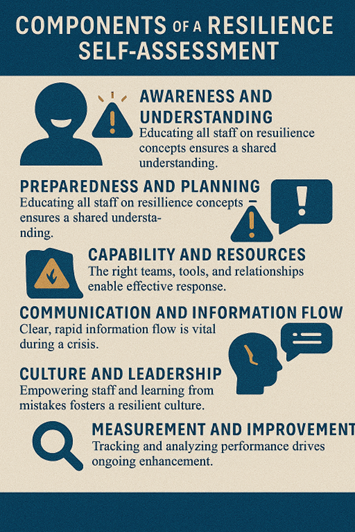
Conducting the Self-Assessment
A resilience self-assessment should be inclusive, involving voices from across the organization. Surveys, structured interviews, workshops, and tabletop exercises can all be effective. The aim is not to produce a “pass/fail” grade, but to paint a realistic picture of current state.
Honesty is critical. Participants should feel safe to share concerns or highlight weaknesses, knowing that the purpose is progress, not punishment. Where possible, external facilitators or anonymous feedback can encourage candour.
The assessment should result in a clear summary:
• Where are we strong?
• Where are we vulnerable?
• What are the biggest priorities for action?
• What quick wins are possible, and what long-term changes are needed?
The results should be communicated to all relevant stakeholders, along with next steps and a plan for regular follow-up. Transparency sustains momentum and builds trust.

Case Study – The Storm That Wasn’t a Surprise
When two hospitals in the same region lost power during a storm, one responded with clarity, the other with confusion. Six months earlier, Hospital A had run a resilience self-assessment. It was painful. Staff admitted they didn’t know how to operate backup systems. The emergency contact list was outdated. Simulation participation was low. Instead of hiding these facts, leadership leaned in. They ran three short drills. They clarified responsibilities. They created a laminated playbook for night shifts. When the storm hit, the plan activated like clockwork. Within five minutes, power returned. Patients were safe. No harm, no headlines.
Hospital B had the same assets. But their self-assessment had been surface-level. Everyone rated themselves highly. No one wanted to raise alarms. The assumption was, “We’ve done this before.” But people had changed. Systems had aged. And confidence was mistaken for competence. When the lights went out, confusion reigned. One generator failed. A critical patient was moved manually. Communication lagged. Staff morale plummeted. Recovery took days. Reputation took longer. The difference wasn’t the storm. It was the story they told themselves beforehand.

Case Study: The Awakening Audit
A global logistics firm, after several near-miss incidents, conducted its first comprehensive resilience self-assessment. While many staff believed the company was “well-prepared,” the assessment revealed gaps: outdated crisis plans, untested backup procedures, unclear communication roles, and low awareness among new hires. Leadership took the findings seriously, launching a program of updates, training, and regular simulations. Within a year, the firm responded swiftly and effectively to a major supply chain disruption-an outcome attributed directly to the improvements identified in the assessment.

Exercise: Self-Assessment in Practice
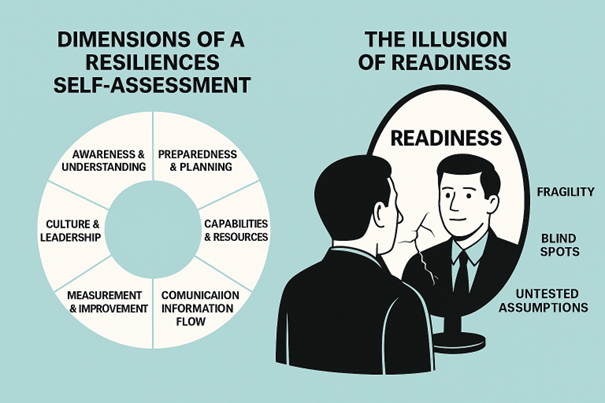

Course Manual 11: Strategic Resilience Objectives
Once an organization has held the mirror up to itself, once the blind spots and strengths are laid bare, and the myths about preparedness are replaced with clearer truths, a new question emerges – one that defines the next stage of maturity. What do we do with what we now know? This is the inflection point. Some organizations stop here. They collect their self-assessment results, nod in agreement at the gaps, maybe present a summary to leadership, and quietly resume business as usual. Others move forward with intention. They treat the moment as an opportunity to lead themselves differently. They use the momentum of awareness to design direction. That direction is what we call strategic resilience objectives – not just vague aspirations or tactical to-do lists, but meaningful, structured, and prioritized commitments that shape future capability.
Resilience is not built through general intention. It is constructed through specific focus. Focus is what allows an organization to coordinate action, align leadership, communicate clearly, and measure progress. But focus doesn’t emerge on its own. It must be defined. And that definition takes the form of a small number of strategic objectives that reflect both the reality of the current state and the demands of the future environment. These objectives are not invented – hey are discovered. They are distilled from the pain points revealed in assessment, the patterns exposed in past disruptions, the risks mapped in planning sessions, and the conversations that occur across functions, levels, and silos. They are sharpened by leadership. And they are carried forward through consistent, visible sponsorship.
A strategic objective is not an idea. It is a design. It clarifies what needs to change, why it matters, how success will be tracked, and who owns the process. The most effective resilience objectives are those that meet four criteria: relevance, clarity, measurability, and traction. Relevance means the objective connects directly to real-world threats, observed weaknesses, or known gaps. Clarity means it is written in language that is understandable across the organization – not just in specialist terms. Measurability means that it includes a way to track progress – whether through time, frequency, quality, or engagement. Traction means it has visible ownership and integration into daily operations, not isolated within a task force or document.
In practice, strategic objectives might look like this: Ensure all critical business units conduct a live incident simulation once per quarter with documented feedback. Or: Define, document, and train a cross-functional crisis response structure by the end of Q2, including three named backups per function. Or: Embed resilience performance indicators in executive dashboards, including average response time, decision-making lag, stakeholder communication latency, and employee trust scores during drills. These are not vague ambitions. They are operationally grounded. They signal commitment. And they create the conditions for meaningful improvement.
Equally important are the guiding principles that accompany them. Strategic objectives tell us what to do. Guiding principles tell us how to do it – and more importantly, how to make decisions when conditions shift. Because no matter how well-crafted an objective may be, it will meet friction. Unexpected constraints, new risks, team changes, or cultural resistance may surface. Principles hold the line when plans bend. They articulate what the organization stands for when pressure tests its systems and its values. Principles like “Clarity over control,” “Collaboration before escalation,” or “Decisions owned where knowledge lives” help shape response behaviour. They become anchors during turbulence.
To embed these principles into the organization, they must be more than decorative. They must be repeated, referenced, embedded into leadership messages, included in after-action reviews, and modelled in behaviour. When executives use these principles to explain decisions, they become alive. When teams use them in meetings, simulations, and real-world responses, they become cultural. Without principles, objectives can drift. With them, direction gains resilience of its own.
The challenge for many organizations is not a lack of ideas – it’s an excess of them. A robust assessment often reveals more issues than can reasonably be addressed at once. So, the discipline of prioritization becomes central. This is not just about sorting a list. It’s about understanding leverage. What investments will reduce the most vulnerability? What improvements will unlock broader systemic shifts? What actions will build momentum and confidence? For example, establishing a regular simulation cycle can enhance readiness, expose other weaknesses, and build leadership muscle – making it a high-leverage objective. Likewise, clarifying communication roles and escalation protocols can reduce confusion in multiple scenarios, improving performance across disruptions.
Prioritization is also emotional. Teams often carry scars from past incidents – moments where things went wrong, people were blamed, trust was broken, or performance faltered. Strategic objectives must acknowledge this. They must rebuild trust through transparent prioritization. That means involving the right voices, listening to feedback, and avoiding top-down mandates that ignore lived experience. A prioritization process that includes multiple functions, geographies, and levels will produce better direction – and more ownership.
In organizations with multiple business units, geographies, or maturity levels, objectives must be tailored without losing coherence. One approach is to define enterprise-wide resilience themes (e.g., “Improve leadership visibility in crisis,” “Enhance internal communication speed”) and then allow units to localize their objectives within that theme. This provides consistency without uniformity. It respects context while building enterprise resilience muscle.
Let’s also address time horizons. Not all objectives can or should be completed in a quarter. Some are foundational and long-term. Others are quick wins designed to shift energy and show progress. A balanced portfolio of resilience objectives includes both. A three-year objective to embed resilience into procurement, for example, may be broken down into annual and quarterly milestones: Year 1 focuses on supplier risk scoring and contracts; Year 2 on audits and alternative sourcing; Year 3 on collaborative simulation with vendors. Each step builds toward something larger. This pacing matters. Resilience is not a sprint – it is an organizational conditioning program.
To be effective, objectives must be tracked. This means clear indicators – quantitative or qualitative – that provide insight into progress. Some metrics are operational: response time, system recovery duration, communication engagement rate, simulation participation. Others are cultural: employee confidence, leadership visibility, post-event learning application. Some are behavioural: time to escalation, decision-making clarity, hesitation under pressure. Tracking these indicators creates feedback loops. And feedback loops create a culture of learning and accountability.
This leads us to accountability itself. Every resilience objective must have an owner. Ownership means someone is responsible not just for completing tasks, but for shepherding progress, resolving obstacles, and communicating status. Ownership also creates clarity. When things stall, there’s a point of contact. When results improve, there’s recognition. In highly resilient organizations, ownership is distributed – but not diluted. It is supported by leadership, resourced appropriately, and reviewed consistently.

To see how all of this plays out, consider the following scenario – an expanded version of a real-world case where assessment was only the beginning.

Case Study – From Wake-Up Call to Strategic Discipline
A regional logistics firm with operations in six countries experienced a targeted cyberattack. Operations slowed, client SLAs were breached, and internal confidence wavered. The crisis revealed three major gaps: unclear crisis team roles, inconsistent communication protocols across regions, and a leadership team unsure of how to coordinate under pressure. A post-incident review was conducted, followed by a full resilience self-assessment facilitated externally.
The leadership team agreed: this could not happen again. But instead of rushing into fragmented improvements, they paused. A task force was established to design three strategic objectives to guide resilience development over the next 18 months. After four weeks of workshops, interviews, and data review, they agreed on the following:
Objective 1: Define and train a regional crisis management structure with named alternates and functional escalation trees, to be rehearsed semi-annually. Objective 2: Launch an internal resilience communication initiative – monthly newsletters, scenario role cards, and an open Q&A portal – to improve transparency and alignment across locations. Objective 3: Integrate a resilience performance dashboard into executive meetings, showing simulation readiness, time-to-response metrics, and employee perception scores.
Each objective was linked to guiding principles. For example, the first was supported by “Decisions move to the closest knowledge.” The second by “Communication creates confidence.” The third by “We learn out loud.” These were not just taglines – they were used by regional heads, included in onboarding, and referenced in incident updates.
The company’s board approved dedicated budget and assigned senior sponsors to each objective. Within 12 months, simulations had improved both speed and coordination. Teams spoke a new shared language. Engagement grew. The incident that began as a disruption ended up catalysing cultural clarity.
Once an organization has assessed its current level of resilience, the next step is to set clear, strategic objectives for improvement. This process is about turning insight into action-moving from awareness of gaps and vulnerabilities to a proactive, prioritized agenda for building resilience in the months and years ahead. Setting the right objectives is foundational to making resilience a living part of the organizational mission, rather than an abstract ideal.
Why Strategic Objectives Matter
Strategic objectives are the roadmap that guides an organization from its current state to its desired future. Without them, efforts to improve resilience can become scattered, reactive, or lost amid other business pressures. With well-chosen objectives, leaders can allocate resources effectively, track progress, and rally teams around a shared sense of purpose.
Objectives also communicate to stakeholders-employees, customers, regulators, partners-that resilience is a genuine priority, not a “nice to have.” When resilience objectives are included in annual plans, executive scorecards, and team KPIs, they become woven into the fabric of daily work.
Translating Assessment into Objectives
The starting point is the self-assessment: Where are the biggest risks? What are the critical weaknesses, and what strengths can be leveraged? Strategic objectives should be tailored to address these findings, balanced between immediate “quick wins” and longer-term, structural improvements.
Common target areas include:
• Updating and testing crisis management and business continuity plans
• Building or strengthening the crisis management team
• Improving incident detection, response, and recovery capabilities
• Investing in awareness training and a resilience-focused culture
• Enhancing communication protocols and escalation procedures
• Formalizing relationships with external partners and suppliers
• Benchmarking against industry standards (such as NIS2, ISO, or NIST frameworks)
• Developing metrics and dashboards for ongoing measurement and review
Each objective should be specific, measurable, and time-bound-clear enough that progress can be tracked and accountability assigned.
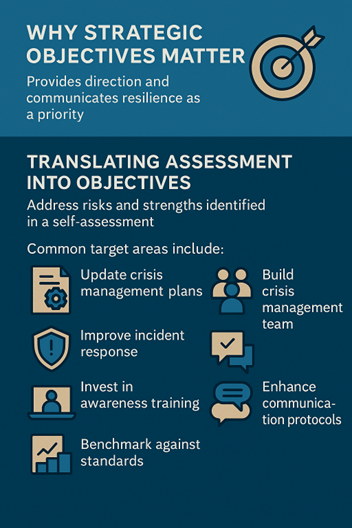
Guiding Principles for Setting Objectives
Setting objectives is not a bureaucratic exercise. It requires leadership, vision, and a willingness to challenge the status quo. The following guiding principles help ensure that resilience objectives are meaningful and effective:
Align with Organizational Mission: Resilience is not a standalone program. Objectives must support and enhance the core mission and values of the organization. For example, a healthcare provider’s objectives might prioritize patient safety, while a logistics company might focus on supply chain continuity.
Engage Stakeholders: The process should include input from across the business – not just IT or compliance. Engaging a diverse set of voices ensures objectives are relevant, practical, and widely supported.
Balance Ambition and Realism: While it is important to aim high, objectives must also be achievable given current resources and constraints. Early wins build momentum for more ambitious change.
Focus on Continuous Improvement: Objectives should not be fixed forever. As the risk landscape evolves, so too must the organization’s priorities. A culture of regular review, adaptation, and learning is central to resilience.
Communicate and Celebrate Progress: Objectives should be shared openly. As milestones are achieved, leaders should communicate successes and lessons learned, reinforcing the importance of resilience and motivating ongoing effort.

Case Study: Strategic Objectives in Action – The Mid-Sized Manufacturer
After a series of supply chain disruptions and a near-miss cyber incident, a mid-sized manufacturer undertook a comprehensive self-assessment. The process surfaced critical gaps: fragmented response plans, unclear escalation paths, and low employee awareness. The executive team set three strategic resilience objectives for the year ahead:
Develop, document, and test a unified crisis management plan across all business units
Launch a company-wide resilience awareness and training program, including regular tabletop exercises
Implement a quarterly review and reporting process for resilience KPIs, with progress presented to the board
Each objective was assigned an executive sponsor, given budget and resources, and tracked monthly. The company quickly saw improvements in response times, cross-team coordination, and employee confidence.

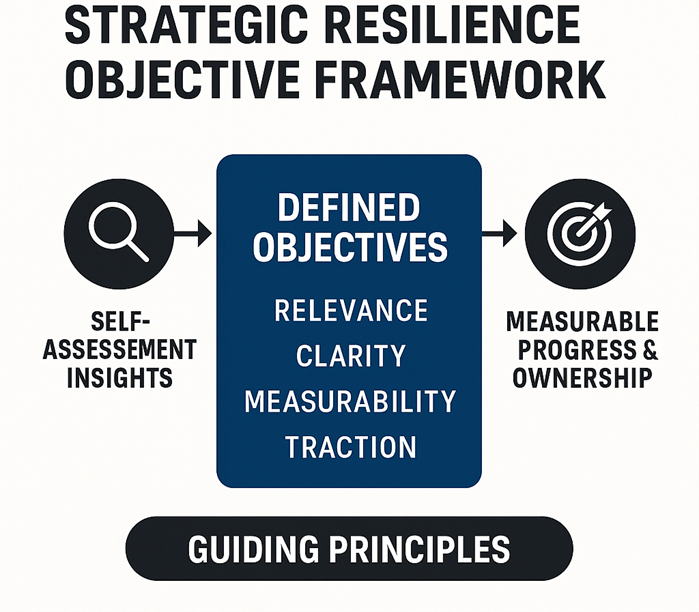

Course Manual 12: Synthesis & Expectations
Reaching the conclusion of the first workshop day is not the end, but the beginning of a year-long journey toward true organizational resilience. Synthesis is about weaving together the strands of learning, self-awareness, strategy, and action into a coherent roadmap that will guide all future efforts. Orientation, meanwhile, is about establishing clear expectations, fostering engagement, and building the momentum necessary for sustained transformation.
The Value of Synthesis
After exploring the concepts of resilience, mapping the resilience cycle, understanding the difference between cybersecurity and resilience, learning from case studies like Sony Pictures, and assessing your own readiness, it is critical to step back and see how the pieces fit together. Synthesis helps turn discrete lessons into a connected story – one that gives meaning to the work ahead and allows teams to see progress, not just problems.
Through synthesis, teams clarify not just what resilience means, but what it means here, for your organization, in your context. It encourages a holistic view: resilience is not only about cybersecurity or business continuity, but also about leadership, culture, structure, metrics, and proactive learning. Every piece matter – and every piece depends on the others.
Orientation for the Year Ahead
Orientation sets the tone for sustained improvement. It is an invitation for participants to own the process, contribute ideas, and commit to real progress. Effective orientation achieves several goals:
Connects the Dots: Reviewing key insights from each course manual, showing how foundational definitions, practical exercises, and case studies create a logical progression toward resilience maturity.
Establishes Expectations: Clearly lays out the format, objectives, and cadence for the workshop series. Participants understand the process: regular sessions, case-based learning, exercises, and action planning.
Assigns Roles: Clarifies who is responsible for what – within the workshop and in the organization. Leadership support is visible, but every participant has a role in driving change.
Builds Engagement: Uses early wins, small group work, and open dialogue to build trust and enthusiasm for the journey.
Creates Accountability: Outlines how progress will be measured, shared, and celebrated. Sets the expectation for regular follow-up, transparent reporting, and honest review.
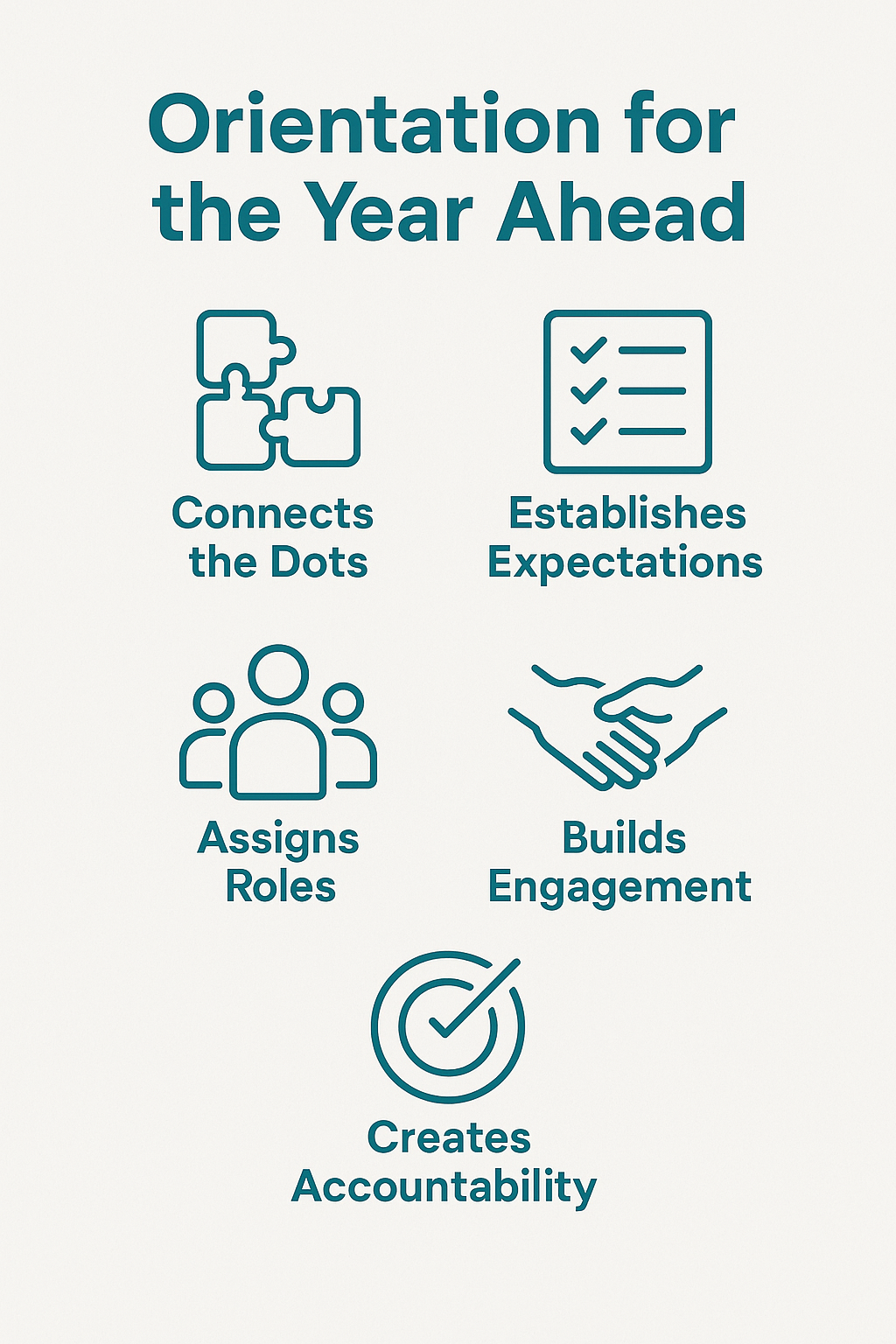

Case Study: The Year of Resilience Transformation
A global engineering firm, after a rocky response to a series of incidents, launched a year-long resilience initiative based on a similar workshop approach. In the first session, participants mapped the connections between cyber risks, business continuity, leadership, and culture. A shared roadmap was developed, with each quarter focusing on a specific theme (e.g., crisis management team drills, measurement and KPIs, cultural change, supply chain resilience). Regular check-ins and open forums kept momentum strong. By year’s end, the firm had not only improved its technical resilience but fostered a new level of trust, cross-functional teamwork, and leadership engagement.

Group Exercise: Designing Your Roadmap

Case Study – One Charter, Many Voices
At the end of their first resilience workshop, a cross-industry task force of senior managers, compliance officers, security leads, and communicators gathered in a shared room. They had worked through systems mapping, scenario games, communication drills, and self-assessment over the course of several days. Each person had their own notes, their own insights, their own action points. But something was still missing. There was no shared anchor. No sentence that captured what they now believed together.
Their facilitator gave them one prompt: “What are you all willing to say out loud and commit to, in the face of the next disruption?” The room fell silent. Then, slowly, someone said, “That we will not delay difficult decisions.” Another said, “That we will tell the truth early, even when it’s messy.” A third: “That we will ask for help before the system breaks.” And then, the charter began to write itself. Not by vote. Not by design. But by recognition. The phrases on the flipchart became something more than text. They became mirrors.
The charter was printed and shared not as a policy-but as a promise. Six months later, the organization faced a real incident. The network was breached through a vulnerable third-party tool. The systems kicked in-but more importantly, so did the people. They didn’t wait. They didn’t blame. They didn’t cover. They acted. They followed their own voice. And recovery began.
To help bring this into focus, let’s step into one final case study. A story not about breakdown – but about integration. A moment when a group saw the full picture and decided to carry it forward.

Exercise – Shared Compass: Building Our Resilience Charter
Each participant is given a prompt card with the following three questions:
– What is one thing I learned about resilience that changed the way I think?
– What is one commitment I am ready to make to my team?
– What is one phrase I would want to see in our shared charter?
The group forms a circle. Each participant is invited to share one of their answers aloud – whichever feels most important. The only instruction is to listen deeply and take note of recurring language or emotion. This is not a discussion. It is a chorus. Everyone’s voice belongs.
Using a whiteboard, screen, or flipchart, the facilitator asks: “Based on what we’ve heard, what words or commitments do we want to carry with us?” The group suggests phrases. Recording them as short, clear, powerful sentences. Usually, five to eight statements emerge. No jargon. No negotiation. Just clarity.
– We act early, not perfectly.
– We trust the process more than the plan.
– We prepare as a team, not in silos.
– We learn aloud, not in silence.
– We make resilience visible.
One reads the charter aloud. Slowly. Deliberately. Then they ask: “When the next disruption comes, what kind of team do you want to be? This charter is not a guarantee – but it is a guide. And it begins now.”
Looking Ahead
Resilience is not a destination, but an ongoing process of improvement and adaptation. By synthesizing learning, orienting the group, and setting a collaborative roadmap, organizations build the foundation for real change. The journey ahead will require discipline, curiosity, and courage – but it also offers the reward of stronger teams, greater agility, and enduring success, no matter what the future holds.
Resilience is not a result. It is a relationship – between what we fear and what we prepare for, between what we can control and what we must adapt to, between who we think we are and how we act under pressure. Over the course of the first eleven modules, we have walked through frameworks, functions, models, mindsets, strategies, and scenarios. But now, we arrive at a different kind of moment. Not a step forward, but a pause. Not another concept, but a convergence. This module is about reflection and direction. It is about asking, together: What have we learned – not only about resilience, but about ourselves? And what will we do with it?
The end of this first workshop is not the end of anything. It is a transition. It is a moment of synthesis, where we take all of the separate parts and begin to see the shape of the whole. Because real resilience is never built through isolated insights. It is built through connection-connection between people, between departments, between patterns and principles. In crisis, we never act alone. The success of any organization under stress depends not on individual brilliance, but on collective coordination. It depends not on one hero, but on many quiet acts of readiness. And it depends, most of all, on a shared understanding of why we do what we do, how we do it, and who we are in moments of difficulty.
We began this journey by defining resilience – moving beyond vague references to robustness or bouncing back, and grounding our understanding in systems, behaviours, and mission continuity. We looked at the resilience cycle not as an abstract model but as a practical rhythm – a way to move from anticipation to adaptation to recovery without losing orientation. We distinguished between cybersecurity and cyber resilience, not to discredit technical controls, but to reinforce that technical readiness is only part of the picture. Then we examined the anatomy of a crisis. We stopped pretending disruptions arrive with notice, and started acknowledging how quickly they escalate, how slowly decisions sometimes emerge, and how much clarity matters in the fog of uncertainty.
We explored the origins of resilience – not to dwell on history, but to reclaim a legacy of thinking that connects war rooms, ecosystems, urban planning, psychology, and corporate leadership. From the battlefield to the boardroom, the principles of resilience remain the same: decentralize intelligently, train realistically, rehearse frequently, and lead with calm. We moved through the structural side – governance, roles, escalation paths and the cultural side – tone from the top, psychological safety, behavioural alignment. We mapped resilience as something both measurable and intangible, both data-driven and emotionally rooted. And we asked hard questions about ourselves. We assessed our current state, not to self-flagellate, but to face reality with courage. We translated that reality into action, by setting strategic objectives – not many, but enough. Enough to move, enough to align, enough to grow.
And now, at this point of synthesis, the challenge is to hold it all. To see the arc. To understand that each module was not a lesson, but a layer. That each conversation was not an answer, but an activation. That each exercise was not a task, but a rehearsal. We are no longer speaking of resilience in the abstract. We are building it in real time. And like any real capability, it must be practiced, tested, stretched, reinforced, and re-anchored through experience. That is what the rest of the year will bring.
This workshop is only the beginning. But it is a critical beginning. Because it resets expectations. It introduces language. It initiates accountability. And it builds something no framework alone can build: belief. Belief in the possibility of leading through disruption, not just surviving it. Belief in one another. Belief in the team. Belief in the value of slowing down now in order to move faster later. That belief must now carry us forward.
So where are we going? Over the next year, we will explore twelve dimensions of resilience in greater depth. These include leadership decision-making, scenario mapping, stress testing, stakeholder communication, digital continuity, operational recovery, regulatory navigation, internal messaging, and more. But we will not treat them as twelve isolated themes. We will treat them as twelve lenses on the same question: What does it take to remain functional, trusted, and adaptive when everything around you is moving faster than your plans?
These are not rhetorical questions. They are the seeds of culture. And culture is the ground resilience grows in. The most resilient teams are not those with the best processes. They are the ones where people speak up early, collaborate widely, act calmly, and recover together. This kind of team is not built through slogans. It is built through shared memory. And memory begins with reflection.
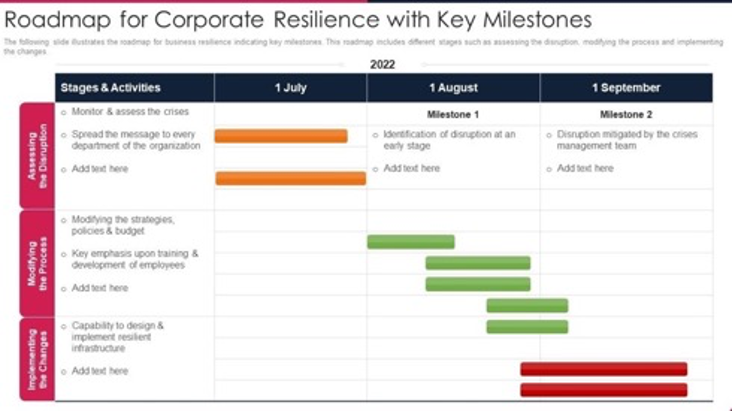
Project Studies
Crisis Anatomy (4)
Exercise – Mapping Your Resilience Lineage
This workshop exercise is designed to help participants trace how their organization has developed (or neglected) resilience over time. It takes 30 minutes.
Each participant creates a timeline of major organizational disruptions-these might include leadership transitions, system failures, public incidents, regulatory investigations, global events like COVID-19, or industry-specific shocks. For each moment, they note: What happened? How did the organization respond? What was done well? What was learned?
In small groups, participants compare timelines. They look for patterns. Did the organization become stronger after disruption-or weaker? Did lessons lead to new behaviours, or fade over time? Are the same mistakes repeated? Are some areas (IT, HR, PR) more resilient than others?
The session ends with a reflective prompt: What is your organization’s resilience culture rooted in – preparation, improvisation, or avoidance? And what legacy do you want to leave for those who come next?
Organizational Structure (6)
Exercise – Building Your Crisis Structure
In this 30-minute session, participants first sketch their organization’s crisis architecture. Who leads, who decides, who informs, who supports. Then, in pairs or trios, they critique each other’s maps. Where are roles clear? Where are escalation paths broken? Who is missing from the table?
Facilitators guide reflection on structural blind spots: Are backups named and briefed? Are communications functions integrated or isolated? Are IT, legal, and HR coordinated – or siloed? What would happen if the crisis started on a Friday evening?
Invitation:
Choose one part of your structure to stress-test this quarter. Clarity is not created in a crisis. It is rehearsed.
Resilient Command Model (7)
Exercise – Designing Your Crisis Team
In this 30-minute exercise, participants assess the readiness of their organization’s crisis team structure. Step one: each person writes down who they believe would be involved in responding to a major disruption – name by name, not by title. Step two: they note whether these individuals are trained, available, and authorized to act. Step three: participants group into trios and compare notes. Where is there alignment? Where is there confusion? Do different departments imagine different teams? Are the same people always relied upon?
Facilitators then guide a dialogue around key design principles: Are roles defined by skill or title? Are backups named? Has this team trained together? Can the team scale up or down depending on the situation? Are communication roles clear? Is the team inclusive of key perspectives – HR, legal, communications, cybersecurity?
What is one action you will take in the next month to strengthen your team’s structure, readiness, or rhythm? Building a resilient command model begins with asking better questions. Leading through crisis begins with designing for clarity.
Self Assessment (10)
Exercise – Where Are You Now?
In this guided session, participants begin their own self-assessment journey. The exercise has three phases. Phase one is personal scoring. Each participant receives a one-page resilience self-check, with ten statements rated red, yellow, or green. These statements span areas such as leadership clarity, plan activation, communication protocols, cross-functional trust, and cultural safety. The goal is not to achieve high scores – it’s to spark insight.
Phase two is group reflection. Participants join in trios to compare responses. They look for variation. Where did we score differently? Why? What assumptions are we carrying? What evidence supports our confidence – or challenges it? The conversation should be exploratory, not defensive. It’s a chance to learn from difference, not erase it.
Phase three is priority setting. Each group selects one red and one yellow area to improve. They write down a one-sentence insight and a one-step action. These are shared with the full group to build collective awareness.
“Resilience doesn’t begin with answers. It begins with questions. This exercise isn’t about being right. It’s about being real. And what you do with these insights will shape what happens when it matters most.”
Strategic Resilience Objectives (11)
Exercise – From Insight to Intention
In this exercise, participants move from awareness to strategy. Step one: each person identifies two key findings from their recent assessment. These could be personal observations, team-level gaps, or systemic issues. Then, for each, they write one possible strategic objective. What would success look like in six months?
Step two: in groups of three, participants share and refine their objectives. They provide feedback: is the goal actionable, meaningful, and connected to real resilience? Groups also create a guiding principle for their favourite objective – what belief or value should shape how that goal is pursued?
Step three: one person from each group shares their principle and objective with the full room. The group discusses patterns, overlaps, and surprising insights. What are we collectively prioritizing? What tensions are emerging? What excites us?
“Resilience begins with reflection – but it grows through direction. The goals you set now, and the principles you follow in reaching them, will shape not only how you recover from disruption – but how you lead into the future.”
Synthesis and Expectations (12)
Exercise: Setting Your Own Resilience Objectives
Participants review their organization’s self-assessment results and, in small groups, identify three strategic objectives for improving resilience in the coming year. Each objective must be specific, measurable, and linked to a critical business risk or opportunity. Groups outline actions, assign responsibility, and propose milestones for tracking progress. Each group presents their plan, receiving feedback from peers and the facilitator.
The exercise emphasizes that setting objectives is a collaborative, practical process – one that brings resilience to life across the organization.
Program Benefits
Management
- Strategic approach
- Cost Savings
- Business Continuity
- Risk Management
- Reputation Protection
- Clear Responsibilities
- Crisis Preparation
- Competitive Advantage
- Playbook development
- Process Transparency
Human Resources
- Employee Awareness
- Efficient communication
- Set Responsibilities
- Threat Awareness
- Reduce fluctuation
- Better contracts
- Less Stress
- Secure workstation
- Stable organization
- Easy understanding
Legal
- Regulatory Compliance
- Risk Mitigation
- Security Management
- Framework knowledge
- Correct communication
- Temporal conditions
- Legal conditions
- Broadening the perspective
- Management Cooperation
- Focus Areas
Client Telephone Conference (CTC)
If you have any questions or if you would like to arrange a Client Telephone Conference (CTC) to discuss this particular Unique Consulting Service Proposition (UCSP) in more detail, please CLICK HERE.
